

Tidewater Times July 2025



St. Michaels
Located
























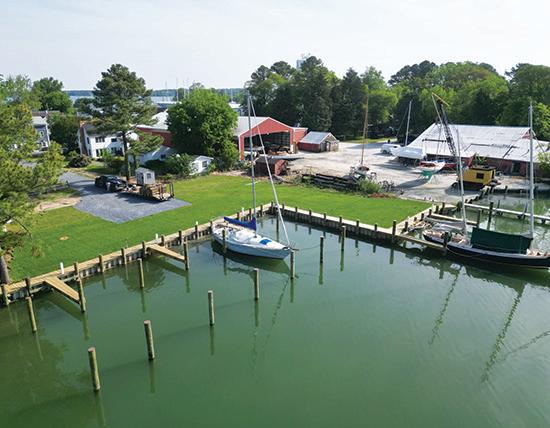







About the Cover Artist Laura Era
Laura Era is an award-winning professional portrait and landscape artist and teacher. She is also the owner of the Troika Gallery in Easton, Maryland.
Her passion for portraiture has earned her recognition far and wide, with noted institutions commissioning her work. Encouraged and taught by her mother, renowned portrait artist Dorothy F. Newland, Laura studied with Daniel E. Greene, Burton Silverman and Raoul Middleman. She continues to paint on location each year with visits to England, France, Portugal, Germany, Lewes, Delaware and Monhegan, Maine. Her formal and informal portraits are much admired, and she is fond of painting people of all ages, even favorite pets.
Laura has painted multitudes of portraits over the decades and believes that each painting should have a distinct personality, drama and feeling while still capturing the true essence of the subject. Clients often return to her with requests for additional commissions. Her commissioned portraits hang in the University of Maryland School
of Medicine, Salisbury University, Maryland State Offices and numerous private homes. Her still-life and landscape paintings are also widely collected. Laura teaches from her studio on the Little Choptank River near Cambridge and has devoted students who seek out her mastery.
This month’s cover photo is a commissioned 12” x 9” oil on linen piece titled Beach Breeze.
To see more of her work, please visit www.troikagallery.com or www.lauraera.com .


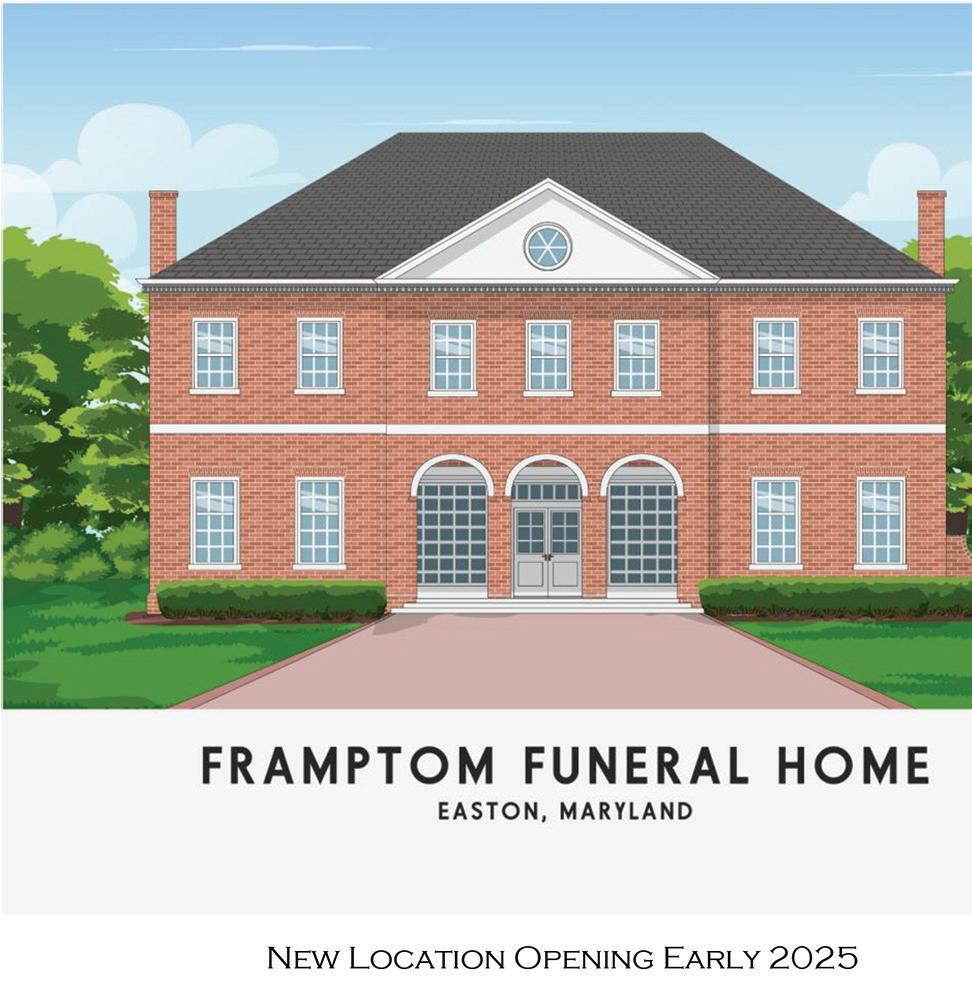
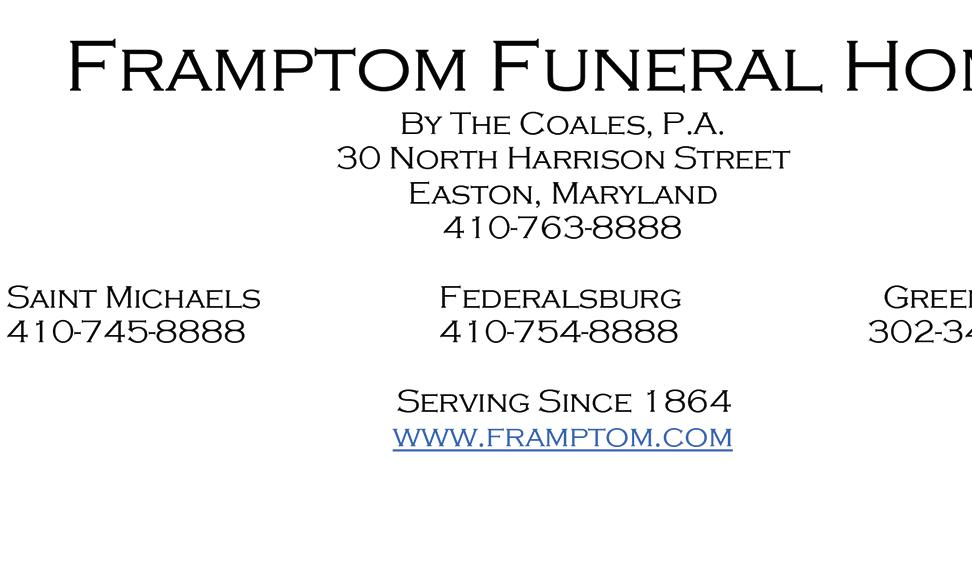
Old Wives and their Tales
by Helen Chappell
When it rained and the sun was shining, my mother would look up at the sky and say, “The devil is beating his wife.” She wasn’t entirely serious, but even as a kid, I could hear the faintest bat squeak of belief in her voice. Her mother told her that, and doubtless her mother’s mother had told her, and somewhere down along the line, someone actually believed that old wives’ tale. Recently, my friend Howard told me his grandmother told him if he stuck a pin in the ground, he would actually be able to hear the unholy domestic violence!
While I’m not quite an old wife myself, I’ve heard these aphorisms all my life, and they’ve been a
source of fascination to me as long as I can remember. Most of them, as you’ll read, are fairly harmless, but in my travels, I’ve met people who actually believed this stuff as gospel truth.
Take Earlene, a girl I went to middle school with. Earlene’s family migrated up here from Appalachia, carrying with them a whole bag of stuff she believed in adamantly. Holding sway in the girls’ room in middle school, her oracular pronunciations were pretty spectacular. I wish I could remember them all, because Earlene had an old wives’ take for every occasion.
“If someone pokes you here,” she’d tell me, indicating her ample





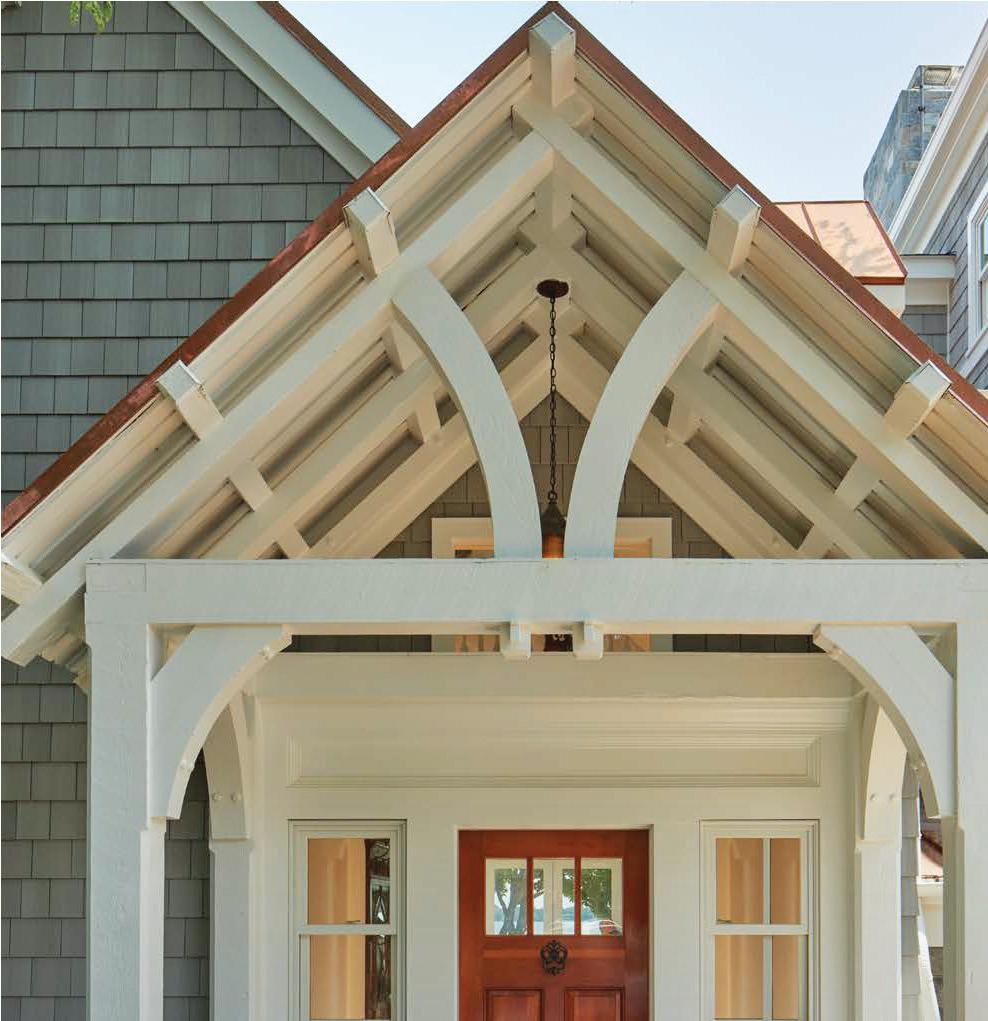


Old Wives
bosom, “it will give you breast cancer. Someone poked my aunt there and sure enough, she got the cancer.”
Another gem from Earlene: “If you touch a shed snakeskin, it will make all your hair fall out.”


“If a cat crawls in the baby’s crib, it will suck the breath right out of it and kill it.” I actually know someone who put a screen door on their baby’s room because they believed this, but I found Earlene’s beliefs more amusing than frightening. Not that I would dispute her. The more you tried rationality on her, the harder she would dig in her mountain-bred heels and insist everything she knew was true. You could put a curse on someone by spitting in the path they walked. You could tell someone was a witch if they couldn’t wear silver without it tarnishing. A witch could put a curse on you by urinating in a mayonnaise jar and burying it under your back steps. If a black cat crossed your path, it


Old Wives
wasn’t just bad luck; you had to go back and retrace your steps all the way back to where you started.
Never start a journey on a Friday or you’d never come home again. There must have been a hundred more, and I wish I’d either paid more attention to them or even written them down.
But alas, Earlene quit school in eighth grade to “run off with a married man,” as someone told me. Frankly, I think education was wasted on her. Earlene’s mind was made up, and you couldn’t confuse her with the facts.
Looking back, I’m guessing Earlene was raised in some isolated



hollow back in the mountains, where this lore was passed down from generation to generation as truth. Probably buried in there hundreds of years ago was some nugget of old healing or wisdom based on observation, but by the time it got to her, it had lost its original strength.
Which is not to say I didn’t hear a fair amount of superstitious sayings from my own family and friends. It was just by the time it was passed down to me by my mother and my aunt, it was pretty well established that it was just an old cliché.
My aunt used to say that if you sewed on Sunday, you’d have to pick out every stitch with your
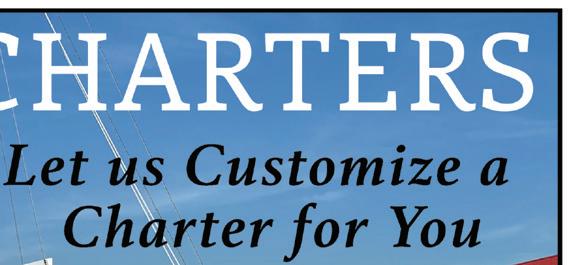
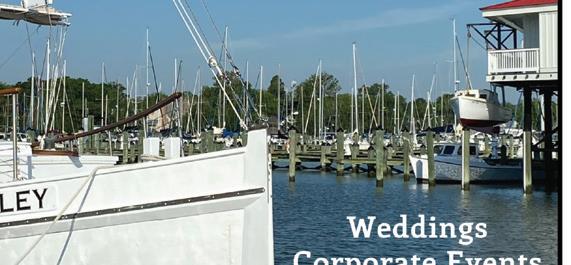

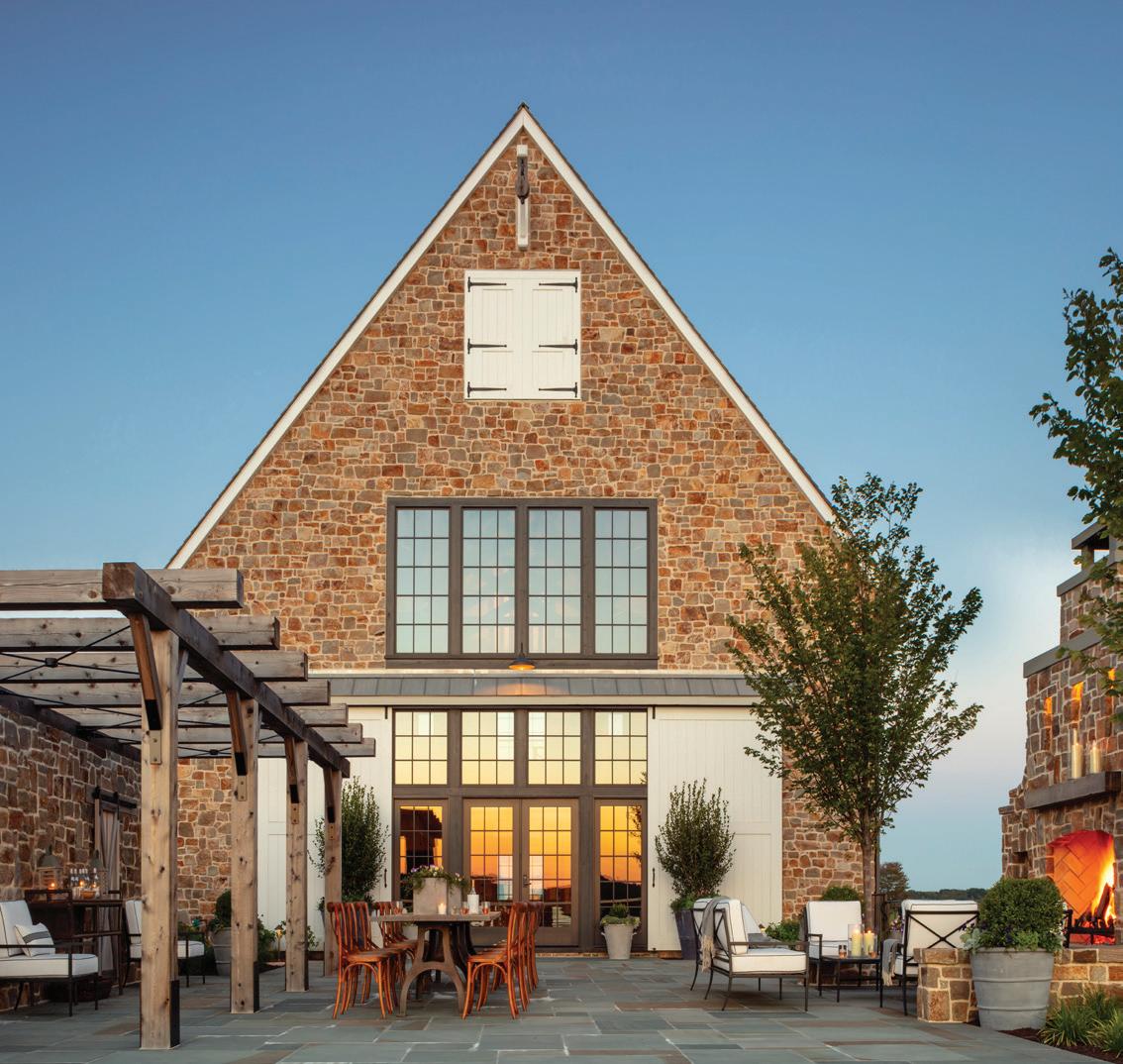

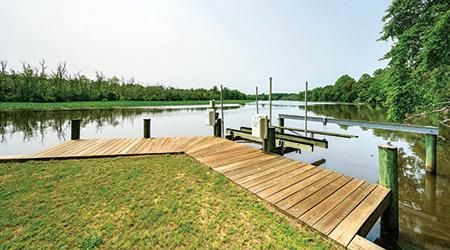


Waterfront Serenity
Perched on 1.42 acres above the Choptank River, this 3BR/3BA modern retreat offers sweeping views, radiant heated floors, elevator, and walls of windows. Main-level primary suite, guest rooms on both levels, and expansive outdoor living with decks, screened porch, 3-car garage, generator, and pier with 10 ft MLW and boat lift. A peaceful, private escape—ideal for full-time or weekend living. $890,000



Old Wives
nose, but she laughed when she said it, and she sewed beautifully, seven days a week.
She and my mother used to say if your nose itched, it meant you were going to kiss a fool, or get a letter, depending on the mood. If your ear burned, someone was talking about you. If your right ear burned, it was good, if your left ear burned, it was bad. My left ear burns a lot.
I can remember sitting on the wall outside our house with my mother, listening to mourning doves, when she pointed out their cooing was a sign of rain to come. And sure enough, in a few minutes, it started to sprinkle. So you never know. I still can’t hear a mourning dove without thinking of my mother.
If I didn’t eat the crusts on my bread, I wouldn’t have curly hair. I hated bread crusts, and I still have curly hair. Go figure.
So, I posted to my friends on social media, asking what old wives’ tales they’d grown up hearing, and I was surprised by how many people replied, and who they were. People you’d think were all rational and scientific were the first to chime in.
A ring around the moon predicts snow. Count the stars inside the ring and it will tell you how many days until bad weather, friend Carolyn posted.
Lunar portents are powerful. Babies tend to come during a full moon, while old people die on the waning of the moon.
Your hair grows faster during a full moon. I’ve heard both hospital workers and law enforcement say a full moon brings on a lot of crazy activity, even though scientists and statistics tell you that’s not so. But how many science types are actually out there dealing with the public during a full moon? Yeah, I thought not, too. The moon affects the tides and we’re some huge percent water, so. . ..
Three people told me if you went outside with wet hair, you were sure to catch cold. (And I always thought that was true in winter, but apparently not!)
My friend Carolyn’s former father-in-law also told her if you hang a dead snake on a fence, it will bring on rain. We used to think shed snake skins drove away mice if you put them under the house. If a cow sees a snake, it will curdle her milk.
Wooly bears, those fuzzy caterpillars, are supposed to predict the winter. If they’re really thick and fuzzy, it will be a rough winter.



Old Wives
They always look thick and fuzzy to me, so what do I know. Also, a thick crop of acorns means a hard winter.
Farm animals can signal a change in the weather. If the cattle lie down, it’s going to rain. Hens won’t lay before a weather event like a storm, a blizzard or a hurricane. There may be some truth to animals sensing natural events. Apparently, animals can sense earthquakes and hurricanes long before humans, so there is some truth to that. When your dog whines and claws at the door, he might be telling you something more than he just needs to go pee.
A bat lose in the house is Satan come to take a soul.
Usually, opening a window and hanging a light outside to attract insects will chase both bat and Satan away. A wild bird getting loose in the house means a death is coming. To dream of a dead person, Marsha said, means someone is going to have a baby soon. I’ve been dreaming about late people a lot lately, and my friend Sarah just told me she’s going to be a grandmother in December! In old wives’ tales, veritas?
Also, you must enter and leave a house by the same exit.
I’m not sure what happens, but I’m sure it’s bad. Did you ever notice how few of these superstitions bode well?
And the first person who comes into your house on New Year’s Day should have dark hair or you’ll have bad luck all year. Likewise, leaving a hat or your shoes on the bed will bring bad luck.

If you swallow a watermelon seed, a melon will grow in your stomach. A double yolk egg is a sign you’re pregnant, Sue tells me.
And if you’re pregnant and you have heartburn, your baby will be born with a full head of hair! At least that’s what Shirley tells me. She had heartburn, and her son was born with thick black hair.
But my absolute favorite comes from my friend Karen. Someone told her if they ate a butterfly, they’d get a new dress. That woman is still waiting for her new frock all these years later!

Helen Chappell is the creator of the Sam and Hollis mystery series and the Oysterback stories, as well as The Chesapeake Book of the Dead . Under her pen name, Rebecca Baldwin, she has published a number of historical novels.




Spectacular Water Views - Architecturally designed to showcase broad, breathtaking views, this 3 bedroom home features an office, multiple living areas, floor-to-ceiling windows, wood floors, fireplace, and a fabulous kitchen. Enjoy a waterside deck, patio, gazebo, private pier, and detached shed. Located near St. Michaels in a quiet village close to a public park and landing. A true nature lover’s paradise - 4+ acres, eagles, osprey, deer, foxes, geese, and shorebirds included. $1,150,000

Waterview Home - Charming 1BR/2BA with loft ideal for office, studio, or workout space. Hardwood floors, pellet stove, and great room with a wall of windows that floods the space with light and frames sparkling views of Duck Cove. Primary suite with private bath, second full bath, laundry room, and attached 1-car garage. Minutes to St. Michaels. $350,000


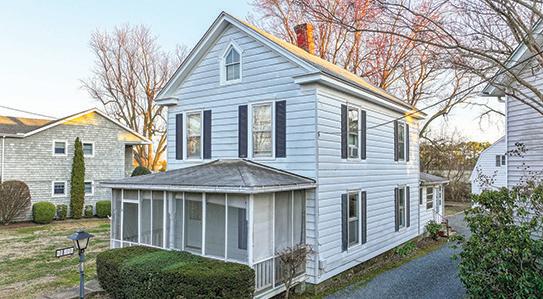
Historic Sherwood - First time offered in 60 years! Classic 3BR, 1.5BA Eastern Shore home in a charming waterfront village. Features wood floors, gas fireplace and large detached garage. Close to county pier and kayak launch access. Perfect as a weekend retreat or full-time residence with historic charm and potential. Own a piece of Sherwood history! $350,000




How to See Six States in Nine Days
Oklahoma/Arkansas, Days 6 to 9
by
Bonna L. Nelson
Zigzagging through six states in nine days took us through Nebraska, Iowa, Missouri and Kansas in the glorious Midwest heartland of America. On the afternoon of the sixth day of the trip, we zagged across the border of Missouri into Oklahoma (OK). We arrived in the Midsouth state after driving by green farm fields in Missouri to then encounter machine gun shooting ranges, military surplus stores, political flags and signs and two casinos along the highway in the hillier land of the northeast corner of Oklahoma.
Oklahoma is located at the approximate geographical center of the 48 contiguous states. Its topography includes mountain ranges, hills, plains, prairies, mesas, eastern forests, wetlands, creeks, rivers and lakes. Eventually we observed dry farm fields decorated with hay bales and then multiple greener fields with grazing cattle near the Neosho and Elk Rivers.
Admitted to the Union in 1907, Oklahoma is the nation’s twentieth largest state with a land mass of close to 70,000 square miles. It borders Missouri to the northeast, Kansas to the north, Texas to the south and
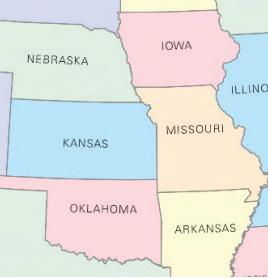
west and Arkansas to the east. The state name, like many other states, is derived from a Native American language, in this case the Choctaw word “okla” for “people” and “humma” for “red.”
According to many sources, Indigenous peoples were present in the area by the last ice age. There are currently twenty-five languages spoken in Oklahoma and more than 14% of the population identify as American Indians, the highest Indigenous population by percentage in any state.
We interacted with native Cherokee people at their center, near our
Six States
resort, Candlewyck Cove in Grove, OK, on Grand Lake o’ the Cherokees in the Ozark Mountains. When we planned the trip, we built in some down time to relax and read in addition to exploring, meeting locals and enjoying local foods.
Candlewyck Cove Resort suited us perfectly. We passed by cows, goats, geese, gray deer and wild turkey in fields and forests on the drive there. The condo on the waterfront was situated in a quiet area with a deck overlooking a deep-water cove nestled among trees. We were the only guests, as far as we knew, at the end of season, and the office was closed except for our check-in.
The small town of Grove is only 5 miles away from the resort. There we purchased groceries and dined. Delicate fall leaves of gold, brown,
russet and burgundy floated gently down onto our deck. Geese and ducks frolicked in the cove. Pure relaxation.
We found old-fashioned comfort food at Drakes Café, a mom-and-pop diner in Grove. Husband John feasted on a fried chicken platter, while I savored a traditional turkey dinner with all the trimmings. Friendly folks and wait staff chatted across tables and included us in their conversations as if we were family or friends.
When exploring the northeast corner of Oklahoma, we drove alongside Grand Lake o’ the Cherokees. The “Crown Jewel” of a four-county area, the lake has a surface area of 46,500 acres. Home to wildlife and fish, surrounded by hillsides of oaks and pines, the lake area is a popular destination for fishing, hunting, boating, biking, golfing, dining and many special events.




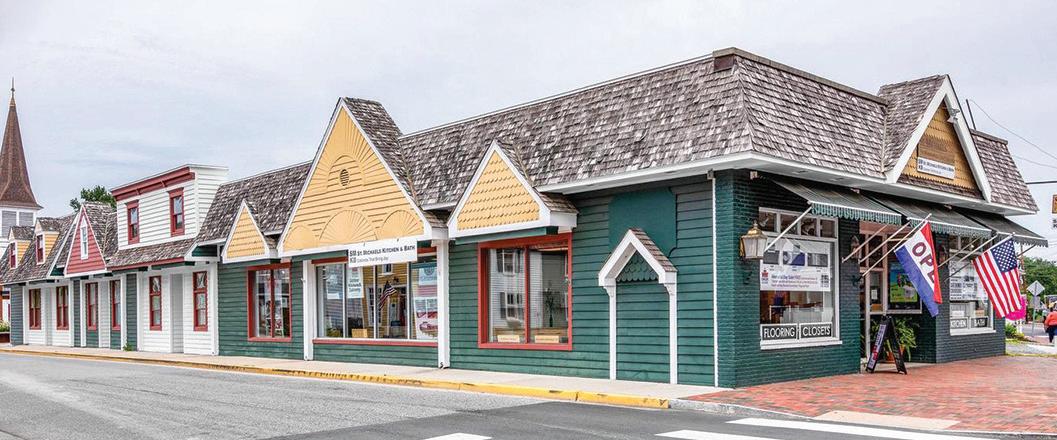




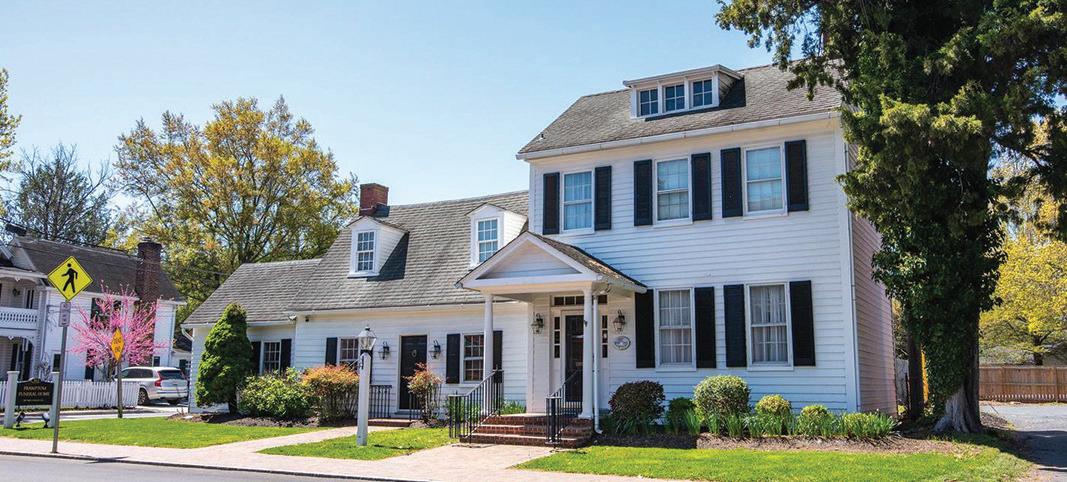


BENSON
MANGOLD



Located just minutes from downtown Easton, this beautifully renovated farmhouse offers the perfect blend of rural charm and modern convenience. Set on a lush, landscaped lot surrounded by productive farmland, the property features an expansive 2,000+- sq ft patio with a wood-burning fireplace, upper deck with hot tub, and custom sound system--ideal for outdoor living and entertaining. Inside, original heart pine floors, exposed brick accents, and thoughtfully restored details create a warm, inviting atmosphere. The kitchen is wellequipped with granite and butcher block counters, ample cabinetry, a walk-in pantry, and gas cooking, all opening to a bright, functional layout with custom built-ins and cozy living spaces. Upstairs, the spacious primary suite includes a private deck, large ensuite bath with heated floors and dual showerheads, and generous closets. Two additional bedrooms, a renovated hall bath, upstairs laundry, and full walk-up attic. Additional highlights include a full-house generator, new HVAC systems (under 3 years old), encapsulated crawlspace, and a preserved artesian well in the basement. The grounds feature mature trees, perennial gardens, an herb garden, and irrigation throughout. The detached historic schoolhouse offers potential as a studio or office. Enjoy the peace of country living with close access to schools, shopping, dining, and healthcare - Gobble Green Farm is a truly special place to call home.
EASTON | $749,900 | 30131DoverRoad.com
Six States
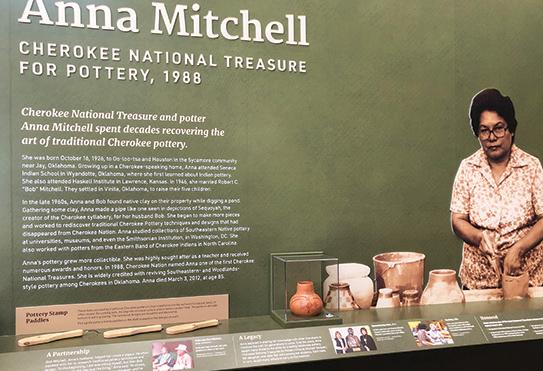
After settling in for our threenight stay, the next morning we headed to the Cherokee Nation Anna Mitchell Cultural & Welcome Center in nearby Vinita, OK. When we traveled around Grand Lake, we noticed milky white pelicans flying overhead or on the shore.
The center is named after Anna Mitchell, a trailblazing Cherokee artist and authority on both Southeastern and Eastern Woodlandsstyle Native American pottery. Ms. Mitchell was recognized not only for her outstanding pottery skills but for revitalizing the art and sharing her knowledge and skills with others.
We were warmly greeted by the Cherokee Center interpreters who shared that the 9,400-square-foot two-story building is situated on eight acres of land overlooking historic Route 66. They told us that the Oklahoma Cherokee Nation reservation spans 14 counties. The reservation is a 7,000-square-mile area with about 141,000 Cherokee Nation citizens residing there, and



Six States
there are approximately 450,000 tribal citizens worldwide.
The center offers exhibits related to Cherokee history, culture and art as well as refreshments and a gift shop. It also serves as a Cherokee community space for meetings, events and classes. We viewed distinctive Cherokee art and artifacts, including pottery, woven basketry, paintings and ceremonial clothing as well as dioramas and explanatory signage.
I selected a few handmade treasures, small sculptures and jewelry reflecting Cherokee artistic traditions in the center gift shop. We were given a brochure listing many other Cherokee Nation museums in Oklahoma and were directed to a related history museum nearby.
Though small, the Eastern Trails Museum in downtown Vinita, OK, contains a wide range of local his -

tory exhibits encompassing the Cherokee Nation, railroads, military, homecraft, toys, mercantile, schools, Route 66 and more. They were having a special Cherokee fest with Nation representatives selling handmade arts and crafts with geometric or curvilinear designs while Cherokee drummers and dancers performed. An unexpected delight!
After a quick lunch at a local spot,

we drove out of town on historic Route 66 heading to the small town of Afton, OK. There is more of Route 66 in Oklahoma than in any other state. For decades, Route 66, known as the “Mother Road,” was the road most traveled by those looking to head west to find their fortune and fame. A major east-west connection, the legendary highway, established in 1926, stretches over 2,400 miles from Chicago to Santa Monica.
We had snacks on our mind when we stopped at the Miller Pecan Co. in Afton on the way back to Grove. How could we resist a market filled with fresh, locally grown pecans prepared in all ways possible? Family owned, they plant, graft and harvest, then clean, shell, market and sell their pecan products with pride.


Six States
From farm fresh raw pecans to roasted, salted, sugared, flavored, wholes, halves, pieces to nut bars, pralines, turtles, pecan butter and pecan oil, Miller’s is pecan heaven. But that’s not all, they sell other products, including coffees, candles, syrups, jams, popcorn, fudge, saltwater taffy, local honey and more. Arms weighed down with bags of goodies, we headed home past Grand Lake dotted with both fishing and pontoon boats.
We awoke the next morning on a deliciously warm, breezy day perfect for our trek through the nearby Lendonwood Botanical Gardens. We had been warmly welcomed at all

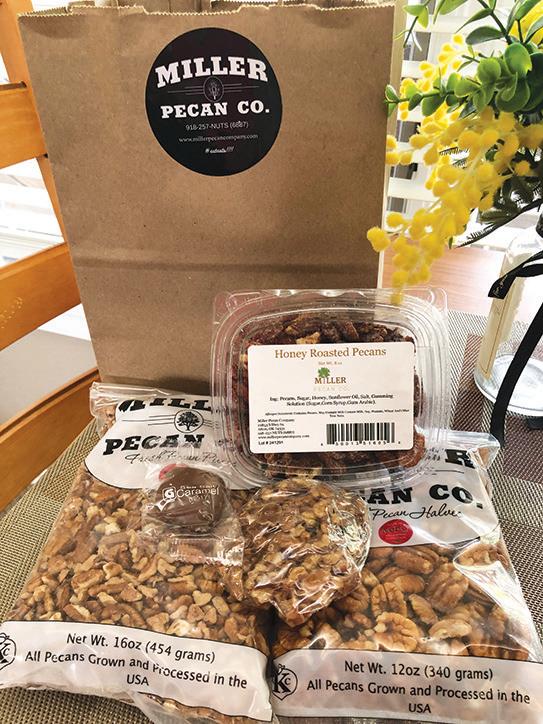
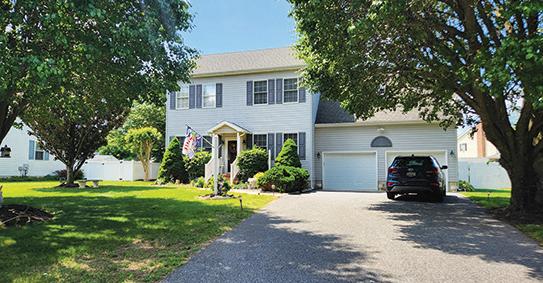


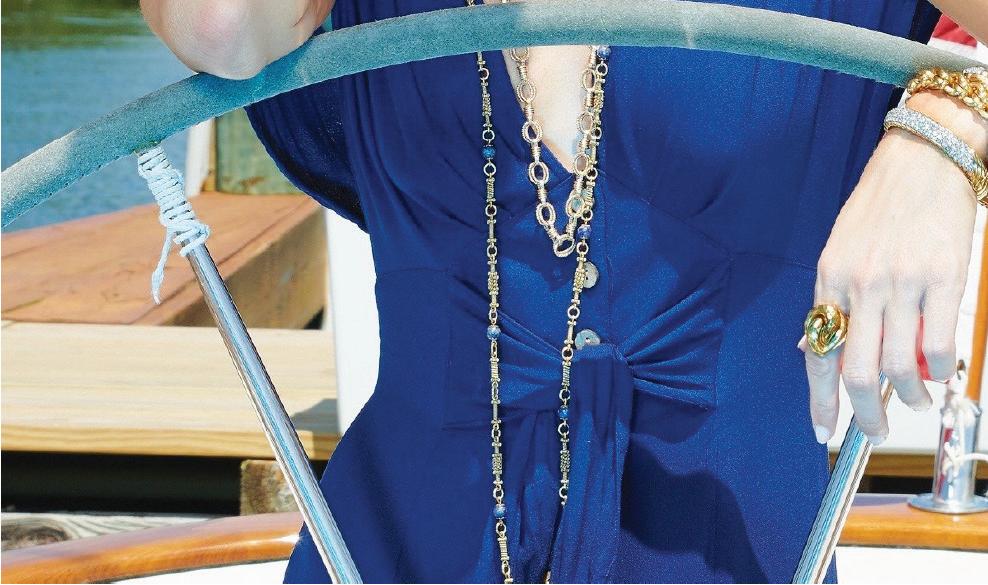
Six States
of our Oklahoma stops. We found more friendly folks at the gardens in Grove, where “shady pathways meander though more than a thousand types of plants, including azaleas, dogwoods, peonies, hostas, evergreen trees and more,” as described on their website.
The eight-acre botanical garden also displays magnificent collections of day lilies, false cypress and Japanese maples as well as an American Backyard Garden, an Oklahoma Garden, streams and waterfalls. With the map provided by the Welcome Center, we meandered around the garden paths stopping to watch and feed the multicolored koi in the garden pond. With a Japanese Pavilion
overlooking the Koi Pond, it is a big attraction for kids and adults alike.
One of the last gardens on the trek was the Angel of Hope Garden, centered by a bronze angel statue dedicated to the memory of lost loved ones. The statue is surrounded by a garden with benches in a woodland area intended to bring comfort and peace in a serene setting. We found the beautiful gardens an inspiration with their soothing panorama of sights, colors, sounds and textures.
Day eight arrived. The weather continued to be warm and sunny. Arkansas (AR) was the sixth and final state of our “Six States in Nine Days” adventure.
We departed Oklahoma energized and ready for a four-hour drive beginning in the stunning Ozark



Oxford – Coastal Retreat with Tred Avon River Views
This charming four-bedroom, two-and-a-half-bath home offers the perfect blend of coastal style and Southern charm. Situated on an oversized in-town lot, it features quality finishes, large windows, built-ins throughout, and two primary suites—one on each level. The inviting layout includes a living room with gas fireplace and custom built-ins, a dining room adjacent to a gourmet kitchen, a flexible mud/laundry/studio space, and a separate office.
Enjoy all that Oxford has to offer—just moments from marinas, restaurants, tennis and pickleball courts, and more. Take a stroll through town, stop for ice cream at Scottish Highland Creamery, visit the waterfront park, or catch a ride on the historic Oxford-Bellevue Ferry.
Offered at $775,000, this well-appointed home delivers relaxed, in-town living in a picturesque setting. Contact me for additional details.



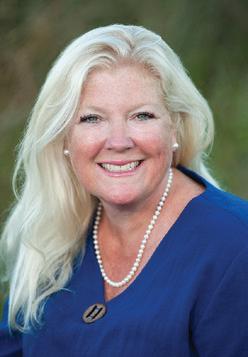
Six States and, new on this leg of the journey, housing developments and towns. We observed picturesque Ozark peaks around the town of Winslow, AR, and drove by the metropolis of Bentonville, AR, birthplace of the retailer Walmart.
mountain region of northwestern Arkansas. The Ozarks are a mecca for outdoor enthusiasts and were decorated with luminous emerald green forests on both sides of the highway.
As we had on previous drives through five states, we passed rivers, lakes, forests, farms, hay bales

Our objective was to arrive at the William J. Clinton Presidential Center and Park, including the former president’s library and museum, in time for the 1 p.m. tour. We achieved our objective, arriving in Little Rock, the state capital and home to the Clinton Center, just in time to meander around the grounds and museum before the tour started.
Prior to and during all of our adventures, we search for information about each location, history, facts,


EASTON - This 9.8-acre property north of Easton offers easy Rt 50 access and stunning views of the Miles River. Features include a dock, pool, gazebo, 3-car garage, and mature landscaping. The split floor plan has a master bedroom, family room, breakfast nook, large office, and expansive game room with potential for a second floor. Ideal for fishing and crabbing. $1,695,000
Bill Wieland

Benson & Mangold Real Estate 31 Goldsborough St., Easton MD 21601 410-310-0803 (c) · 410-822-6665 (o) bill82345@gmail.com


what to see, what to do, where to stay and where and what to eat. We discovered that Arkansas is famous for its natural beauty and nicknamed the “Natural State” due to its diverse landscapes of mountains, lakes, rivers and forests. The state flag has twenty-five stars to symbolize AR becoming the twenty-fifth state in 1836.
The southern state with a land mass of 52,000 square miles, south of Missouri, east of Oklahoma, north of Louisiana and west of Tennessee and Mississippi borders on the Mississippi River. AR ranks number one in rice production in the United States. It has a population of over three million and is the only U.S. state that actively mines diamonds. AR’s current economy is based on service, industry, aircraft, poultry, steel, tourism and agriculture.
Arkansas’s name came from the Quapaw Native Americans, the
“Southwind people,” whom the French called “Arkansaw.” The first ancient people to live in the AR area arrived around 11,650 BCE. Later, in 640 CE, a group of Native Americans called the Plum Bayou built mysterious mounds of dirt that can still be seen today.
The Spanish explored the area in 1541, followed by a French land claim in 1662. The U.S. purchased the area in 1803. History was made in 1957, when nine African American students were escorted by Army troops into Little Rock Central High School, which previously only allowed white students to attend. This was an important milestone in the nation’s civil rights movement.
Back to the library tour, located along the Arkansas River, the Clinton Center is surrounded by a verdant 30-acre city park and aligns with a 17-mile pedestrian/biking bridge, the Clinton Presidential Park
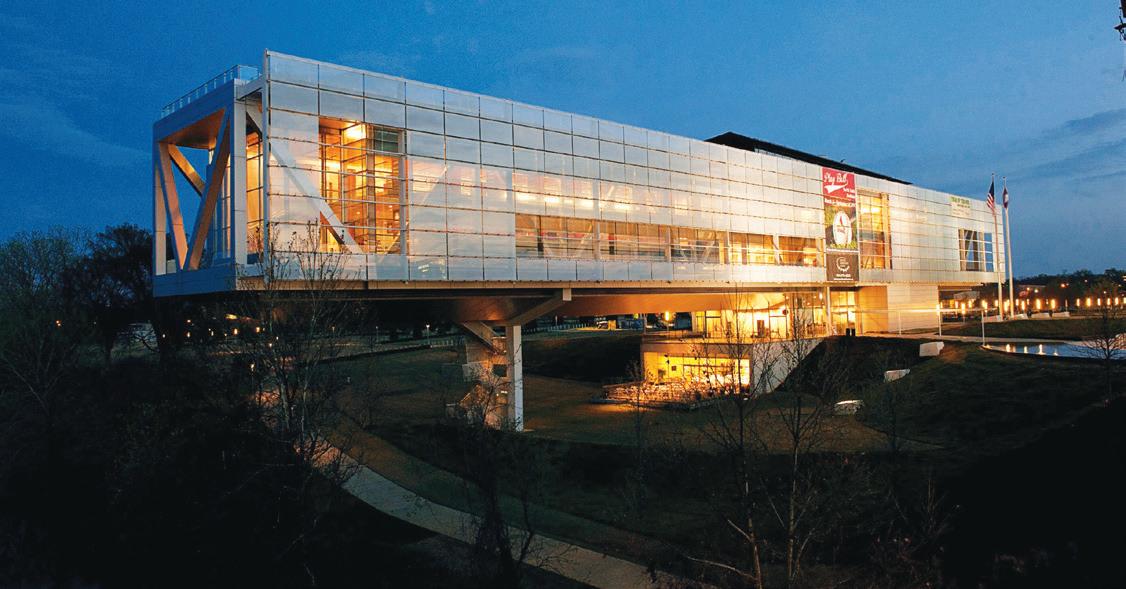
Bridge and a wetland with boardwalk. The center is a modern steel frame and glass bridge-like structure that parallels the walking bridge and was inspired by President Clinton’s desire to “build a bridge to the 21st century.”
This was our second presidential library tour. Like the Truman Presidential Library, the Clinton Library included a replica of his White House Oval Office and Cabinet Room as well as biographical materials reflecting the lives of President Bill Clinton and wife Hillary Clinton. I admired the family photos, the displays of Hillary’s gowns from various White House functions and exhibits of gifts from various countries.
John and I both had interest in the Presidential Limousine and U.S. Secret Service Exhibit. Of course, the president’s archival documents are stored there too and videos, exhibits and signage delineate world events and accomplishments of his presidency, including in the areas of economic prosperity, important legislation and international diplomacy.
We were reminded that President Clinton presided over a historic era of progress and prosperity. His record of progress included the longest economic expansion in American history with a strategy of fiscal discipline, open foreign markets and investments in the American people creating the conditions for a record
115 months of economic expansion. More than 22 million new jobs were created in less than eight years. With the strong economy came the highest home ownership percentage (67.7%) in American history, the lowest unemployment in 30 years and the smallest welfare rolls in 32 years (according to White House Archives)!
President Clinton raised education standards, expanded college opportunities and connected 95% of schools to the internet. With his anti-crime strategy, tough penalties, more police, etc., the crime rate was at its lowest in 26 years. He paid off $360 billion of the national debt and converted the largest budget deficit in American history to the largest surplus. He also protected millions of acres of American land.
On the international front, President Clinton contributed to inter -



Six States
national peace and stability with his active role in addressing global confl icts including ending the Bosnian War, an agreement in Northern Ireland, NATO enlargement, stabilizing Mexico’s economy, stopping the ethnic cleansing in Kosovo and fostering communication between Israel and Palestine.
After a quick stop at the gift shop, where I purchased old presidential campaign badges, which I collect, we strolled over the grounds to the Clinton Bridge over the Arkansas River. Families were walking along the wetland boardwalk by the entrance to the bridge, where we spotted some herons. After a brief bridge walk admiring the flower boxes on the bridge and the skyline of Little Rock, we headed to our hotel for our last night.
John booked an afternoon fl ight home, giving us time to drive out to the Plum Bayou Mounds Archaeological State Park near Little Rock in the morning. I am fascinated by archeological sites and was quite thrilled that we had the opportunity to see the mounds. The ancient archeological site preserves Arkansas’s tallest American Indian mounds, 18 in all.
The mounds are the remains of an early-Mississippian Period religious, ceremonial and government complex aligned with solar positions that was inhabited from 650-1050 CE and
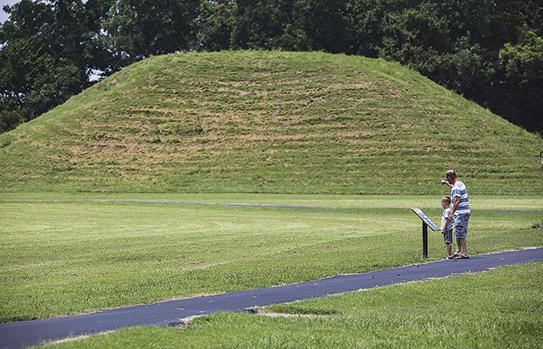
have been studied by the Smithsonian Institute. The park is an active archeological research site with a visitor center, exhibits, a theater, and a research laboratory. Unfortunately for us, the park was closed the day we visited but we could see and photograph the mounds from a distance. They were amazing and inspiring earthworks covered in brilliant, spring green grass and emitting the same spiritual grandeur as a great cathedral.
We did it! We zigzagged across six states in nine days and captured the essence of each state in America’s “Heartlands,” beginning with Nebraska, then Iowa, Missouri, Kansas, Oklahoma and ending with Arkansas. On the fl ight home, we relived our adventure and began to think about our fi nal odyssey to two more states to complete our dream of visiting all fi fty states in the United States of America!

Bonna L. Nelson is a Bay-area writer, columnist, photographer and world traveler. She resides in Easton with her husband, John.






TIDE TABLE OXFORD,
MD
1. Tues.
2. Wed.
3. Thurs.
4. Fri.
5. Sat.
6. Sun.
7. Mon.
8. Tues.
9. Wed.
10. Thurs.
11. Fri.
12. Sat.
13. Sun.
14. Mon.
15. Tues.
16. Wed.
17. Thurs.
18. Fri.
19. Sat.
20. Sun.
21. Mon.
22. Tues.
23. Wed.
24. Thurs.
25. Fri.
26. Sat.
27. Sun.
28. Mon.
29. Tues.
30. Wed.
JULY 2025
HIGH LOW
31. Thurs. AM AM PM PM 9:50 10:49 11:4711:57am 12:53 1:51 2:47
3:44 4:24 5:10 6:03 7:03 8:06 9:10 10:11 11:08 12:49 1:23 1:54 2:23 2:50 3:20
SHARP’S IS. LIGHT: 46 minutes before Oxford
TILGHMAN: Dogwood Harbor same as Oxford
EASTON POINT: 5 minutes after Oxford
CAMBRIDGE: 10 minutes after Oxford
CLAIBORNE: 25 minutes after Oxford
ST. MICHAELS MILES R.: 47 min. after Oxford
WYE LANDING: 1 hr. after Oxford
ANNAPOLIS: 1 hr., 29 min. after Oxford
KENT NARROWS: 1 hr., 29 min. after Oxford
CENTREVILLE LANDING: 2 hrs. after Oxford
CHESTERTOWN: 3 hrs., 44 min. after Oxford
3 month tides at www.tidewatertimes.com 8:57 9:38 10:21 11:06 12:40 1:29 2:12 2:51 3:29 4:07 4:45 5:25 6:05 6:47 7:29 8:13 9:00 9:52 10:49 12:12 1:12 2:10 3:07 4:00 4:50 5:36 6:18 6:56 7:33 8:08 8:45





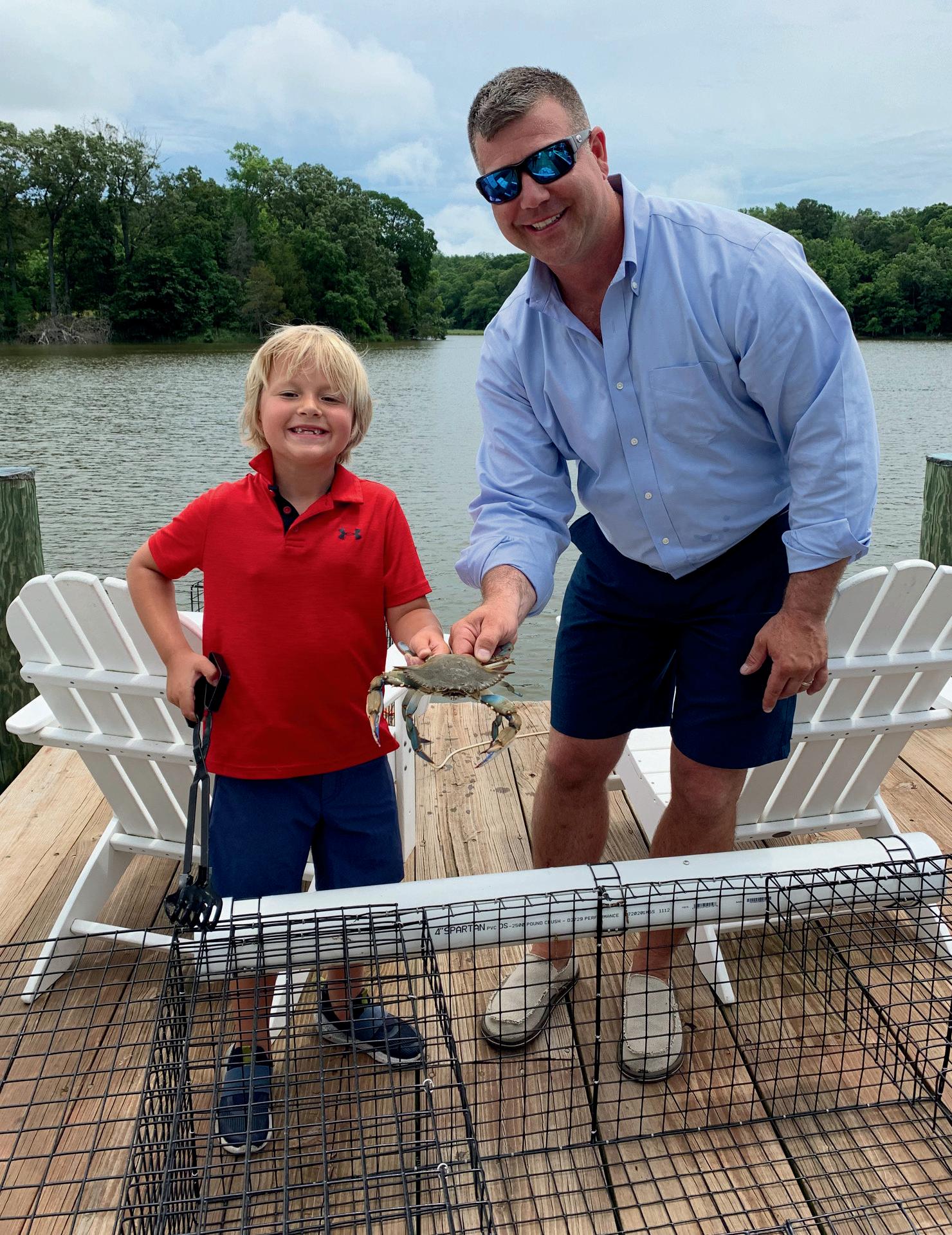














Painting Kindness
Melissa Whittington’s Rock Garden Grows
Community and Hope at Galloway Meadows by
Tracey F. Johns
The community room of Galloway Meadows Apartments in Easton, Maryland, is a warm, welcoming place with cheery decorations, large windows with natural light, plenty of tables and comfortable seating.
Right now, plenty of large, smooth
rocks and painting supplies cover most of the tables, with residents invited to take part in an ongoing project spearheaded by Melissa Whittington, Mid Atlantic Supportive Services, sister company to Fairville Management Company.
It’s all part of a project that in-

Painting Kindness
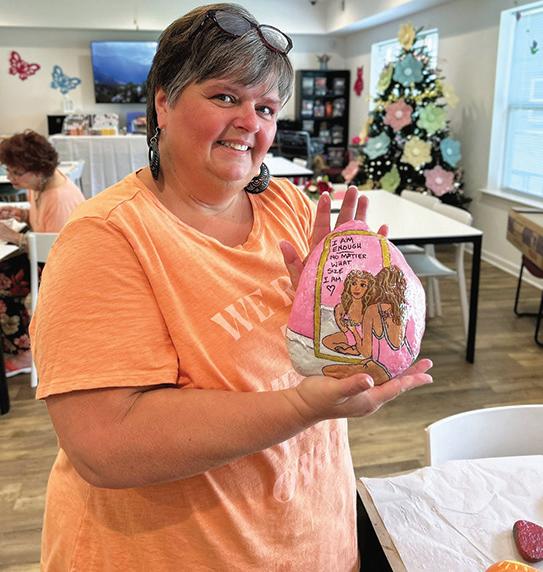
cludes brightly painted stones forming a growing mosaic of color and care just outside the community center’s doors. For Whittington, the “rock garden” is more than just an art project—it’s a symbol of community resilience and shared joy.
“It started as a way to show that we’re not different from other people just because this is low-income housing,” Whittington said. “It’s about bringing people together through kindness.”
Whittington serves six multifamily housing properties across Maryland’s Eastern Shore, including Galloway Meadows in Easton and communities in Cambridge, Chestertown and Cecil County.
At each location, she works to provide free resources, engaging programs and emotional support to hundreds of residents, many
of whom are seniors, veterans or families living on fixed or limited incomes.
The painted rock garden at Galloway was inspired by a past initiative she led called “52 Weeks of Giving,” where residents at another property performed acts of kindness for people beyond their own community.
The rock garden there eventually faded, but Whittington rekindled the idea in 2024 as a simple, creative way to bring people together in turbulent times.
“There’s so much division right now—political, social, everything,” Whittington said. “I just wanted to create a space that’s peaceful, inclusive and uplifting.”
Each week, residents gather in the community room to paint rocks with colorful patterns and encour -
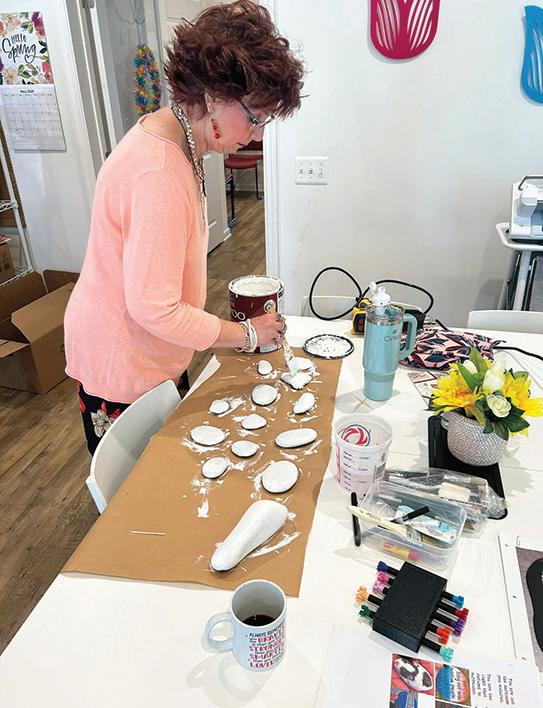


Painting Kindness
aging words: “You Matter,” “Be Kind,” “Stay Strong.” The sessions are calm, meditative and often deeply meaningful for those who participate.
“It’s really helped me,” said Denise Cox, a Galloway resident and retired nurse. “I started painting while caring for my mother during her cancer treatments. It became a way to cope with stress, and it’s still something that grounds me.”
Most rocks remain in the garden, while others travel far. One of Whittington’s painted stones even made it to Princess Diana’s memorial in England, carried by a friend who laid it among the flowers.
Whittington says donations help make it all possible. Paul Ewing’s Contractor Supply of Easton has repeatedly welcomed Whittington to collect stones from their supply yard. Neighbors and residents contribute, too—some returning from vacations with bags of rocks, while others donate art supplies or take the time to paint.
Support also extends beyond the rock project. The publishers of
Cox, who was diagnosed with bipolar disorder later in life, said the painting sessions bring her a sense of calm and focus. “You don’t have to be perfect,” she said. “You just let the rock speak to you. What do you see in it? What do you want it to become?”






Painting Kindness
this magazine provided a donation supporting a Mother’s Day gathering, for example, while others have come together to help put on proms for seniors who never had the chance to attend one when they were young.
Other supporters include Ledo’s, Olive Garden, Spaghetti House, Stoltzfus BBQ, Ruthie’s Soft Pretzels, Kate’s Kountry Kitchen, Country Cheese and Salads and more.
Londonderry on the Tred Avon, a local retirement community, has also helped by donating furnishings during their recent renovation, including chairs, lamps, tables, loveseats and even a shuf-

Monday-Saturday 10:30-5:30



Painting Kindness
fleboard table now used in one of the apartment complexes’ common spaces.
Londonderry has also provided Festival of Trees’ decorated trees from its archives, which are placed in the community rooms of several Fairville Management Company properties.
“Londonderry’s generosity has had such a ripple effect,” Whittington says. “They helped bring more holiday spirit to our spaces, bringing smiles to the faces of many of our residents.”
Whittington’s job involves far more than decorating and activi-
ties. She coordinates health and wellness programs, distributes information about available services, and connects residents to critical resources. Basically, she’ll do anything to help improve the lives of the people served through her work.
A health and resource fair is planned for August with partners including the Talbot County Health Department, Shore Legal Access, and the Talbot County Department of Social Services. During the holidays, she organized a bus tour to view Christmas lights.
Whittington also hosts regular community events: Bingo nights, karaoke and even a version of
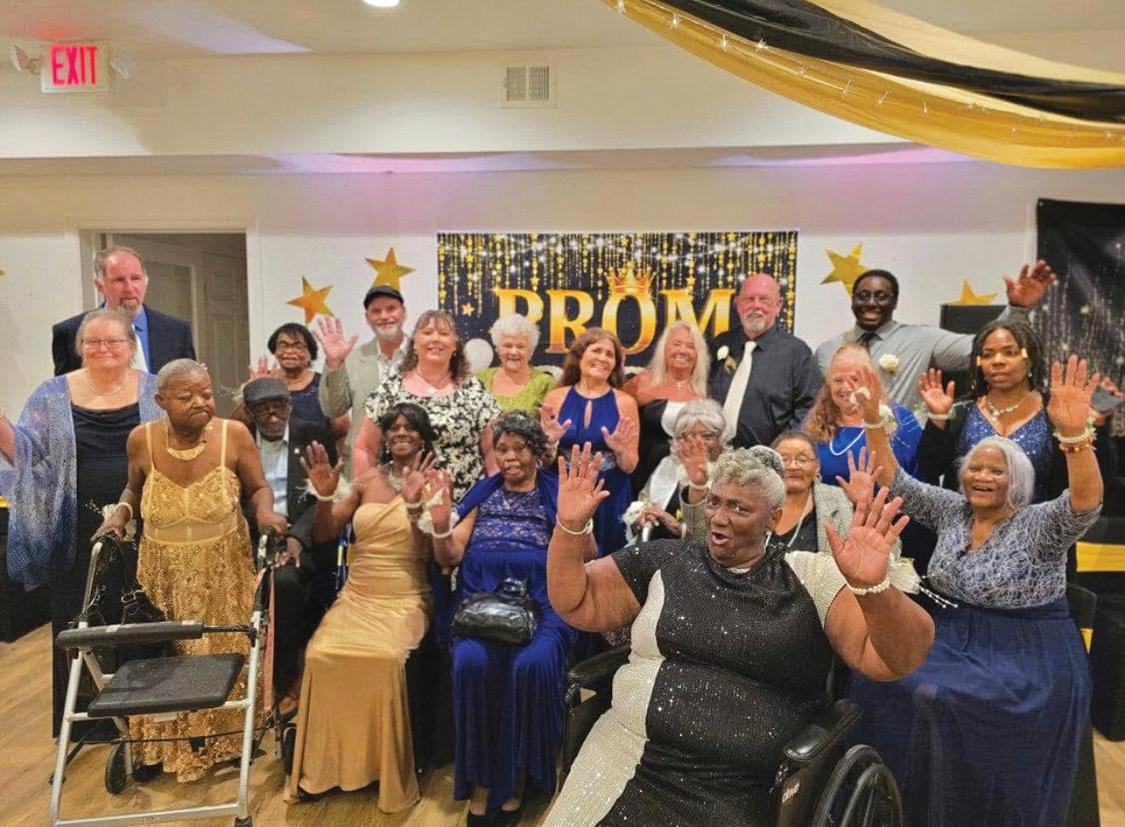

Painting Kindness
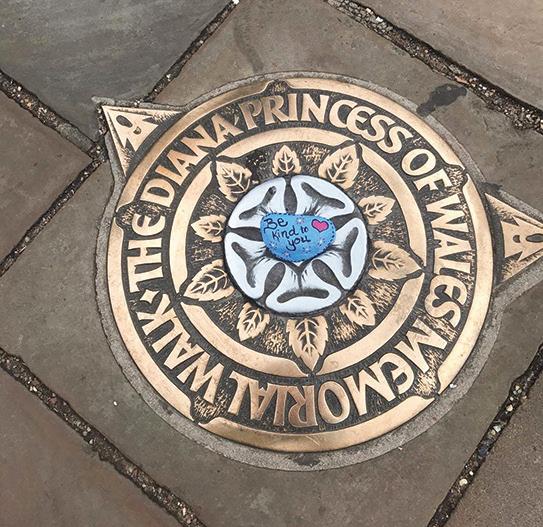
“Family Feud” keep residents smiling and engaged. For Mother’s Day, residents were treated to a “Queen for a Day” spa experience with facials, hand scrubs and more.
“I do what I can with a very low budget,” she said. “Sometimes I hold yard sales at my own house to raise money for extra events.
“Other times, I reach out to friends and the community for help or just cover the costs myself,” Whittington continued. “But I believe in doing whatever it takes to bring people a little joy.”
She says food insecurity remains a pressing concern at Galloway Meadows and throughout the MidShore. While the community once had a pantry on-site, it closed after the pandemic when donations and funding dried up. Whittington said she’d love to reopen it and accept donations of shelf-stable pantry items.
“Some of our senior residents get just $26 a month in food stamps,” she said. “I’ve done grocery runs myself for veterans and others who can’t make ends meet.”
To help bridge the gap, Whittington says St. Mark’s United Methodist Church is launching a mobile soup kitchen that began weekly visits to Galloway this June. And every Saturday, a small but steady stream of fresh bread and pastries gleaned from Harris Teeter in Easton helps stock tables for residents to enjoy.
Still, the rock garden remains the heartbeat of Whittington’s efforts. She often paints long into the night in the company of family and a few residents, long after most have tucked in for the evening.
“It’s what gets me through the hard days sometimes,” she said. “Sitting long after the sun sets, just



Painting Kindness
painting, it settles me. It’s simple, but it works.”
Whittington said she plans to continue painting until the entire garden bed is filled—and then, perhaps, take the project to other properties she manages. She also welcomes visitors to come paint by appointment and encourages community members to donate supplies or sponsor events.
“This is how we build community,” she said. “Not through grand gestures, but through small, consistent acts of kindness—one rock at a time.”

The Fairville Management Company is a property management firm dedicated to providing quality multifamily housing across the Eastern Shore of Maryland. Fairville manages a diverse portfolio of affordable housing communities, including Galloway Meadows in Easton, Satterfield High Steps in Chestertown and Cambridge Club in Cambridge, all with waiting lists for new tenants.
To support the Galloway Meadows rock garden or make donations of non-perishable food, art supplies or lunch sponsorships, contact Melissa Whittington at 410476-7484 or email mwhittington@ masupportiveservices.com.
Each property offers professionally landscaped grounds and amenities tailored to meet the needs of residents, such as community centers, playgrounds and on-site tenant services coordinators. Fairville’s commitment to excellence ensures that residents have access to comfortable, well-maintained homes in welcoming neighborhoods. More is at fairvillemanagement.com/galloway-meadows.


Tracey Johns has worked in communications, marketing and business management for more than 30 years, including non-profit leadership. Tracey’s work is focused on public and constituent relations, along with communication strategies, positioning and brand development and project management.



IN TALBOT COUNTY
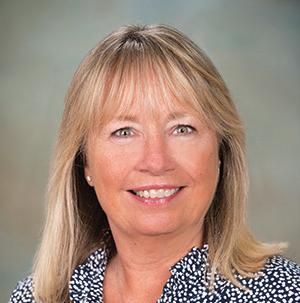

EASTON CLUB EAST - $489,500
29748 Lyons Drive - The family of the original owners is honored to present this cherished 2,184 sq. ft. one-level home. Situated on a premium lot, it offers solid bones and timeless potential. While it may need a bit of updating, it’s the perfect opportunity to add your personal touch and make it your own special place to call home. RETIRE
SUN COMMUNITIES at HYDE PARK
Ground rent presently $633.17/month. New owner will pay approximately $60 more.
11 Park Lane - $189,500 This home features a fantastic layout and a spacious front porch— perfect for relaxing and enjoying the day. The split-bedroom design offers privacy, with the primary suite tucked away in the back and the guest bedroom situated at the front.

Helping Buyers and Sellers Reach Their Dreams Since 1989


“To Love, with Gratitude: Let’s”
by Michael Valliant
On June 7, I sat down on the screened porch of our cabin on the bay in Chincoteague, Virginia, sipped some coffee, watched fog roll in, listened to sea gulls and terns and opened Mary Oliver’s book “Devotions.” I found myself reading her poem, “The Summer Day,” which ends:
“Tell me, what is it you plan to do with your one wild and precious life?”
My answer, as it has been for the
past seven and a half years, was and is: give it to love, with gratitude. That evening, Holly and I got married on the pier, with our family and some close friends; a commitment to God and each other, a new chapter in an ongoing love story.
The same weekend last year, the two of us were sitting on the same porches, in the moment, enjoying coffee and watching dolphins jumping in the bay when the idea landed on us: what if we had our families
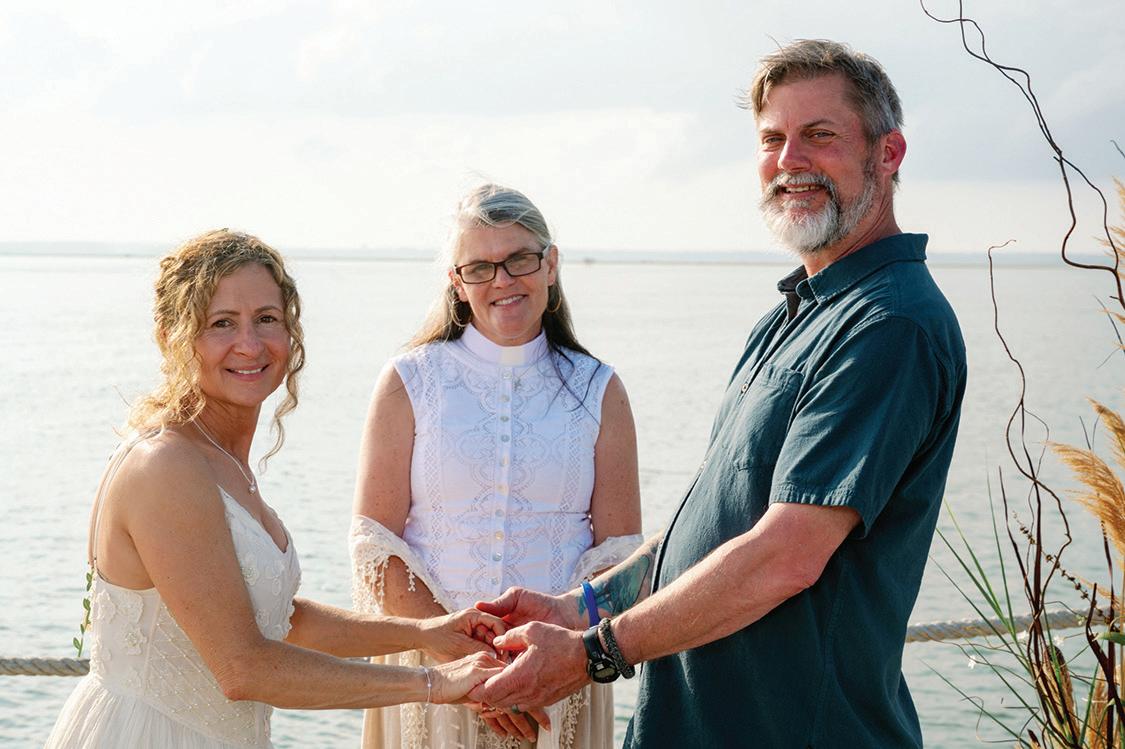
Holly and Michael along with Rev. Jessica Stehle.


Let's
down here, spent the weekend together, all of us and we got married outside on the dock.
Porch sitting a year later, I watch Holly’s son Lee and his dog Lexi walk out onto the dock and cast a line fishing. My daughter Anna and my brother-in-law Chad and his son Samuel run out to grab doughnuts from in town. Thursday night we had dinner with our parents and watched the sunset on the bay. On Friday, family came in throughout the day and we all went out on an evening cruise, learning all about the drama and dynamics of different ponies and coming across a group of Amish people who had pulled a six-
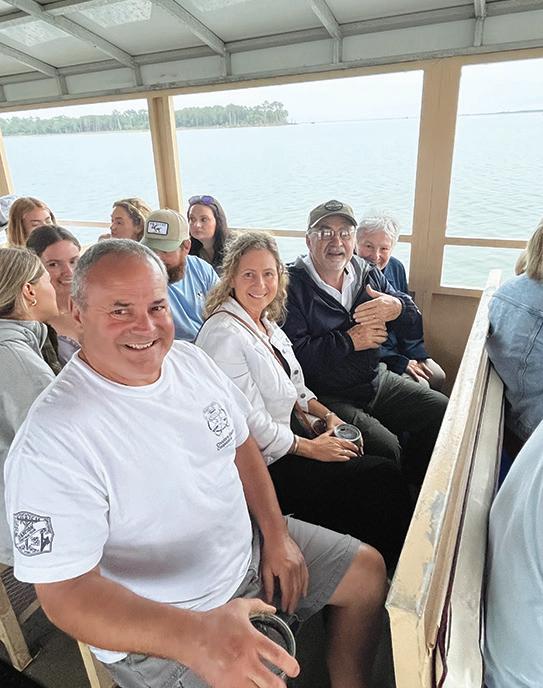
or seven-foot shark onto a dock. In the busy-ness that everyone’s lives have become, we rarely get this kind of time to share. We were there to make these moments, to share a gift.
For Holly and I both, our love story starts with God. We both found ourselves in our 40s with marriages that had ended and children who were our focus and work that was meaningful. Holly was a dairy farmer and cheesemaker, founding and running a creamery, who now works with schools and farmers and takes meals and produce into food-scarce neighborhoods. Her consistent ministry is feeding people.
I went from non-profit communications to speech writing and technical writing, to non-profit management, before following a calling into church work and ordained ministry.
We both reached a place of joy, gratitude and happiness on our own and with God, where if romantic love wasn’t in the cards, then that was fine. Life was good.
Our paths crossed through a mutual friend, the now Rev. Jessica Stehle, who I graduated from Washington College with, as English majors; then graduated from seminary with, and who I was ordained with as transitional Deacons in the Episcopal Church. Holly and Jessica’s children grew up together and Jessica invited Holly to Christ Church.
Holly and I talked a couple months later, grabbed coffee a few times, then went for a hike together
Holly’s brother Allen, Holly, and her parents, on the evening cruise.


EASTERN SHORE REAL ESTATE Specialist
EXCEEDING EXPECTATIONS:
Lona has lived on the beautiful Eastern Shore her entire life. Her local knowledge and connections make her an expert in the area. Lona has a reputation for putting her client’s needs first which she believes is at the heart of her success. Providing customer service with honesty and integrity is important to her. She also understands that buying and selling a home is more than just a transaction; it is a life-changing experience.



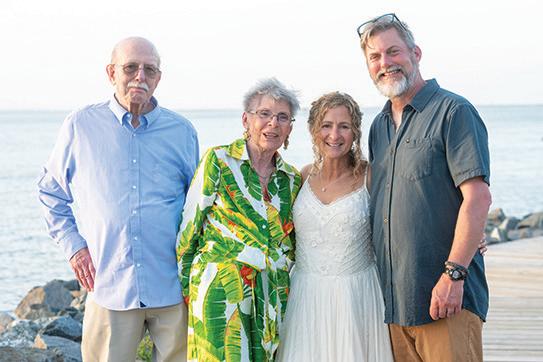
through Tuckahoe State Park in December 2017, and came out different than when we went in, together.
Hiking, kayaking and exploring around Maryland, Delaware, West Virginia, Pennsylvania, Virginia, Alaska, Florida, we’ve been able to find wonder anywhere and everywhere, from backyards to glaciers. Let me go back to Mary Oliver and
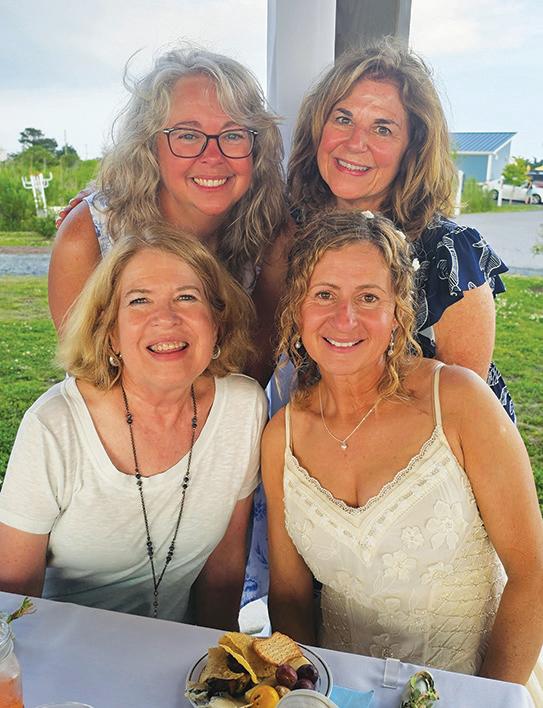


Let's
her poem, “Six Recognitions of the Lord,”
“… Slowly we make our appreciative response. Slowly appreciation swells to astonishment. And we enter the dialogue of our lives that is beyond all understanding or conclusion. It is mystery. It is love of God…”
Our response to God, our re-
sponse to love is appreciation. Gratitude. Astonishment. It’s a mystery bigger than either or both of us. And we get to be a part of it.
Where love lives, freedom resides. It comes to both of us frequently that we feel more free together than either of us do by ourselves. Love is perfect freedom, and that is the gift that we want for each other.
We got engaged in April 2024 and thought about how to get married in a way that spoke to us: to be outside, to be on the water, to be surrounded by a small gathering of family and a few friends who have been with us both along the way.
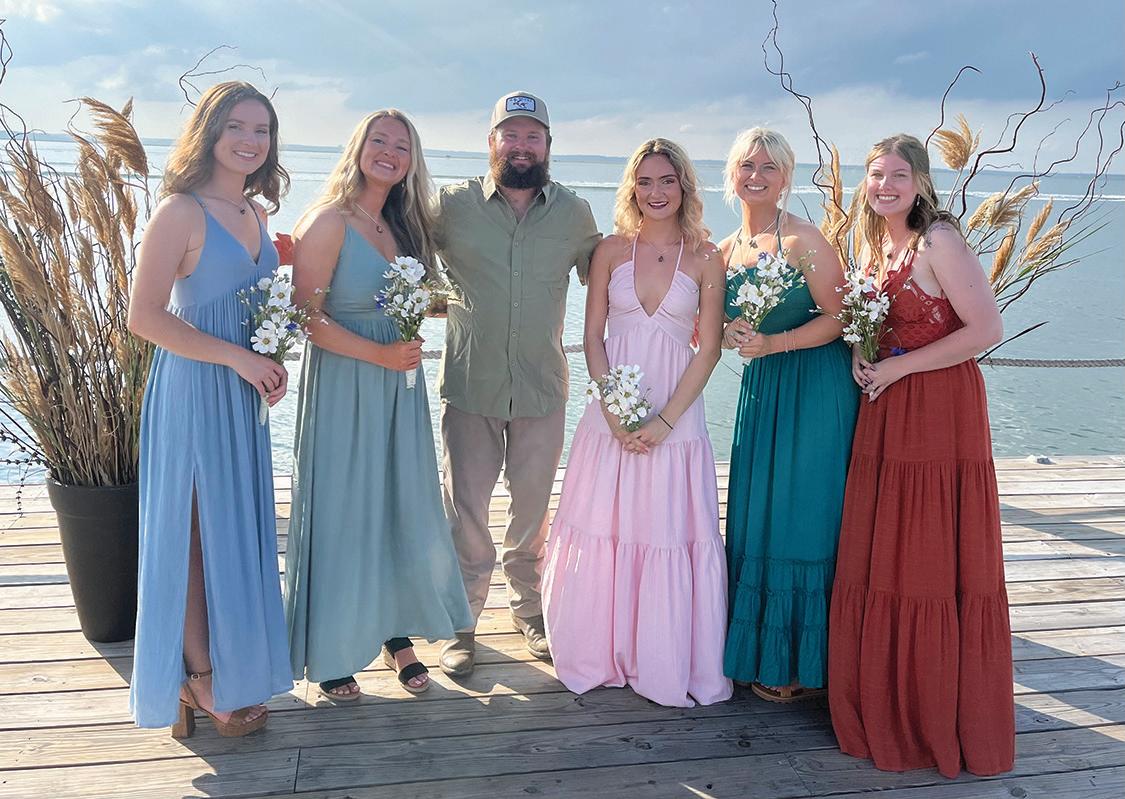
Photo with all the kids (from left) Holly’s Emmy, Erin, Lee, and Erica, then my girls Anna and Ava.


June 7, 2025. Standing on the dock during the day with our kids and Rev. Jessica, going over the order of things for the evening, dolphin were jumping ten feet from the dock. There were three Great Blue Heron flyovers over the course of the day. It was family and friends who turned the pavilion into Holly’s vision of an outdoor wedding hall, using objects found and collected together and with family. During the ceremony and reception, it poured rain a mile up Main Street and on the water, but we seemed to be under a bubble, looking at rainbows around us.
As part of the ceremony, we put together vows that used our language:
“Coming together with God, I take you Holly/Michael to be my wife/ husband; to love and to listen to; to find joy and adventure with; to care

for when you are sick or hurting; to share our lives in wonder and with gratitude; loving God and each other more every day. Let’s.”
From our earliest conversations, talking about life, and dreaming about adventures, “Let’s” has always been our response to each other.
Life was good. It got better, together. After seven-and-a-half years, marriage begins the next adventure together, with God.
Let me invoke Mary Oliver once more, turning singular to plural, shared:
“Then we go back to town, to our own house, our own life, which has now become brighter and simpler, somewhere we have never been before.”
It’s a new chapter, in our 50s, leaning into love’s perfect freedom, somewhere we have never been before.
Every day we get to ask ourselves what it is we are going to do with our one wild and precious life. Each day is our answer to that question, whether we realize it or not.
We hope to make our answer: to love, with gratitude.

Let’s.
Michael Valliant is the Assistant for Adult Education and Newcomers Ministry at Christ Church Easton.




Local Color Art Show and Sale by the Working Artist Forum
While you’re in town, enjoying the exciting events of Plein Air Easton, be sure to visit the 21st Annual Local Color Art Show & Sale at Christ Church at 111 S. Harrison Street. The Local Color Show takes place Thursday, July 17th through Sunday, July 20th. This unique event showcases the amazing art exclusively created by forty-two juried artists from the Eastern Shore of Maryland and from the Working Artists Forum. Exhibited paintings are created en plein air or in the studio. The show’s opening reception & award ceremony is at 12:00 noon on Thursday, July 17th. Light refreshments will be served.
The show is judged and juried by Plein Air Easton’s first and second place award winners of 2024. This year, the Local Color judge will be Robert Simone, Plein Air Easton’s 2024 Grand Prize winner and juried by Christine Lashley, the 2024 Plein Air Easton Second Place award recipient. These celebrated plein air artists will also present painting demonstrations on Thursday afternoon at 1:00 and 3:30 pm upstairs in the Fellowship Hall at Christ Church in Easton, MD. Artists Orville Giguiento, Patrick Lee and David Orrin Smith will present
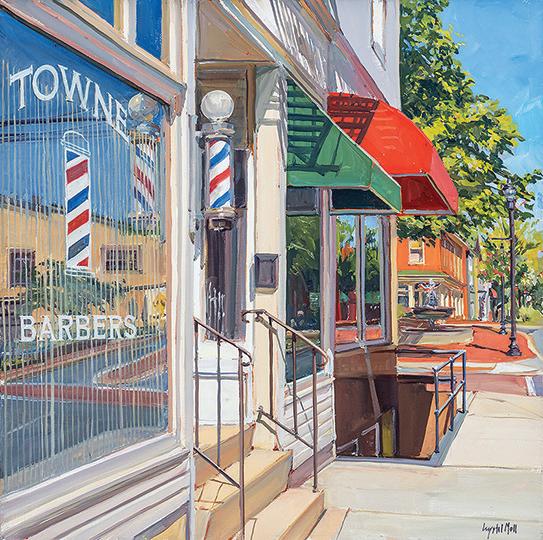
Crystal Moll, Towne Barbers
three additional painting demonstrations, also award winning 2024 Plein Air Easton artists. The Demo & Show schedule is included below. All painting demonstrations are sponsored by The Working Artists Forum and are open to the public at no charge.
SHOW SCHEDULE:
Thursday, July 17 noon to 7 p.m.
Open to Public Friday, July 18 10 a.m. to 6 p.m.
Open to Public Saturday, July 19 10 a.m. to 6 p.m.
Open to Public Sunday, July 20 11 a.m. to 4 p.m. Open to Public
Local Color

PAINTING DEMO SCHEDULE:
Featuring 2024 Plein Air Easton Award Winners
7/17/24 , Thurs. – 1 p.m.-3 p.m.
Robert Simone, 2024 Grand Prize Recipient
7/17/24 , Thursday – 3:30 to 5:30
Christine Lashley, 2024 Second Place Recipient
7/18/24 , Friday – 1 to 3 p.m.
Orville Giguiento, 2024 Artists’ Choice Recipient
7/18/24 , Fri – 3:30 to 5:30 p.m.
Patrick Lee, 2024 Third Place Recipient
7/19/24 , Sat. – 3:30 to 5:30 p.m.
David Orrin Smith, 2024 Quick Draw Alumni Recipient
Some of the proceeds from Local Color contribute to The Working Artists Forum’s educational program, providing art supplies for local elementary schools. More information can be found on the Working Artists Forum and Plein Air Easton Websites.


Carla Huber, Bee Boxes




Queen Anne’s County
The history of Queen Anne’s County dates back to the earliest Colonial settlements in Maryland. Small hamlets began appearing in the northern portion of the county in the 1600s. Early communities grew up around transportation routes, the rivers and streams, and then roads and eventually railroads. Small towns were centers of economic and social activity and evolved over the years from thriving centers of tobacco trade to communities boosted by the railroad boom. The county is named for Queen Anne of Great Britain, who reigned when the county was established in 1706.
Queenstown was the original county seat when Queen Anne’s County was created, but that designation was passed on to Centreville in 1782. It’s location was important during the 18th century, because it is near a creek that, during that time, could be navigated by tradesmen. A hub for shipping and receiving, Queenstown was attacked by English troops during the War of 1812.
Construction of the Federal-style courthouse in Centreville began in 1791 and is the oldest courthouse in continuous use in the state of Maryland. Today, Centreville is the largest town in Queen Anne’s County. With its relaxed lifestyle and tree-lined streets, it is a classic example of small town America.
The Stevensville Historic District, also known as Historic Stevensville, is a national historic district in downtown Stevensville, Queen Anne’s County. It contains roughly 100 historic structures, and is listed on the National Register of Historic Places. It is located primarily along East Main Street, a portion of Love Point Road, and a former section of Cockey Lane.
The Chesapeake Heritage and Visitor Center in Chester at Kent Narrows provides and overview of the Chesapeake region’s heritage, resources and culture. The Chesapeake Heritage and Visitor Center serves as Queen Anne’s County’s official welcome center.
Queen Anne’s County is also home to the Chesapeake Bay Environmental Center (formerly Horsehead Wetland Center), located in Grasonville. The CBEC is a 500-acre preserve just 15 minutes from the Chesapeake Bay Bridge. Over 200 species of birds have been recorded in the area.
Embraced by miles of scenic Chesapeake Bay waterways and graced with acres of pastoral rural landscape, Queen Anne’s County offers a relaxing environment for visitors and locals alike.
For more information about Queen Anne’s County, visit www.qac.org .

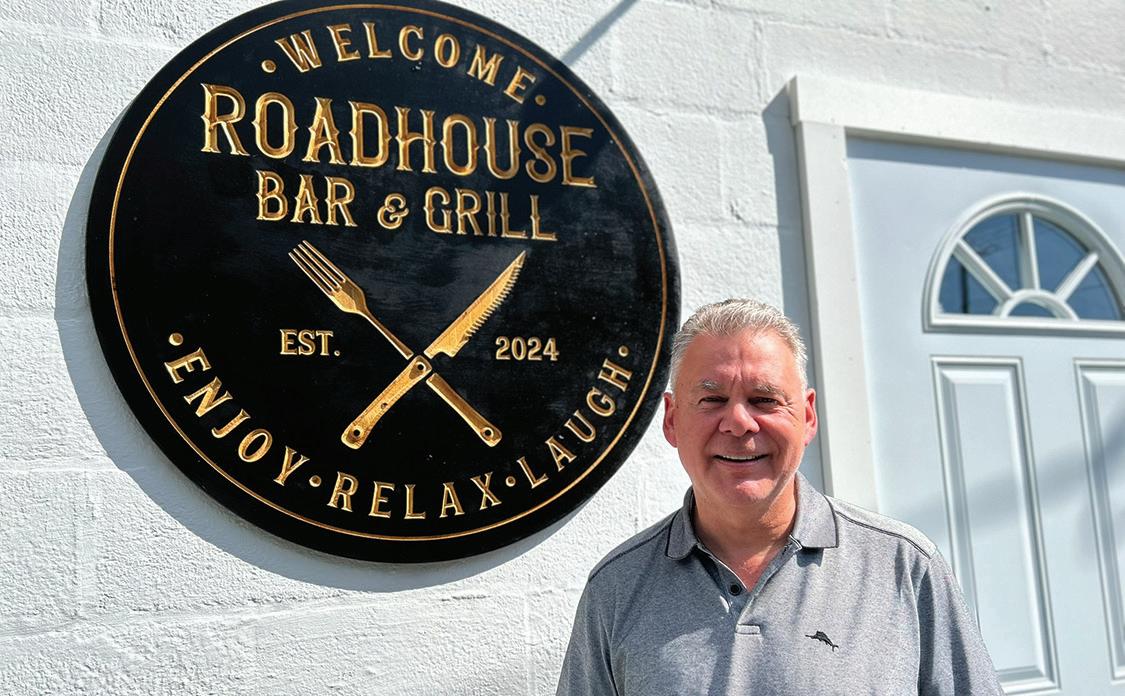
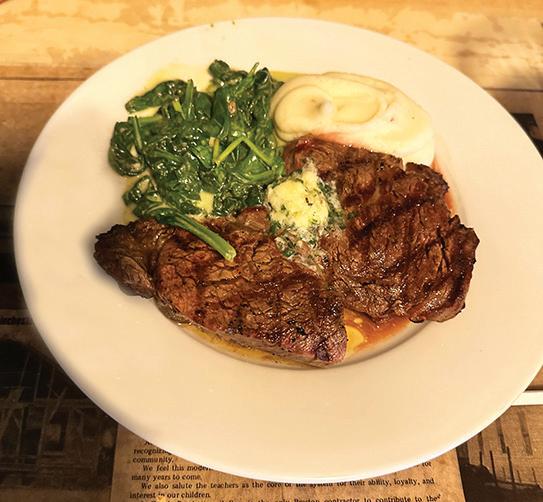
"Welcome to our Roadhouse Bar & Grill, where the open road meets mouthwatering flavors and good ol’ fashioned hospitality. In the heart of Preston, Caroline County, we are not just about great food; we’re about creating great memories" ~ Ian & Elinor Fleming Serving Lunch 11:30 a.m. - 2:30 p.m. ~ Mon through Sat inclusive Serving Dinner 4 p.m. - 8 p.m. ~ Tue through ur inclusive 4 p.m. - 8:30 p.m. ~ Fri and Sat 201 Main St., Preston, MD 667-342-4024 Reservations Recommended!

Caroline County – A Perspective
Caroline County is the very definition of a rural community. For more than 300 years, the county’s economy has been based on “market” agriculture.
Caroline County was created in 1773 from Dorchester and Queen Anne’s counties. The county was named for Lady Caroline Eden, the wife of Maryland’s last colonial governor, Robert Eden (1741-1784).
Denton, the county seat, was situated on a point between two ferry boat landings. Much of the business district in Denton was wiped out by the fire of 1863.
Following the Civil War, Denton’s location about fifty miles up the Choptank River from the Chesapeake Bay enabled it to become an important shipping point for agricultural products. Denton became a regular port-ofcall for Baltimore-based steamer lines in the latter half of the 19th century.
Preston was the site of three Underground Railroad stations during the 1840s and 1850s. One of those stations was operated by Harriet Tubman’s parents, Benjamin and Harriet Ross. When Tubman’s parents were exposed by a traitor, she smuggled them to safety in Wilmington, Delaware.
Linchester Mill, just east of Preston, can be traced back to 1681, and possibly as early as 1670. The mill is the last of 26 water-powered mills to operate in Caroline County and is currently being restored. The long-term goals include rebuilding the millpond, rehabilitating the mill equipment, restoring the miller’s dwelling, and opening the historic mill on a scheduled basis.
Federalsburg is located on Marshyhope Creek in the southern-most part of Caroline County. Agriculture is still a major portion of the industry in the area; however, Federalsburg is rapidly being discovered and there is a noticeable influx of people, expansion and development. Ridgely has found a niche as the “Strawberry Capital of the World.” The present streetscape, lined with stately Victorian homes, reflects the transient prosperity during the countywide canning boom (1895-1919). Hanover Foods, formerly an enterprise of Saulsbury Bros. Inc., for more than 100 years, is the last of more than 250 food processors that once operated in the Caroline County region.
Points of interest in Caroline County include the Museum of Rural Life in Denton, Adkins Arboretum near Ridgely, and the Mason-Dixon Crown Stone in Marydel. To contact the Caroline County Office of Tourism, call 410-479-0655 or visit their website at www.tourcaroline.com .



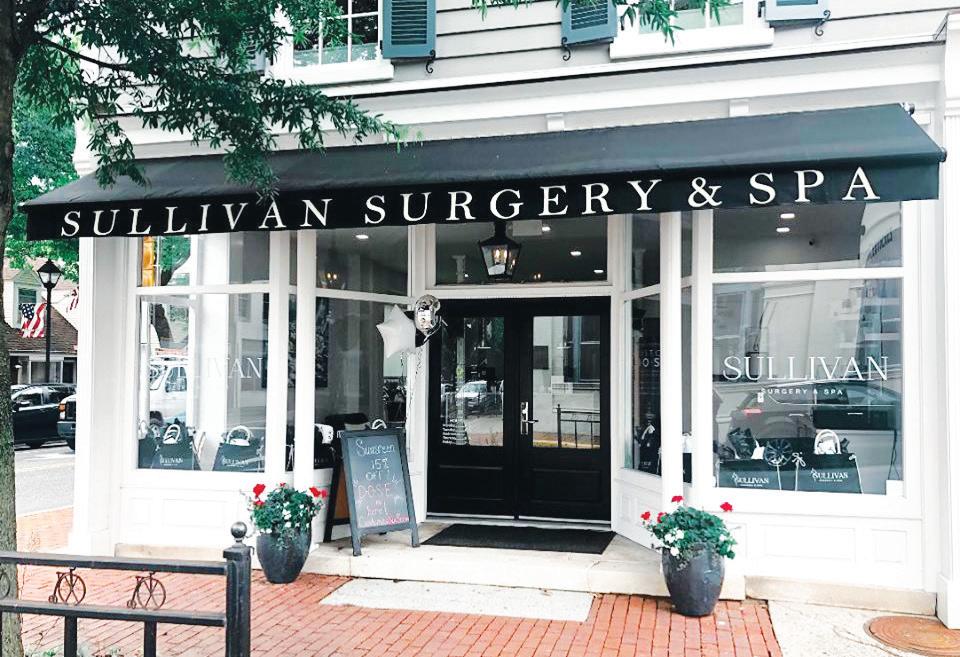

Easton
Map and History
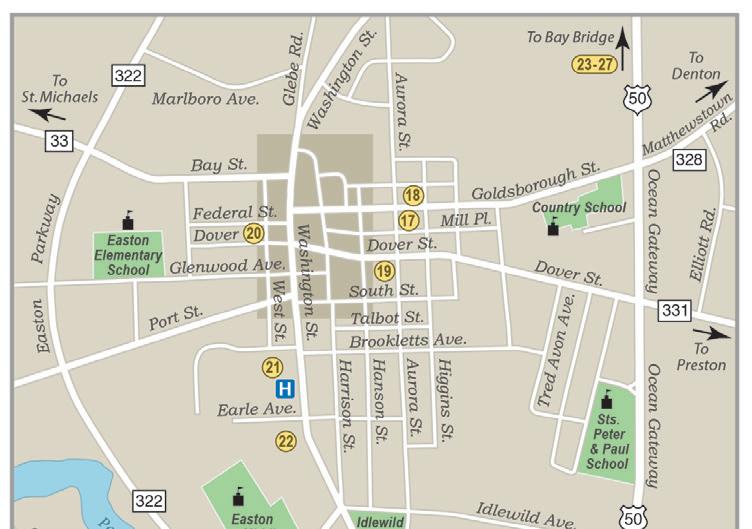
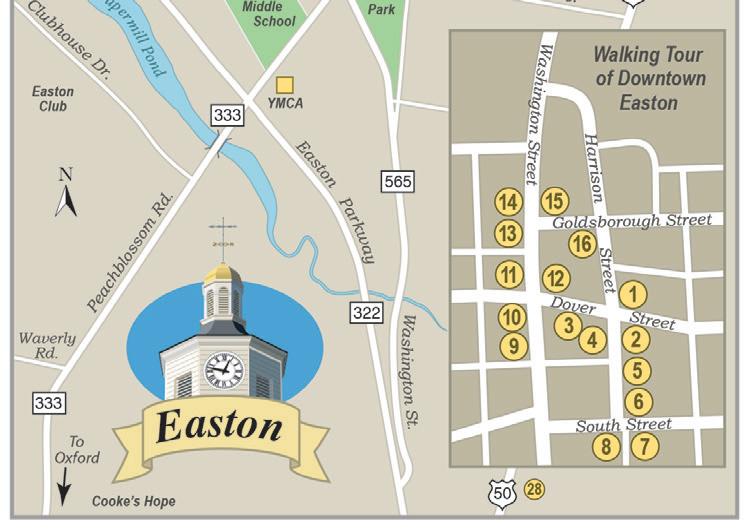

The County Seat of Talbot County. Established around early religious settlements and a court of law, Historic Downtown Easton is today a centerpiece of fine specialty shops, business and cultural activities, unique restaurants, and architectural fascination. Treelined streets are graced with various period structures and remarkable homes, carefully preserved or restored. Because of its historical significance, historic Easton has earned distinction as the “Colonial Capitol of the Eastern Shore” and was honored as number eight in the book “The 100 Best Small Towns in America.” With a population of over 16,500, Easton offers the best of many worlds including access to large metropolitan areas like Baltimore, Annapolis, Washington, and Wilmington. For a walking tour and more history visit https:// tidewatertimes.com/travel-tourism/easton-maryland/.







Dorchester Map and History
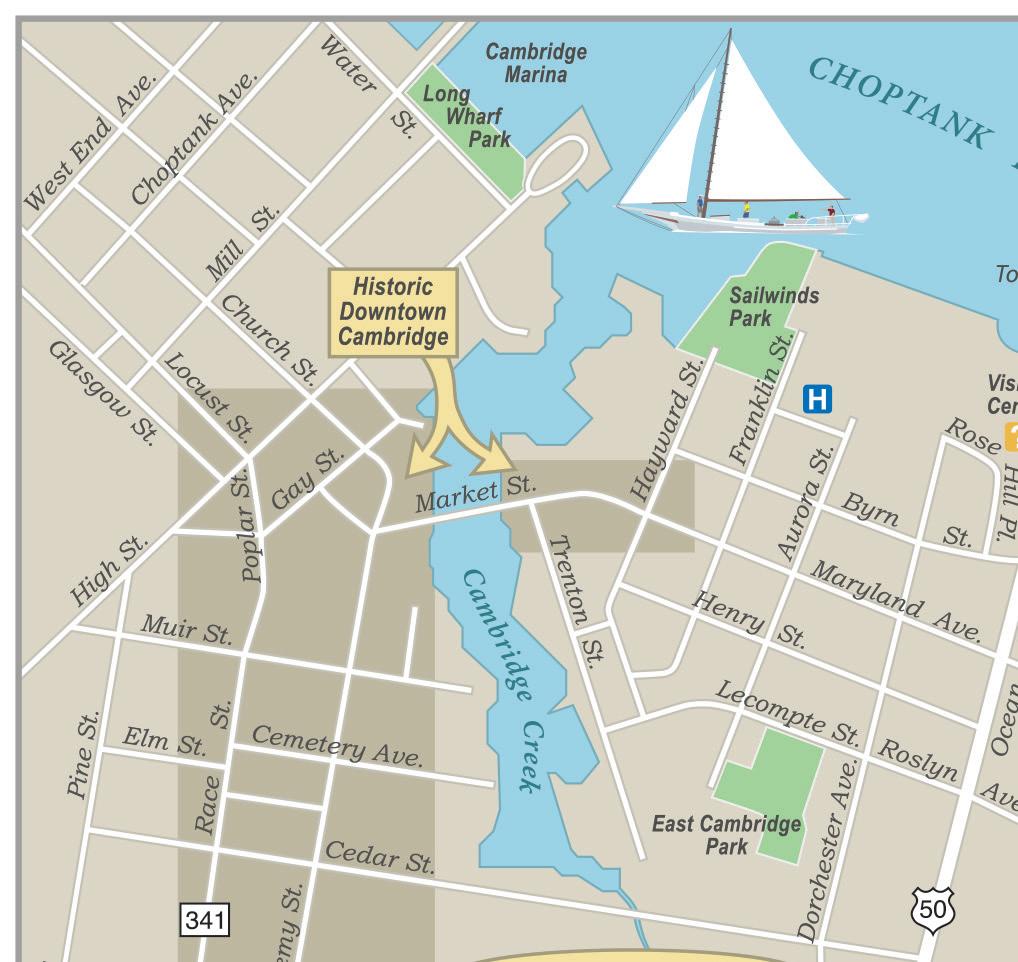



Dorchester County is known as the Heart of the Chesapeake. It is rich in Chesapeake Bay history, folklore and tradition. With 1,700 miles of shoreline (more than any other Maryland county), marshlands, working boats, quaint waterfront towns and villages among fertile farm fields – much still exists of what is the authentic Eastern Shore landscape and traditional way of life along the Chesapeake.
For more information about Dorchester County visit https://tidewatertimes.com/travel-tourism/dorchester/.


TIDEWATER GARDENING
by K. Marc Teffeau, Ph.D.

Crepe Myrtles in Bloom
Don’t Commit Crepe Murder
In late June and into July, the crepe myrtles are in bloom on the Eastern Shore. Depending upon the cultivar, the bloom period can extend into early September. Right
now, we are enjoying the color explosion of white, off white, pink, light red, deep red, wine red, magenta and purple flowered crepe myrtles on the Shore. If someone

Tidewater Gardening

would ask me what ornamental plant in the landscape I think should be the designated shrub/ tree of the South, I would have to say the crepe myrtle (Lagerstroemia indica). And yes, I do consider Maryland part of the South, though some of my Georgia friends might argue that designation!

We make construction

The blooming period of summer flowering woody ornamentals is influenced by the cultivar of the plant and the weather conditions. A wet, cool spring delays bloom time. If the spring is warm and dry, crepe myrtles tend to flower earlier. They sometimes are referred to as the “lilac of the South.” In my travels up and down the Eastern Shore of Virginia, I remember many crepe myrtles planted along the now-abandoned railroad track along highway U.S. 13. It is always a beautiful display. And of course,








Tidewater Gardening
we cannot forget the plantings at the U.S. National Arboretum.
Another nice aspect of crepe myrtles is the availability of different height cultivars. Crepe myrtle varieties can range in size from dwarf shrubs (3 to 5 feet) to small trees of 20 feet or more. Plants with three seasons of interest, crepe myrtles provide an interest-ing, mottled gray to tan to purple exfoliating bark in fall/winter, beautiful flowers in mid to late summer and a nice orange to red foliage in fall. Crepe myrtles can be used as specimen plants, in mass plantings, as an ‘allée’ and even as container plants.
This plant is popular in the landscape not only because of its appearance, but it is easy to grow. Although crepe myrtles prefer somewhat moist soil, they thrive in dry soil once they have become established. They need a mini-

mum of maintenance and care but need to be in full sun for the best flower production. The plant is also drought tolerant and grows in tough urban environments, making it a small tree substitute for some of the usually grown street trees.
The usual range of crepe myrtles is USDA Zone 7–9, but there are cold-hardy cul-tivars that will grow in Zone 6. The geographic range of the plant now is from the New England coast, throughout the MidAtlantic and South Gulf States, the Southwest and up the Pacific coast to Oregon.
The original crepe myrtle (Lagerstroemia indica) has an interesting history. Crepe myrtle is not native to North America, like many shrubs and trees in southern landscapes. The Lagerstroemia genus contains around 50 species of deciduous and ever-green trees and shrubs native to the Indian subcontinent, southeast Asia, China, Korea and northern Australia, In China, crepe myrtles are called “Pai Jih Hung,” meaning hundred days red for its beautiful color and long bloom season.
Why are crepe myrtles so popular in the South? André Michaux, plant explorer and botanist to King Louis XVI of France, introduced the plant from China to England and France in 1759. The problem was that the plant would not bloom. Being a plant from warmer areas of Asia, it was too cold in England and






Tidewater Gardening
France for it to form flower buds.
The story goes that Michaux then introduced the plant to the “Colonies” at that time in New Jersey and Pennsylvania. Again, the cold winter temperatures were a prob-lem for the survival of the plant. Not to be discouraged, Michaux then introduced the tree into Charleston around 1786, where it thrived. Michaux was reported to have sent trees from his nursery to the gardens of Thomas Jefferson at Monticello and George Washington at Mount Vernon.

In 1956, Dr. John Creech, USDA plant explorer and former director of the National Arboretum, found a Lagerstroemia species, L. fauriei , in a mountain forest in Japan. Seeds from these plants were sent to the National Arboretum. Dr. Donald Egolf crossed L. indica and L. fauriei , resulting in 31 new crepe




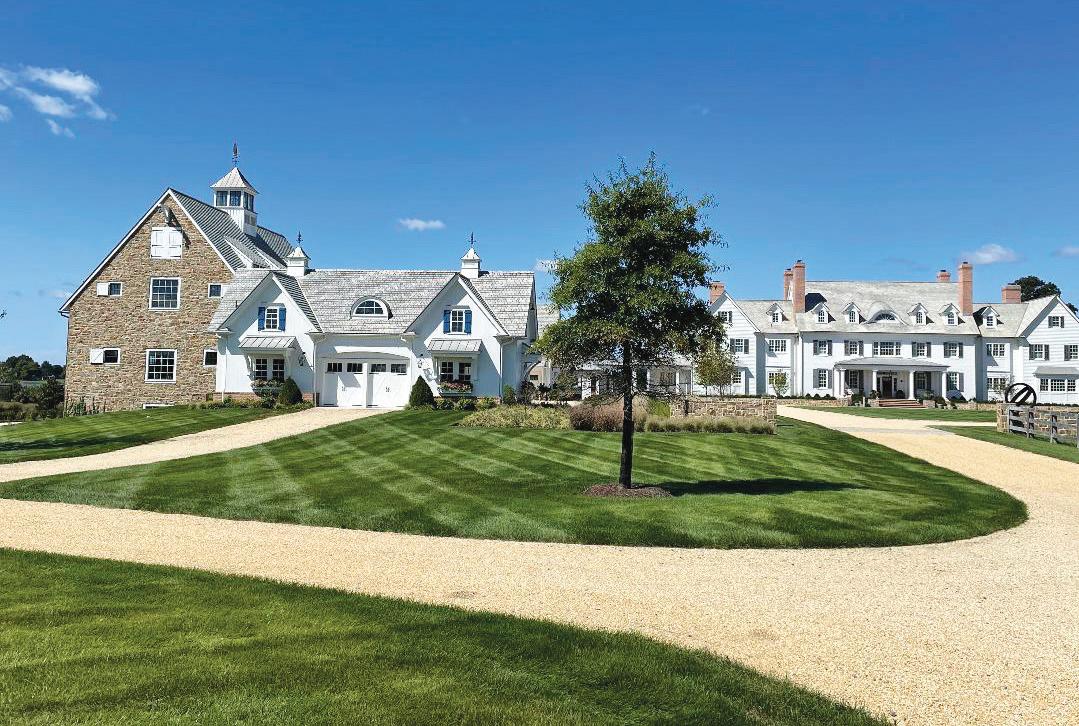
myrtle cultivars over the years. They were all given the names of Native American tribes.
Many of these cultivars found in the nursery trade are the result of the breeding work by the late Dr. Donald Egolf of the USDA ARS National Arboretum (USNA) in Washington, D.C. After his passing, the breeding work has been continued by Dr. Margaret Pooler at USDA ARS Beltsville, Maryland. Dr. Egolf and now Dr. Pooler developed new cultivars with enhanced disease resistance, increased cold tolerance, greater vigor and a broader spectrum of flower colors. In addition, crepe myrtle cultivars have been released from the University of Georgia breeding

program of Dr. Michael Dirr, now retired from University of Tennessee and LSU. Several commercial nurseries in the South have also released new cultivars over the past 20 years.
A nice chart of the early USNA releases can be found at ucanr.edu/ sites/default/files/2011-03/80608. pdf. There are close to 100 different cultivars of crepe myrtle available. UGA Extension Circular 944, Crepe Myrtle Culture, lists 63 cultivars based on mature size. A listing can be found at se-cure.caes. uga.edu/extension/publications/ files/pdf/C%20944_8.PDF, and you can find the complete listing of USNA crepe myrtle releases and information us-na.usda.gov/science/
ART IN THE GARDEN

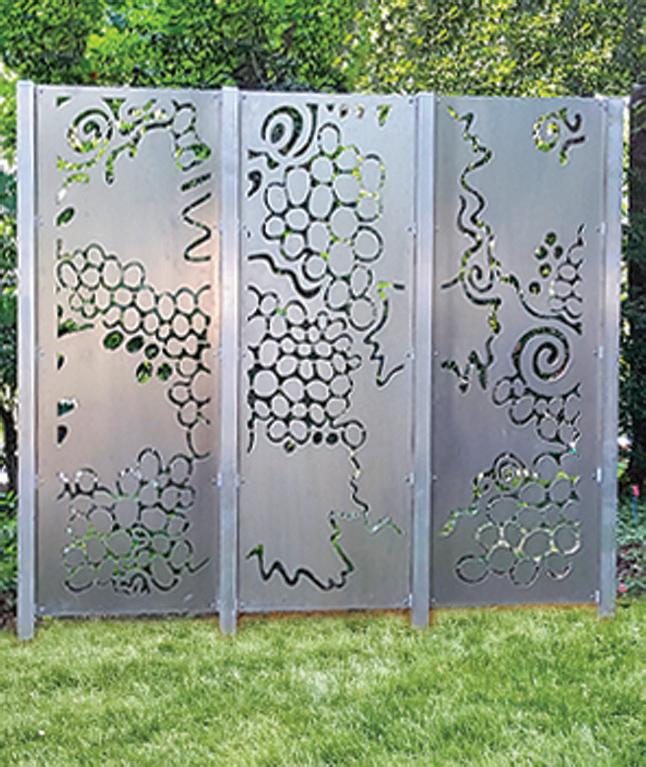
Tidewater Gardening
plant-introductions-and-releases/ plant-intros-common1/
The biggest issue I see with crepe myrtle care is that homeowners, and some commercial landscapers do not know how to properly prune them. Crepe myrtles flower on new wood produced in the spring. The correct time to prune crepe myrtles is when they are dormant in the late winter or early spring before new growth starts. I would also leave on the flower seed pods in the fall as American goldfinches, house finches and cardinals will feed on them.
According to the UGA Extension Circular 944, Crepe Myrtle Culture “It is a common misconception
that crape myrtles require pruning in order to flower. This is not only false but has also resulted in virtually millions of plants being pruned
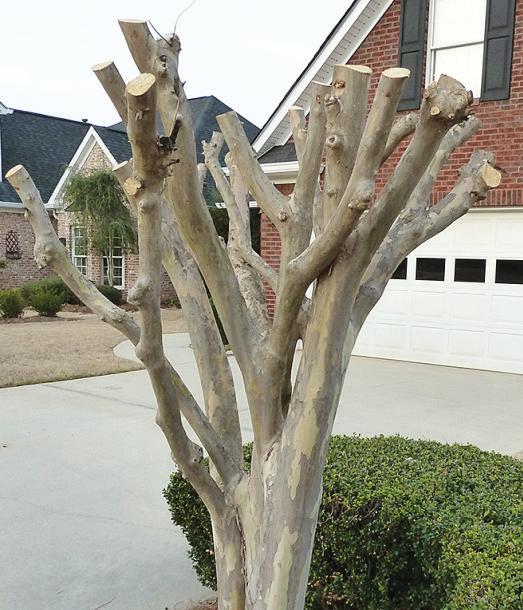

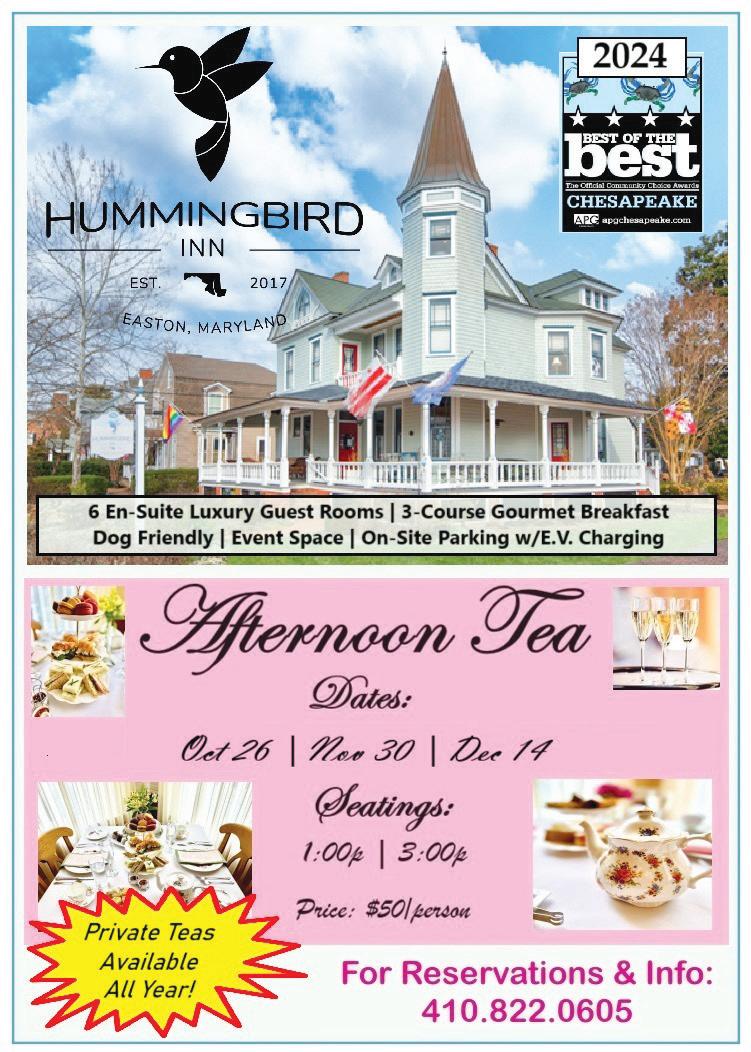
Tidewater Gardening
very aggressively, a practice commonly referred to as ‘crape murder.’ The most natural and beautiful crape myrtle trees result from limited or no pruning.
In addition, aggressive pruning leads to increased suckering (shoots arising from below-ground roots) which is not only undesirable, but it could result in powdery mildew spreading from the suckers to the canopy of the tree. Aphids are also attracted to succulent growth which results from aggressive pruning. It is far better to plant dwarf, or semi-dwarf varieties which grow to desired mature heights than to continue fighting with a more vigorous, larger cultivars planted in a too-small space.”
While we are enjoying the beauty of the crepe myrtles, there are some July gardening activities that we need to do. In the vegetable garden, seed more green beans for a late summer harvest. It is also not too late to do a planting of early

maturing varieties of sweet corn so you can extend your corn harvest season past Labor Day. Make a second planting of summer squash to extend the season and to replace plants damaged by squash vine borers. Cucumbers can also be planted for a fall harvest at this time.
I have found that it is sometimes challenging to find fall transplants for sale, so you usually need to grow your own. Broccoli and cauliflower especially do better as a fall rather than a spring crop. You will need to sow seed for fall transplants of broccoli, kale, and cauliflower in the 3rd or 4th week of July in peat pots, containers, or flats to have them ready for transplanting in September. Wait until August to start lettuce trans-plants. If you have not done so already, mulch the garden with straw to control weeds. The soil is warm enough now, and the mulch will provide some cooling of the soil that is of benefit to plant roots.
In your fruit plantings, July is the time to renovate your strawberry planting. Select the most vigorous strawberry plants for next year’s crop. Remove other plants, including runners, which developed over the last year to ensure that all the plant’s energy goes into the development of the primary plants. Cut the foliage 1 inch above the ground to eliminate insect and disease problems. Be careful not to cut the crown of the plant, how-ever. Fer-
tilize and water the plants regularly so they will set the flower buds for next spring’s crop.
In the landscape, be sure to deadhead or cut off the spent blooms of rhododendrons, lilacs and other spring-flowering plants. Deadheading will allow more of the plant’s energy to go into the production of flower buds for next year. July is an excellent time to divide and transplant iris, saving only the most vigorous ones. Discard any with any type of root or iris borer damage.
You can also divide and replant crowded, early blooming perennials now. Cut the first flowers of lavender to encourage a second crop. Also, try rubbing your hands with lavender leaves to remove strong odors, such as garlic or onion. Cut

back and fertilize delphinium and phlox to encourage the second show of bloom and stake tall perennials to keep from falling over.
Remove faded blossoms of annuals and perennials to keep them producing flowers. If some of your annuals have died, pull them out and add them to the compost pile. Get a second bloom from faded annuals by cutting back to approximately half their height, then fertilize with liquid fertilizer or 1/2 cup of 5-10-10 per square yard of the planted area and apply a generous layer of mulch. In mid-July, cut chrysanthemums and asters back halfway to encourage fall blooming. If you do not trim them back now, they will bloom later in July and early August and not in fall.
Happy Gardening!

Marc Teffeau retired as Director of Research and Regulatory Affairs at the American Nursery and Landscape Association in Washington, D.C. He now lives in Georgia with his wife, Linda.

























St. Michaels Map and History
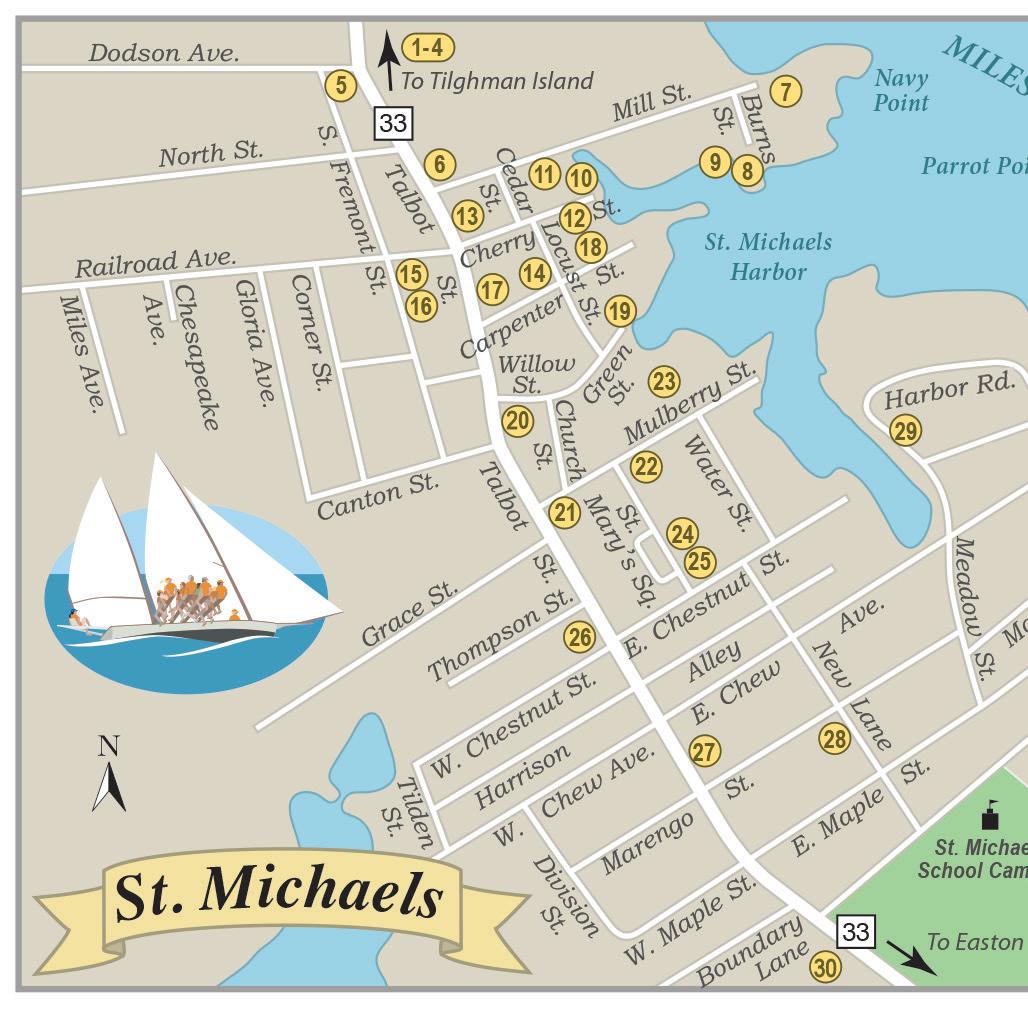


On the broad Miles River, with its picturesque tree-lined streets and beautiful harbor, St. Michaels has been a haven for boats plying the Chesapeake and its inlets since the earliest days. Here, some of the handsomest models of the Bay craft, such as canoes, bugeyes, pungys and some famous Baltimore Clippers, were designed and built. The Church, named “St. Michael’s,” was the first building erected (about 1677) and around it clustered the town that took its name.
For a walking tour and more history of the St. Michaels area visit https://tidewatertimes.com/travel-tourism/st-michaels-maryland/.

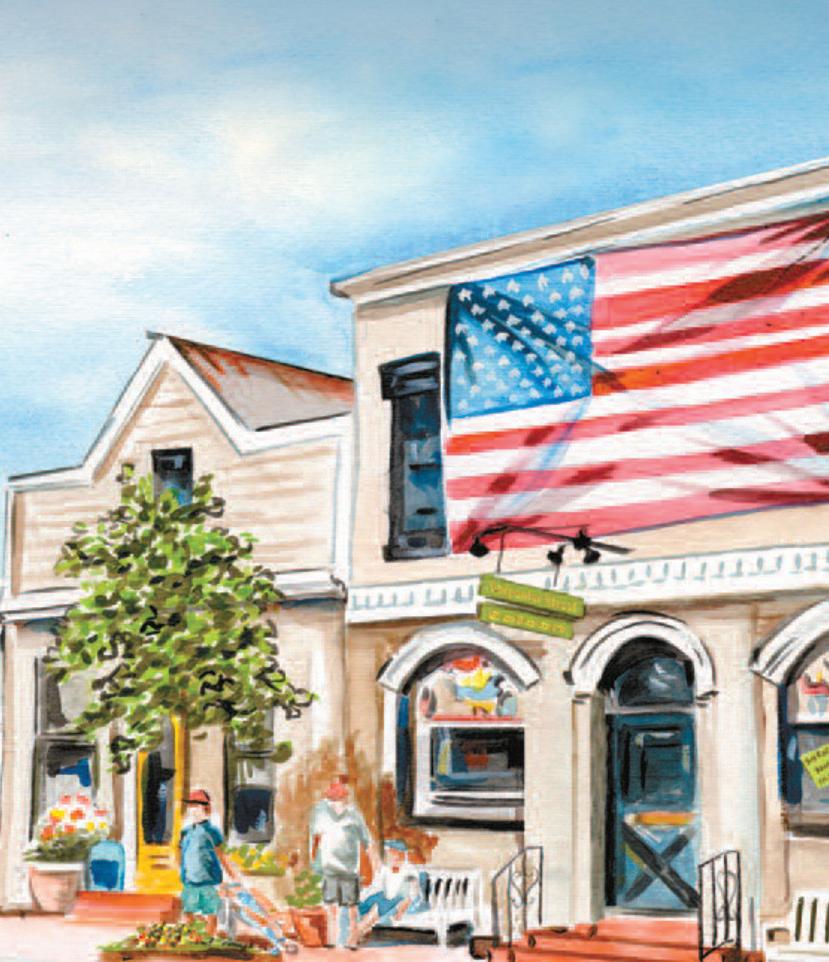
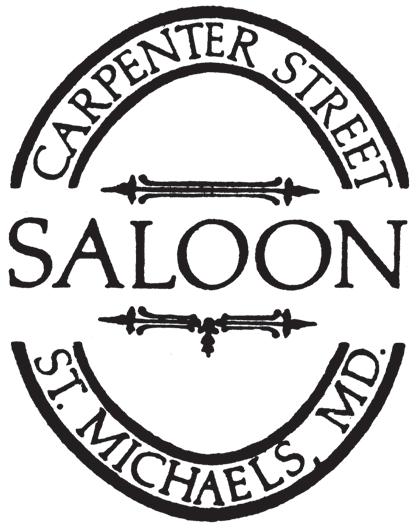

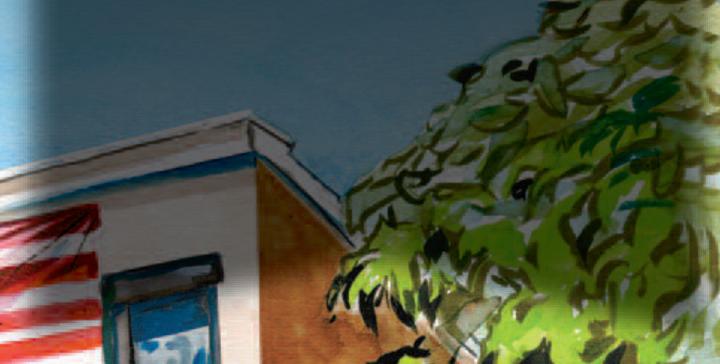

Confessions of a Word Nerd by A.M.
I once confessed to a group of writers that I read the Tribune’s guidelines, The Chicago Manual of Style , for pleasure—to which a friendly voice said, “Get a life.” At this early point in the article, I should warn anyone who never wonders about American language to “take a pass” (politely decline an offer or opportunity).
As an example of my guilty pleasure, I once thought my grandmother coined the word cattywampus , but not so. Research of its deep roots shows they extend over two hundred years—to her father’s favorite author, Charles Dickens, and beyond. It’s a Southern U.S. variation of catawampus, usually meaning “askew.” Incidentally, in Appalachian folklore a wampus (or wompus) is a mythical beast. As to its untraceable etymology, maybe the Scotch-Irish just liked the sound of wampus.
Ma, my grandmother, didn’t abide backtalk, lip or sass from any little whippersnapper. In my dotage now, I can’t recall being so labeled by Ma, but I believe a certain high school teacher accused me, among others.
Whippersnapper derived synonymously from snippersnapper,
Foley

which dated one hundred years earlier, to 1590.
I remember another term Ma had to explain to me. She, who never drove a car, said something about her son-in-law one Sunday to the effect that, “If your father doesn’t come home soon, I’ll have to go to church by Shank’s mare.” She didn’t expound on where she got the term, but it’s Scottish, going back hundreds of years, referring to the lower leg (shank). I don’t know why it’s so often capitalized. Ma probably never knew that in lower case, shank is penitentiary slang: a noun denoting an improvised knife. (In that sense, shank can also be used as a verb.)
Before my time, Ma had migrated from the foothills of Virginia’s Blue Ridge Mountains to Washington, D.C., where alleyways ran between
streets. A smallish man from the next street over often passed our kitchen window by Shank’s mare, with something of a strut. He lived so far down the adjoining block as to remain nameless to us, but seeing him always reminded us of Ma saying, “That man looks like a little banty rooster.”
Banty is Southern for bantam, little chickens with feisty personalities. In a recent article titled “Beloved Banty Birds” for Smoky Mountain Magazine , Renea Winchester says a bantam is, “a bird you don’t want to mess with. A true banty rooster will land atop your head and flog the ever lovin’

puddin’ out of you; especially if he thinks you’ve offended his beloved soulmate.” (Her grandfather’s rooster grieved inconsolably after losing his last hen, until Renea’s Poppa found him a suitable mate.)
Closed Tuesdays
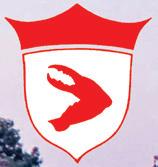
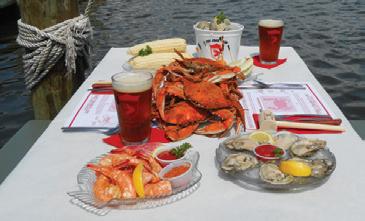

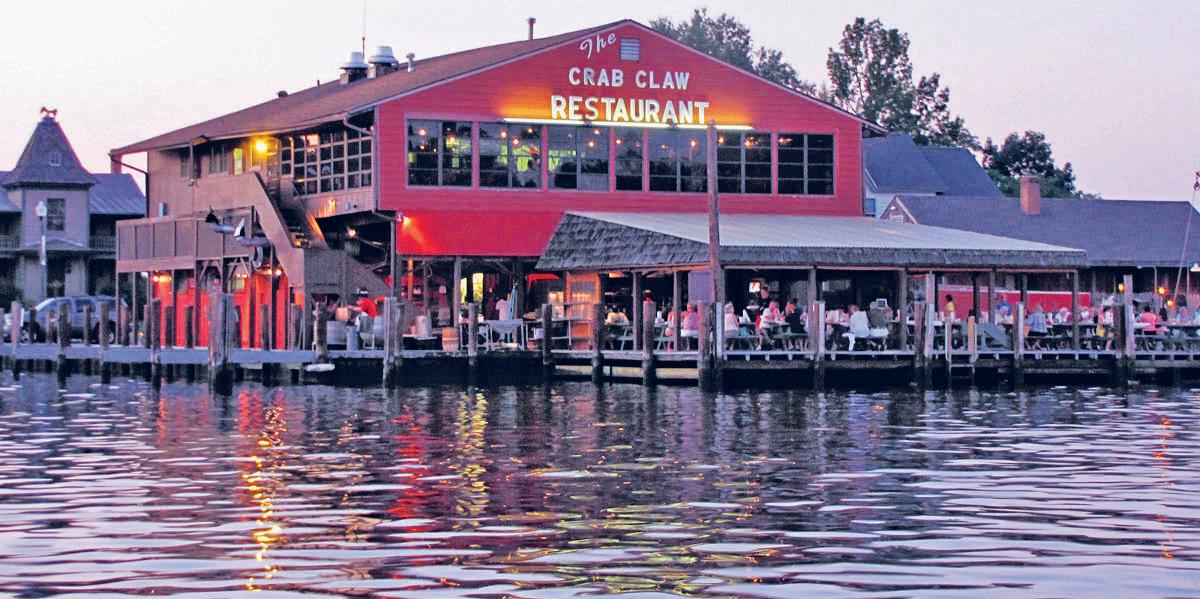

Unlike such winged creatures, according to UselessEtymology. com, dingbat originated in 1838 as an alcoholic drink. (I’ll look for a recipe.) Early on, it morphed into a synonym for thingamabob, gizmo, or doohickey. Then, over the next 150 years, dingbat came to mean a muffin or a typographical doohickey. In plural, it referred to a paired feature of the male anatomy. Currently, it’s still used in typography, but generally a dingbat is a fool.
Sorry, I can’t seem to find an authentic 1838 recipe for a Dingbat cocktail, but a formula is widely available for a Mongolian Dingbat—evolved from a drink dubbed Edith Bunker. You’ll likely want a bartender rather than a home

recipe for an Edith Bunker, which requires rye, orange juice, bitters, Lillet Blanc and Luxador. Now I



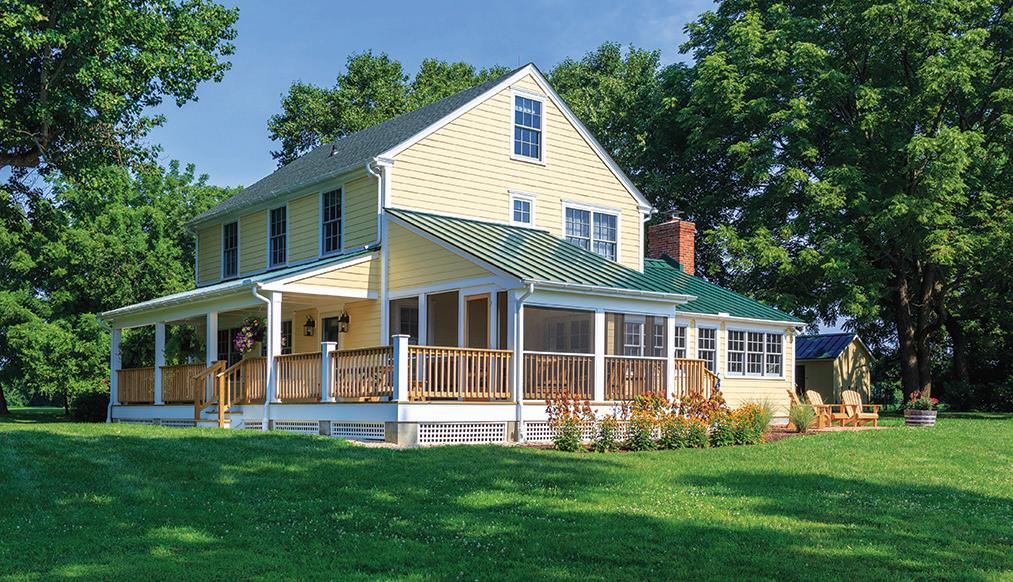

Oxford Map and History
Oxford is one of the oldest towns in Maryland. Although already settled for perhaps 20 years, Oxford marks the year 1683 as its official founding, for in that year Oxford was first named by the Maryland General Assembly as a seaport and was laid out as a town. In 1694, Oxford and a new town called Anne Arundel (now Annapolis) were selected the only ports of entry for the entire Maryland province. Until the American Revolution, Oxford enjoyed prominence as an international shipping center surrounded by wealthy tobacco plantations. Today, Oxford is a charming tree-lined and waterbound village with a population of just over 700 and is still important in boat building and yachting. It has a protected harbor for watermen who harvest oysters, crabs, clams and fish, and for sailors from all over the Bay. For a walking tour and more history visit https://tidewatertimes. com/travel-tourism/oxford-maryland/.
really should look up the last two ingredients and search for Edith’s connection to Mongolia.
The many TV spin-offs from Edith’s smash hit show, “All in the Family,” can’t compare to the number of words spun from jibber-jabber, jargon, gibberish, and gobbledygook . Which came first? Hard to tell. Originally, gibberish was a pejorative term derived from gypsies speaking Romani or Domari dialects, unintelligible to outsiders. Jargon has indicated language specific to a profession or sect since the 17th century. Jargonaught (one using too much jargon) is of 21st-century origin.
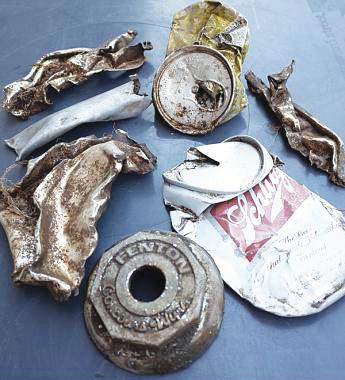
Metal-detecting hobbyists use jargon for items they unearth. National Public Radio’s “Way with Words” featured a sampling, such

as canslaw (aluminum can shredded by a mower); coinball (lump of dirt with a coin inside); and rubar (rusted beyond all recognition). Salisbury author Andy Nunez speaks the language and contributes authoritatively to publications interested in wheaties, Rosies, and shinys : wheatback pennies, Roosevelt dimes, and other silver or shiny objects. The aptly named YouTube.com site, “Hoover Boys,” is available for a deep dig into the culture.
In today’s multimedia age, jargon and catch phrases spread easily. One indelible phrase endures from back in the day when print reigned alone. The phrase compares an item’s quantity to “more
than Carter has (liver) pills.” Samuel J. Carter’s advertising genius dates to 1868, when he patented Carter’s Little Liver Pills. His trademark black crow and singlecelled cartoon ads originally appeared in newspapers and magazines, then survived into the eras of radio and early television.
Carter’s pills were claimed to cure discomforts from head to nether regions by increasing the flow of bile from the liver. After decades of printed drawings depicting domestic situations righted by Carter’s pills, radio chimed in—a deep voice urging “Wake up your liver bile!” Musical jingles hinted that Carter’s eliminated hangovers, “when you feel sour
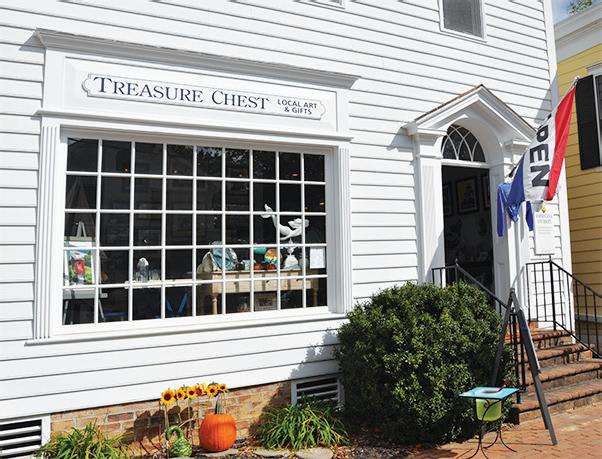
The Treasure Chest



and sunk, and the world looks punk…” The Federal Trade Commission searched for years, but found no medicinal effect the pills had on the liver. Carter’s company was required to drop “Liver” from its tradename. Now once-ubiquitous advertising is heard no more, but “Carter’s Little Pills” still occupy a quiet niche in the marketplace.
Not so long ago, Robert Byrd became the U.S. Senate’s longest serving incumbent. He won re-election in 2000 and crowed, “West Virginia has always had four friends: God Almighty, Sears Roebuck, Carter’s Little Liver





Find your dream boat.





Pills, and Robert C. Byrd.” Fiftysome years in office prove he knew how to talk to his constituents. Presumably, they would have recognized a rapscallion or scalawag.
Another patent medicine surviving from the 1800s is Moxie, a beverage still popular in New England. Appropriately, moxie came to mean “spunk.” Agustin Thompson began marketing “Moxie Nerve Food” in 1876, a remedy for “paralysis, softening of the brain, nervousness, and insomnia.” In 1884, Moxie was bottled as a wholesome alterna-
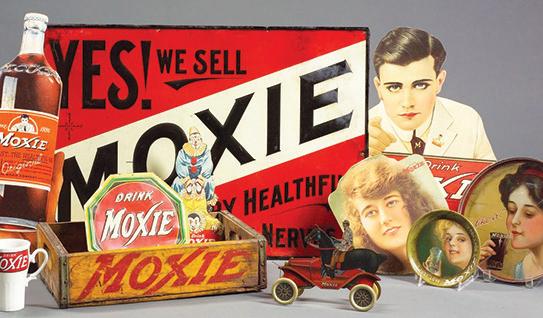
tive to nostrums which, at that time, contained alcohol (Lydia Pinkham’s for ladies’ complains) and cocaine (Coca-Cola, for impotence and morphine addiction).
Coke ads in 1886 touted the “intellectual beverage” as a temperance drink to combat “sick-headache, neuralgia, hysteria, melancholy, etc.” The Coca-Cola Company removed cocaine from their formula
in 1903, leaving a copious amount of caffeine, since reduced.
For muscular complaints, a Wheeling, West Virginia, newspaper attempted in 1880 to explain the origin of charley horse , attributing the term to a baseball player named Jack Glasscock. Supposedly Glasscock once limped home to the family farm, where his father compared his gait to their lame plow horse, Charley. Other wordsmiths credit different baseball players from different clubs: Chicago White Stockings, Cubs, Baltimore Orioles and others. In any case, since dehydration contributes to charley horses, all legends involving the summer pastime contain a germ of truth.
Tidewater Residential Designs since 1989
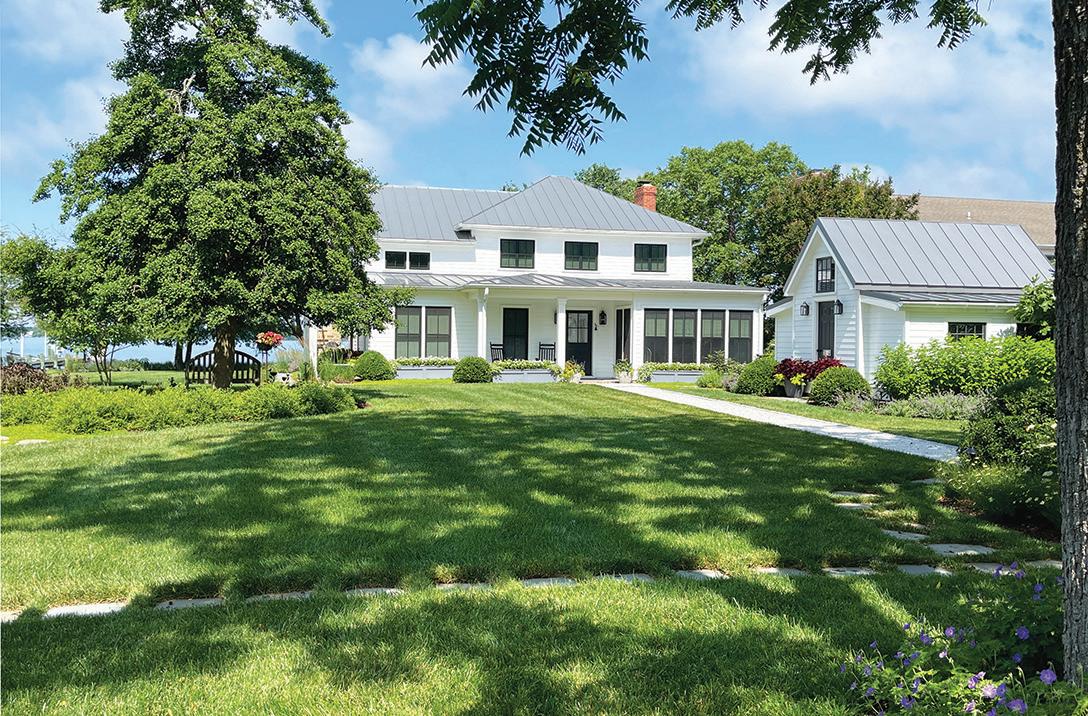

In the Old West, cowboy sidekicks Gabby Hayes and Fuzzy St. John seemed especially prone to being bamboozled or hornswoggled , but the twin terms for “duped” predate Texas. In 1710 Irish author Jonathan Swift cited bamboozled as an example of new words sullying the English lan -
guage. Over a century later, hornswoggled appeared in a glossary of Americanisms in Virginia Literary Magazine ’s 1829 edition, citing Kentucky as hornswoggle’s place of origin. The etymology of both words is elusive.
There’s no doubt about the etymology of poppycock , meaning nonsense. It surely derives from the Dutch dialect pappekak , literally “soft dung.” Merriam-Webster Dictionary dates the first known English use of poppycock to 1852. Among a slew of synonyms M-W cites: trash, tommyrot, tarradiddle, tosh, twaddle, and trumpery (lower case, Middle English). Among other listings debuting in 1852: donnybrook, feminist, folksy, Groundhog Day, hog heaven, jimjams, lager, nightlife, scrapple, sheet music, and zip.
Over centuries, fencing jargon successfully crossed the channel from France to invade standard English usage. Along the way, fencing terms have become pacified into metaphors: a foible


(weaker portion of a blade) became a minor flaw in character; forte (blade’s stronger portion), a personal asset. Some bi-lingual Brits might insist on pronouncing forte in its blade-related sense as fort , à la the French, reserving for-tay for its piano forte sense. Learned Americans accept for-tay for both strong characteristics and loud music. Among other words derived from fencing are feint (movement to distract), flick, parry (evade), en garde, touché, and riposte (a quick, witty retort—not a missed comeback thought of later).
Anyone still reading at this point might enjoy the aforementioned UselessEtymology.com .
Among other things, it will explain how electricity entered the language a century before Benjamin Franklin flew his kite and “discovered” it. (The pun-averse might want to take a pass on this website.) The Dictionary of Clichés is a similar hangout for word nerds. Apparently, I’m not alone.

Forty-some years ago, A.M. Foley swapped the Washington, D.C. business scene for a writing life on Elliott Island, Maryland. Tidewater Times kindly publishes Foley’s musings on regional history and life in general.
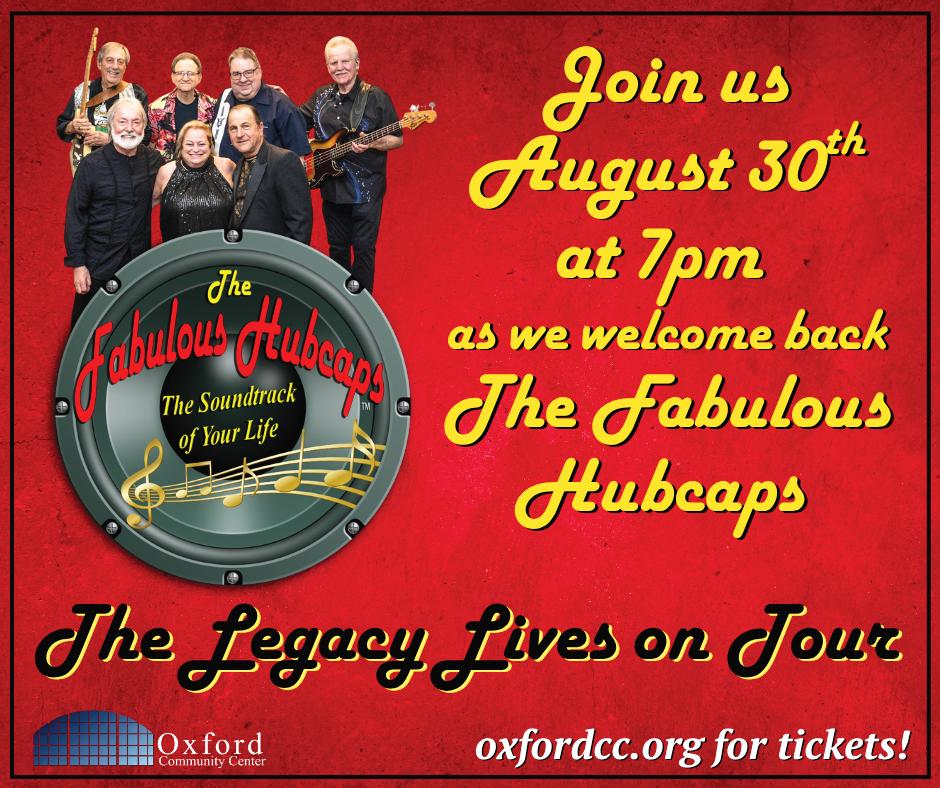



Farm Fresh in a Flash
With seasonal vegetables at their peak, the farmers market is the ultimate convenience store. Overflowing with just-picked produce—ripe tomatoes, sweet corn, snap peas, crisp beans and vibrant peppers— these market finds make healthy eating not only effortless but irresistibly delicious.
This is the time to let fresh ingredients shine in fast, flavor-packed dishes that don’t sacrifice nutrition for speed. Think Grilled Steak with a Chopped Summer Salad or Chicken, Asparagus, Corn and Quinoa Salad with Feta. Each dish is designed to deliver maximum taste with minimal prep.

Tidewater Kitchen indulgent, satisfying and ready in a flash.
Whether you’re planning a light lunch or a satisfying dinner, these meals celebrate the simplicity of seasonal cooking: Chilled Zucchini Soup and even a surprisingly refreshing twist like Pasta with Fresh Mozzarella, Roasted Tomatoes and Garlic Chives.

Smart Tips for Fresh Success:
• Buy what looks best and talk to the farmer to learn what is locally grown, then plan. Let the season of the market guide your menu. Being flexible means you’ll always get the freshest picks.
• Keep your pantry well stocked. Whole grains like quinoa, brown rice, farro, chickpeas, black beans, almonds, pumpkin seeds, walnuts, and apple cider and balsamic vinegars turn produce into meals in minutes.
• Layering flavors simply by adding fresh herbs, citrus zest or a drizzle of balsamic vinegar elevates even the quickest preparations.
This collection of recipes proves that healthy, seasonal food can be
Grilled Steak with Chopped Summer Salad Serves 6
2 large garlic cloves, pressed
1-1/4 teaspoons coarsely ground black pepper
1-1/4 teaspoons pink Himalayan salt
1 2-pound, 1 ½-inch-thick top sirloin steak
Olive oil spray
1 cup diced tomatoes
1 cup baby arugula, my favorite is from Larry at the Easton Farmers Market
½ cup red onion ,diced ½ cup crumbled feta cheese or your favorite cheese
3 tablespoons chopped pitted Kalamata olives
1-1/2 tablespoons extra-virgin olive oil
1 jalapeño, seeded, finely chopped

(about 4 teaspoons), optional, or your favorite colorful sweet pepper
Mix garlic, pepper, and 1 ¼ teaspoons salt in small bowl; rub all over steak. Let stand at room temperature 1 hour.
Coat barbecue grill with olive oil spray. Prepare barbecue (mediumhigh heat). Grill steak until charred and cooked to desired doneness, about 7 minutes per side for medium rare. Let rest 10 minutes.
Mix tomatoes and all remaining ingredients in medium bowl. Season to taste with salt and pepper. Thinly slice steak against the grain and arrange on plate. Spoon salad over steak and serve.
Pasta with Fresh Mozzarella, Grape Tomatoes and Garlic Chives Serves 4-6
10 ounces your favorite pasta (about 3 cups uncooked)
1 pound pea-sized mozzarella or fresh mozzarella, diced
1 pound grape tomatoes or pear tomatoes in assorted colors, halved
6 tablespoons extra-virgin olive oil
3 tablespoons balsamic vinegar or your favorite
3 tablespoons minced fresh garlic chives or regular chives
2 tablespoons minced fresh oregano
Cook pasta in large pot of boiling salted water until tender but still firm to the bite, stirring occasion-

ally. Drain; return pasta to pot. Add mozzarella; stir until cheese begins to melt, about 30 seconds. Roast the tomatoes. Roasting them brings out the flavor. You can

www.piazzaitalianmarket.com
cut them in half and place them on a sheet pan. Roast at 425 degrees for 20-25 minutes. Feel free to use uncooked tomatoes as well and cut in half. Add all remaining ingredients; toss to blend evenly. Season to taste with salt and pepper.

Garlic chives add a mildly garlicky flavor to this simple pasta, which is loaded with little tomatoes and tiny pearls of fresh mozzarella cheese. The pea-size mozzarella can be found at Trader Joe’s and wellstocked supermarkets.
Chicken, Asparagus, Corn and Farro Salad with Feta Cheese
4 Servings
1 cup quinoa, you can use rice or farro as well
3 tablespoons extra-virgin olive oil
8 ounces skinless boneless chicken breast halves
12 ounces asparagus, trimmed, cut into bite-size pieces or cucumber if asparagus isn’t in season, or snap peas

2 cups fresh yellow corn kernels (cut from 2 to 3 ears of corn)
3 green onions, thinly sliced
1 tablespoon basil, thinly sliced
½ teaspoon Himalayan salt
1 tablespoon apple cider vinegar
1 clove minced garlic
1 teaspoon local honey
3 tablespoons extra-virgin olive oil
4 ounces feta cheese, crumbled
Cook quinoa in medium saucepan of boiling water until all the water evaporates, 20-25 minutes.
Heat a tablespoon of olive oil in a cast iron pan or heavy medium skillet over medium-high heat. Add salt and pepper to the chicken. Place the chicken in the pan; cook until golden brown and the juices run clear.
It will be about 8 minutes per side. Cool, and cut into bite-size cubes. Snap the ends off the asparagus. Then cook in a large saucepan with salted water until they are tender and crisp, about 4 minutes. Drain and place in an ice bath. Place on a kitchen towel and pat dry. If using cucumbers, peel and cut into bite size pieces, or snap the peas.
Mix quinoa, chicken, asparagus, corn, basil and onion in a large bowl. Combine the olive oil, garlic, apple cider, honey and salt in a bowl and whisk. Add on top of the salad. Add your crumbled feta. Prep Tip: you can do this a day ahead. Cover and chill until ready to use.
Divide into individual containers as a meal prep plan or serve on

plates, either chilled or room temperature. Enjoy!
Chilled Shrimp and Zucchini
Soup with Cilantro Cream
4-6 servings depending on whether it is a first course or the main dish
Cilantro Cream
½ cup Greek yogurt
2 tablespoons chopped cilantro
1 teaspoon red pepper flakes
Himalayan salt to taste
Shrimp:

1 pound medium peeled cooked shrimp 2 tablespoons fresh lemon juice and 1 tablespoon zest

1 tablespoon olive oil
1 teaspoon cumin Soup:
2 tablespoons extra-virgin olive oil
1 medium onion, diced, about 2 cups
3 garlic cloves smashed
3 medium zucchini, diced
3 medium squash, diced
4 cups chicken bone broth or vegetable broth
3 tablespoons coarsely chopped cilantro
Cilantro Cream: Whisk Greek yogurt, cilantro and garlic in small bowl to blend. Season with salt and pepper. Meal Prep: you can do this a day ahead, cover and chill.
Shrimp: Combine all ingredients in a medium bowl. Cover and chill at least 4 hours or overnight. Meal Prep: You can do that a day ahead to blend the flavors.





Soup: In a heavy pot, heat the oil. Sauté the onion for about 8 minutes, until translucent and golden brown. Then add the garlic and stir quickly for 1 minute so it doesn’t burn. Add the zucchini and squash, mix together. Stir in the broth, bring to a boil and then reduce heat to medium and cover on simmer until zucchini is tender, about 10 minutes. Cool to lukewarm. Add chopped cilantro. Working in batches, puree soup with blender or emulsion blender.
Transfer soup to a large bowl. Taste to see if you need to add more salt or pepper. You can serve at room temperature or cover and cool in refrigerator for about 4 hours if you want to serve it chilled. When serving, divide the soup among the bowls you are using. Divide the shrimp among the bowls. Place a dollop of cilantro yogurt cream on the top, and garnish with a sprig of cilantro. Enjoy.
Pizza with Goat Cheese, Prosciutto, Figs and Arugula
Serves 4
1 pound pizza dough, either homemade (I love my sourdough dough ball) or packaged pizza dough
Cornmeal to sprinkle on the baking sheet so it doesn’t stick 2 cups crumbled goat cheese
8 small fresh figs, cut into bite-size pieces (I also love Chef Mark “Salter’s Chesapeake Gourmet” Fig Jam)
8 thin slices prosciutto 2 tablespoons balsamic vinegar 1 tablespoon extra-virgin olive oil 8 cups arugula
Preheat oven to 450 degrees. Sprinkle large rimless baking sheet or a pizza stone generously with cornmeal. Roll out dough on a floured work surface to a 12x10 inch rectangle, transfer to prepared sheet. You can also place this on a hot grill and grill for 4 minutes per side to blind bake it or in a hot oven for the same amount of time. Sprinkle the goat cheese over the lightly baked dough. Place the fresh figs in a bowl and drizzle with balsamic vinegar. Instead you can use Chef Salter’s Fig Jam. Set aside.
Place pieces of prosciutto slices and arrange the sliced figs to cover the pizza. Bake pizza until toppings are golden brown, about 12-14 minutes. Transfer the pizza to a cutting board, cut into pieces. Place on a serving platter or leave on cutting board. In a bowl, whisk olive oil and vinegar together and add the salad to coat. Sprinkle with salt and pepper to taste. Mound a salad on top of the pizza and serve.

Pamela Meredith, formerly Denver’s NBC Channel 9 Children’s Chef, has taught both adult and children’s cooking classes.
For more of Pam’s recipes, visit the Story Archive tab at tidewatertimes.com.











When The Old Choptank Bridge Was New
by James Dawson
The Choptank River serves as a convenient boundary that separates the Upper Eastern Shore from areas below, but until it got a bridge, the river proved to be an inconvenient barrier for land traffic. The neck of land between Bolingbroke Creek and Howell’s Point Road was named Ferry Neck because a ferry to the Dorchester shore had been in operation there as early as 1670. Henry Bullen was granted a ferry across the Choptank River in 1722, and William Akers operated the ferry from 1768 to sometime before 1812. He is believed to have lived in Ferry House, which he operated as an ordinary or inn. Ferry House still stands near the base of the old bridge.
On December 6, 1784, Rev. Thomas Coke had a close call on Aker’s Ferry while crossing the Choptank River on his way to preach at the Methodist chapel at Bolingbroke. As he recorded in his journal, “I had this morning a great escape in crossing a broad ferry [across the Choptank River from Cambridge]. After setting off, Harry persuaded me to return back and leave our horses behind us, to be sent after me the next day, on account of the violence of the wind.

Choptank bridge construction 1935
Choptank Bridge
I have hardly a doubt but we should have been drowned, if we had taken that step. We were in considerable danger as it was: and if my heart did not deceive me, I calmly and sincerely prayed that GOD would drown me and take me to himself, if the peculiar work in which I am engaged, was not for his glory” [The Journal of Thomas Coke, Bishop of the Methodist-Episcopal Church from September 18, 1784 to June 3, 1785 in The Arminian Magazine; Pritchard & Hall; Phil.; 1789; pps 288-289].
Rev. Coke had taken Aker’s ferry, which was located somewhere near the present Choptank bridge, but there had been other ferries at Howell’s Point, Chancellor’s Point, Jamaica Point and Chlora’s Point. Some lasted only a short time, and ferry service there appears to have been discontinued by 1885, possibly because the steamboat service to nearby Kirby’s Wharf, Trappe Landing, Windy Hill and Chlora’s Point was more convenient.
Locals also had the options of sailing or even rowing across the river, like the young Frank “Home Run” Baker from Trappe did when he was courting his girlfriend who lived in Cambridge. Or you could even ride on your horse or walk across the ice when the river froze over.
By the 1920s, with the coming of the automobile, a bridge was becoming a necessity, not just a convenience. It was Sen. George Radcliffe’s dream that there would be a bridge across the Choptank by Cambridge. As a native of Dorchester County, he knew what a boon to the local economy it would be.
In the fall of 1931, a committee consisting of Gov. Emerson Har-
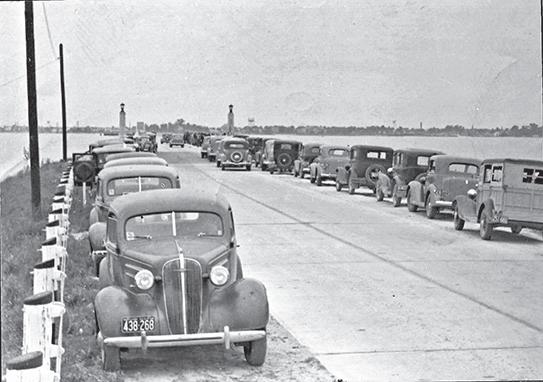









Choptank Bridge
rington and others appeared before the State Roads Commission asking that the state build a bridge across the Choptank from Cambridge to the Talbot County shore.
The request was generally well received. There were a few protests at the public hearing, but they were withdrawn. By September 1933, with the approval of the plans by the War Department, there would be a signal for an immediate start on the bridge and bids were requested for the 1.7-mile-long construction project.
Fred Snare Corporation of New York was the successful bidder at $947,676.45, but with the cost of
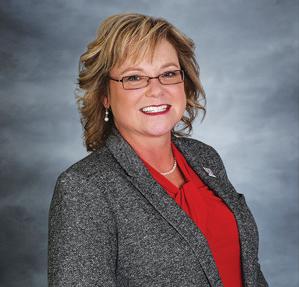
cement and other materials supplied by the highway department, the total cost would be $1,125,000. And that’s 1934 money.
Construction started in March 1934, and about 200 men from the area were hired (about 25% of the workforce was from Talbot County) which was great news as the Great Depression was still in force and jobs were scarce. By November, concrete was being poured steadily onto the skeleton of steel and timber. The work started on the Dorchester side. Thousands of cubic yards of cement were molded into piles at a plant set up on shore.
Three fixed spans about 265 feet long with a 265-foot swing span








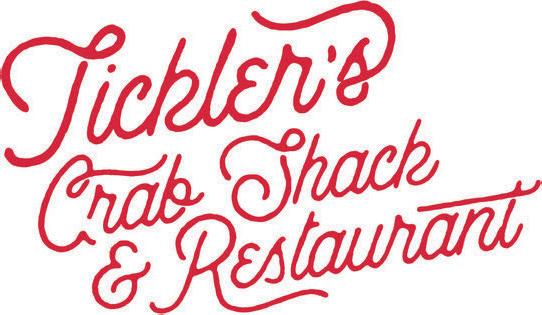
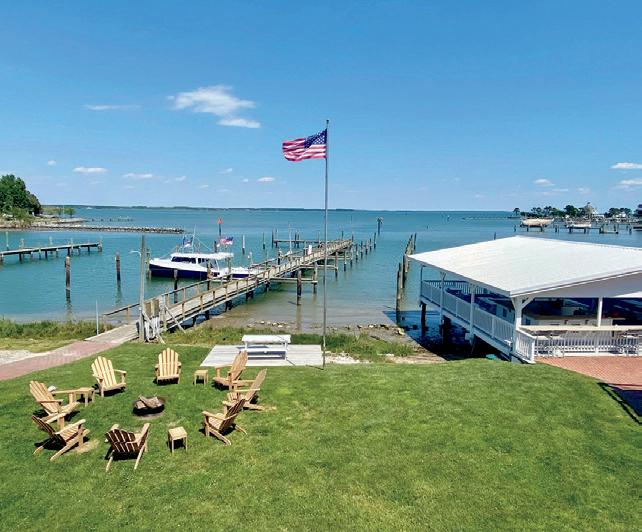
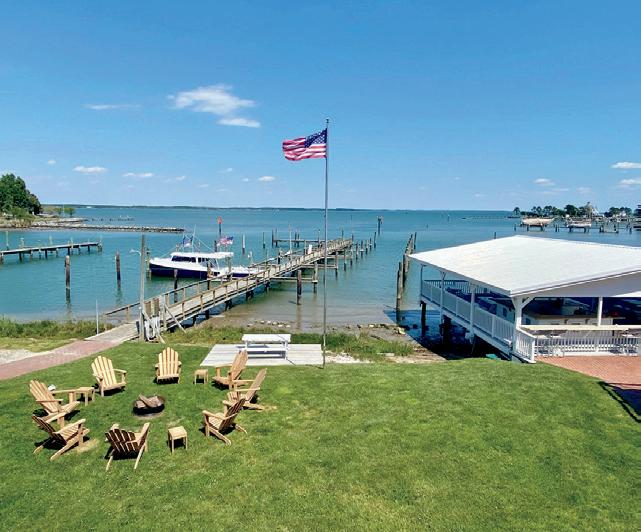


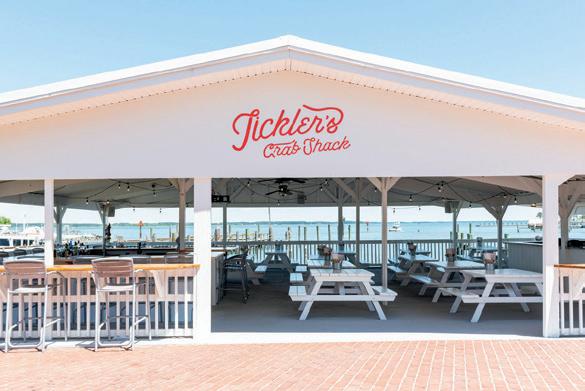
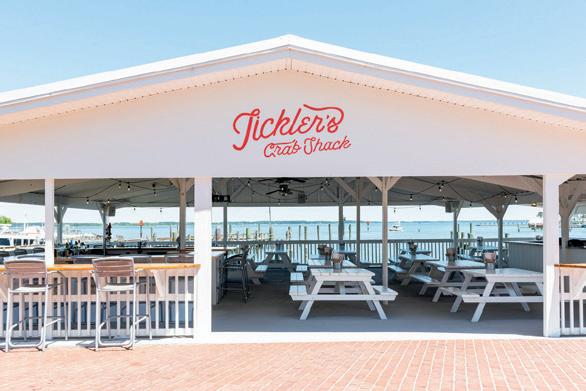
would permit navigation. Some 850 concrete piles, two feet square and 50 feet in length, would be used, along with about 5,000 tons of structural steel. Newspapers sometimes mistakenly called it a draw bridge, but it was a swing span operated by the bridge tender. Also, an improved road would be needed
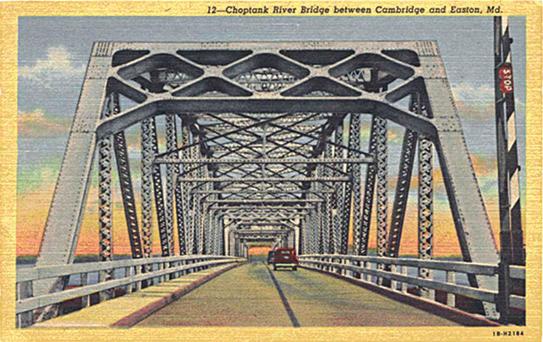

on the Talbot side from Scott’s A.M.E. Church at Trappe to the Bowdle Highley farm on the river.
We will be hearing more about Bowdle Highley. Coincidentally, he lived at the old Ferry House conveniently located near the old Cambridge ferry landing where travelers once stayed the night. Now, Highley would be conveniently located next to the new bridge.
In August 1934, labor trouble in the west delayed shipping materials. Nearly 80 piles had been driven by then, with many more to be driven. By April 1935, work had started on the new road from Trappe to the old ferry landing where the bridge was located. Ravines were filled and many of the kinks in the old road were straightened for the 4 ½-mile Talbot approach. Meanwhile, work on the road and the bridge was progressing. About 2,000 feet of concrete was poured on the road, and all but three of the steel tiers on the bridge were in place.
There was even talk about a dual highway coming to Easton by 1937, and it was noted that the proposed dual highway and some new roads and smaller bridges would give practically a straight shot from Cecil County, past Easton, dropping like a plumb bob down the Shore like a straight line to Ocean City. That would happen, but the 1937 date turned out to be somewhat optimistic by about three decades, what with the war and all. And, of
Choptank
course, in 1952, the bridge across the Chesapeake Bay would bypass Cecil County and shorten the distance for those coming from the western shore.
According to a March 1, 1935, article in the Easton Star Democrat, people from Dorchester put commercial interests first and were keen for the bridge, while those from the Talbot side were more socially oriented. The writer even suggested that with the coming of the bridge that some might want to have their businesses in Dorchester County but live in Talbot. But wherever you lived on the ’Shore, the economic impact
of the bridge would be undeniable.
As the Star Democrat put it, “The bridge will be a chief link in the Maryland State Highway system, and promises to play an important role in the development of the Eastern Shore generally” [Easton Star Democrat July 19, 1935]. That prediction would prove to be somewhat of an understatement!
When the Emerson C. Harrington bridge was dedicated on October 26, 1935, it was a really big deal. At 8,747 feet long and 70 feet wide, it was the longest bridge in the state. It even boasted a sidewalk for foot traffic and fishing. People came from everywhere for the ceremony. Even the President of the United States attended.
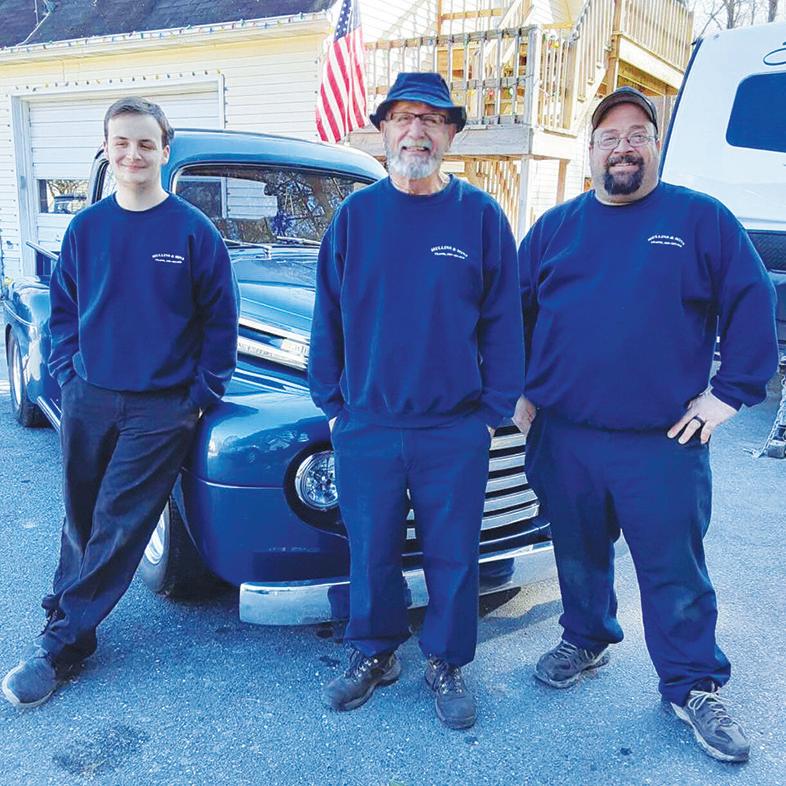
3 Generation Family Run Auto Service Shop with over 31 years experience. Offering a wide variety of services to include but not limited to: Brakes, Diagnostics, Tire Rotation, Rv & Trailer Repair, Heating, and Basic Services. Specializing in Transmissions. Reasonable Rates!

SLOT DOCK
Perfect for Kayaks and Paddleboards

• Kayak Docks
• Re-Decking
• Pressure Wash & Seal
• Boat Lifts, PWC Lifts
• Gangways
• Solar Dock Lighting
• Floating Piers
• Rowing Docks
• Kayak Racks
• Ladders
• Dock Boxes
• Piling Caps

“THOUSANDS SEE THE NEW CHOPTANK BRIDGE DEDICATED
President Roosevelt, the First To Pass Through The Draw, Greeted With Whistles And Applause…
“Amid the fluttering of banners and flags, the roar of guns, and the applause of several thousand people, President Roosevelt passed through the new Choptank River bridge…” Easton Star Democrat [Nov. 1, 1935]
According to the Presidential yacht Sequoia ’s log, after she left Choptank Bridge
Annapolis, she passed through the new bridge at 2:30 p.m. A revenue cutter nearby fired a 21-gun salute, and airplanes swooped overhead. Governor Nice of Maryland, along with Senator George Radcliffe, also attended along with several former governors of Maryland, including Emerson C. Harrington, for whom the bridge was named, and governors from nearby states. Governor Nice, who was the master of ceremonies, gave a speech from a platform on the bridge (had it been named for him, then it truly would have been a Nice bridge).
The ribbons on both sides of the bridge were cut by three little girls: Miss Sherman of Talbot County,

Choptank Bridge dedication, Cambridge, Balto Sun-1935


Choptank Bridge
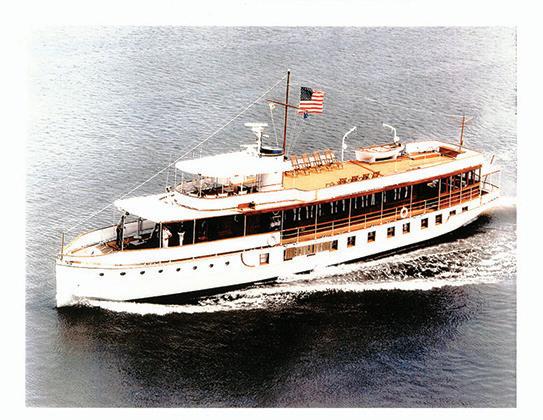
Miss Simmons of Cambridge and Miss Noble from Caroline County. After the ribbons were snipped, then came a parade of hundreds of cars crossing the bridge from both directions.
The president’s yacht made a U-


turn back through the bridge and anchored at Long Wharf as the Cambridge Rescue Fire Co. and local American Legion Post No. 9 bands played. President Roosevelt gave a short speech from the bow. The reviewing stand built there specially for the occasion held 700 people, and it was filled to overflowing. Navy sea planes and National Guard units were in attendance and added a touch of pomp.
President Roosevelt began, “Governor Nice and my friends. I didn’t come to make a speech, but to take part in a little ceremony largely because of my friendship for a neighbor of yours, George Radcliffe.
“About fifteen years ago, when I first was associated in business
C. ALBERT MATTHEWS

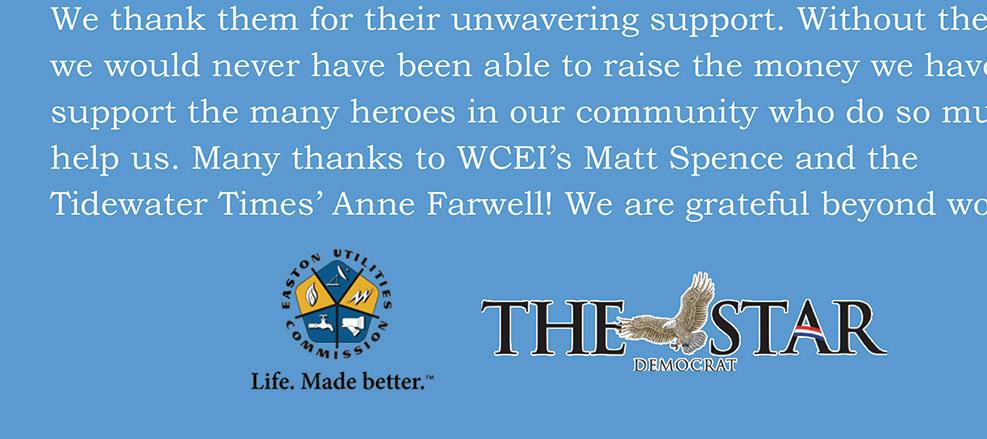
Choptank Bridge
with him, he began talking to me about the need for a bridge at Cambridge. When I first went to Washington and helped in building this bridge, I was very happy.
“I am told by Senator Radcliffe that no President ever before has visited Dorchester County. If I have a chance I am coming over here to visit again to visit you during my term” (Easton Star Democrat, Nov. 1, 1935).
The speeches were broadcast over the radio on the Blue Network.
President Roosevelt did not leave his yacht at this time. He immediately returned to the White House and was never able to make that promised return visit.
Many hundreds of cars from states as far away as Delaware, Pennsylvania, New Jersey and New York packed into the area from morning until night, and the police and Boy Scouts had their hands full directing traffic. The Red Cross also set up a tent. The
ladies of Trappe had a booth at the entrance to the bridge where they sold sandwiches and coffee. That evening, there was a banquet and dance at the Cambridge Armory. It was the biggest event Cambridge had ever seen.
Folger McKinsey, Maryland’s poet, even wrote two poems in honor of the new bridge:
THE CHOPTANK BRIDGE by The Bentztown Bard (Folger McKinsey)
Cambridge to Trappe in a jiffy, Draw is down, let us away! Over the noble broad water, To Talbot and back like a ray:
Binding the Shore with a tether Of brotherly love, it is fine To cross the old Choptank and hurry Through Kent and through Cecil divine.
Smart little Trappe is so pretty, So natty and chipper and slick, With its spirit of progress exalted
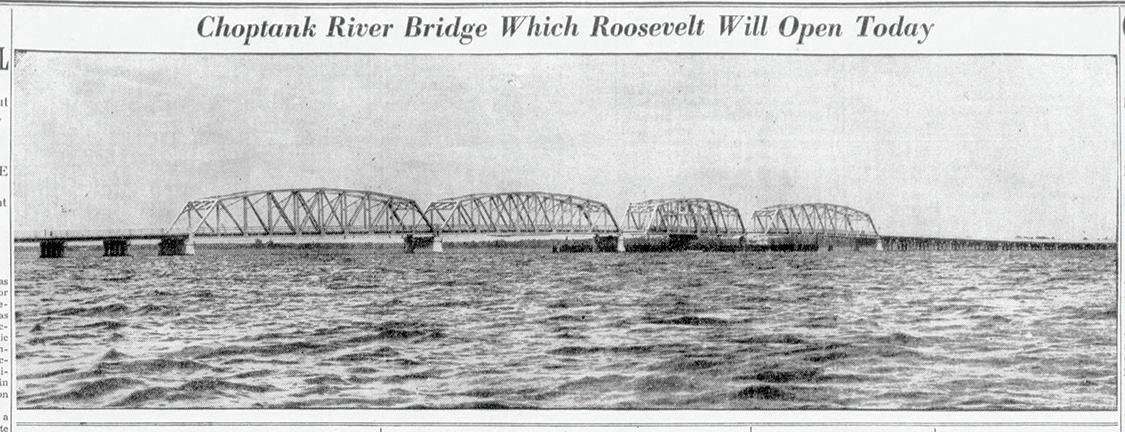


Choptank Bridge
And ready to meet every trick:
From Dorset the flivvers are flying Through Talbot they skim on the trail;
And the bridge-look away in the distance
Where the light falls on many a sail!
Oh! wonder of water and meadow, And peace of the old Maryland scene, With that span o’er the width of the river
And the roll of the Choptank between:
Come Dorset, come Talbot, come Cecil,

Come sisters of peace, one and all, For a handclasp of love o’er the distance
Where the dreams of old Maryland call!
[Baltimore Sun, Nov. 2, 1935]
and this excerpt from the second:
THE CHOPTANK BRIDGE
by Folger McKinsey
“…This noble structure, how it glows
Above the water where it flows In stately width to rush away Into the blue arms of the bay! Wild ducks, an oysterman near by,
A white cloud sailing in the sky, And yonder on the shoreline seen Green woods and fields of living green…”
[Baltimore Sun, Mar. 27, 1937]
The Dorchester approach was by the new Sunburst highway near Cambridge. Then there was also the new stretch of road from the bridge north to Main Street in Trappe. This became Rt. 213, which was rerouted down through Easton to Trappe over the old 1915 paved road to the new Choptank bridge to Cambridge. Rt. 213 had previously gone east over the Choptank at the other Choptank Bridge at Dover and then points south. Trappe, Easton and Wye Mills saw an influx of traffic that was 24 hours a day, 7 days a week.

Choptank Bridge
“INSOMNIA
HOVERS OVER TRAPPE AFTER CHOPTANK SPAN OPENING,
the sudden influx of cars funneled through the town’s narrow main street, but residents and their pets were plagued by the inconvenience.
Talbot County
Back-Country Town, Now on Main Highway Jittery As Thousands of Vehicles Move Through Main Street…” [Baltimore Sun Oct. 30, 1935].
Main Street Trappe was now on the main route to Cambridge, Salisbury and Ocean City, so traffic in town tripled. The jam of cars from all parts of the country on the first day would be a mixed blessing and a hint of things to come. Trappe merchants were delighted with
In the 24-hour period between midnight Saturday, August 29 and midnight Sunday, August 30, 1936, the bridge tenders counted 5,224 vehicles, and the bridge was opened for boat traffic 12 times. Main Street Trappe wouldn’t calm down until a new short section of Rt. 213 (soon renumbered to become part of the new Rt. 50) bypassed the town in 1940. According to some, this would send the town back into its insomnia-like trance for the next sixty years. The two-lane Rt. 50
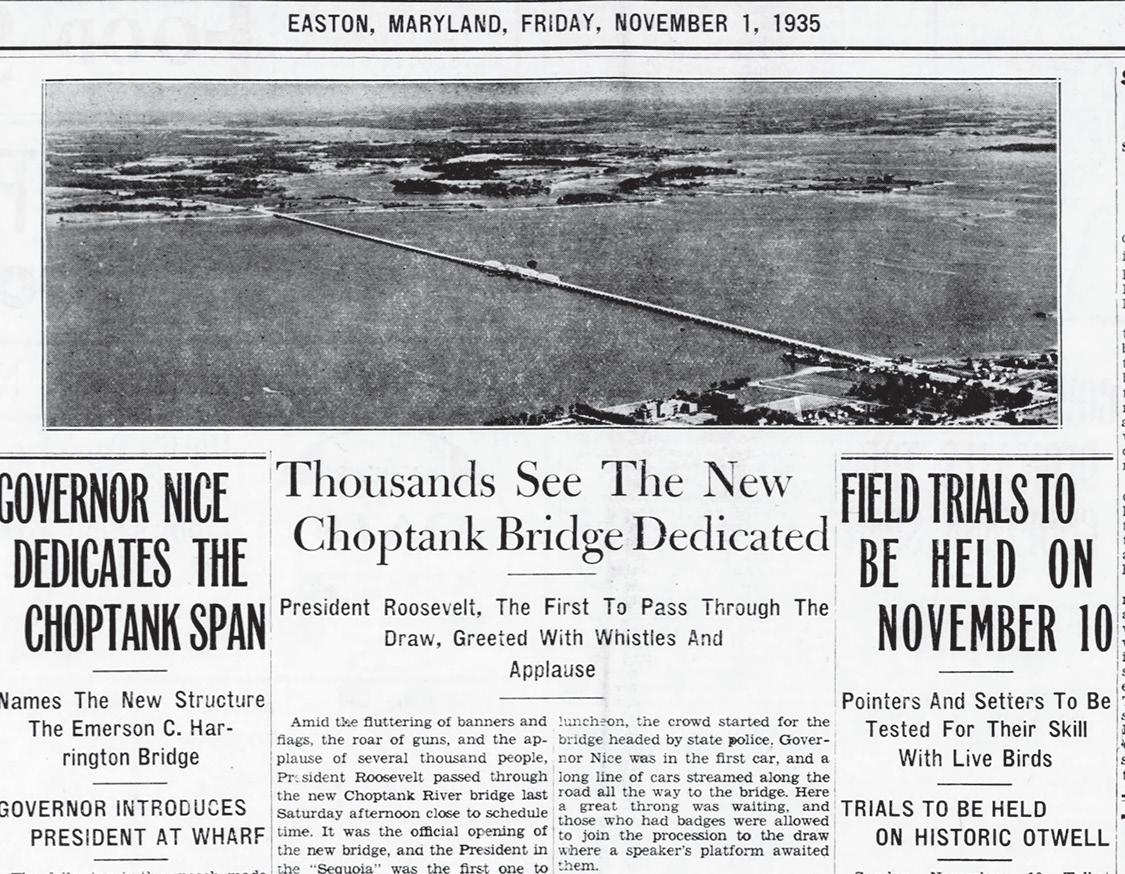
to the new two-lane Gov. William Preston Lane Memorial Bridge over the Chesapeake Bay Bridge opened in 1952, at which time the Chesapeake Bay ferries were closed. At about 4 miles long, it now took the crown as the longest bridge in the state and was the longest continuous steel over-water span in the world.
Mr. Bowdle Highley’s bold new enterprises inspired by the Choptank bridge traffic would be a bathing beach, Hi-Le harness racing track and, later on, a liquor store. The liquor store sign said Last Chance Liquors when you were heading from wet Talbot into dry Dorchester County, and First Chance Liquors for thirsty traffic

that was heading from dry Dorchester into wet Talbot. Highley’s bathing beach soon closed because its skinny beaches and usually placid Choptank River could not complete with the pounding surf, amusement parks and wide beaches at Ocean City, but the liquor store stayed in business for years and doubtless made boatloads of money. Gambling and drinking! Interesting enterprises for the son of a Methodist minister.
As the Easton Star Democrat had predicted in 1935, traffic kept increasing. Rt. 50 became a fourlane dual highway in 1962. This was great for Talbot County, but the traffic still had to funnel over the old two-lane Choptank Bridge,
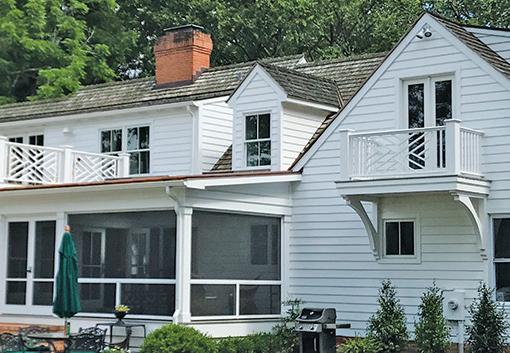













which made for increasing backups for summer beach traffic. The old two-lane Emerson C. Harrington bridge was replaced with the fourlane $40 million Frederick C. Malkus Jr. bridge in 1987, which has no spans, is higher and does not need to open for boat traffic. With its swing span removed, the old 1935 bridge would see a new life as the Choptank River Fishing Pier, renamed the Bill Burton Fishing Pier State Park in 2010, but which would be closed in 2022 because its aging concrete was crumbling. Hopefully it will be repaired and reopened someday. Bill Burton had been the outdoor writer for
the Baltimore Evening Sun for many years. The second parallel Chesapeake Bay Bridge opened in 1973, bringing even more traffic, and now there is talk of a third Bay Bridge or maybe even a ferry to be put somewhere, but no one can quite agree just where.
Malkus (1913-1999) served 48 years as a Democratic state legislator who never lost reelection and was the longest serving legislator in the U.S. on his retirement. He also became the first living person that a bridge was named for. Malkus was actually born in Baltimore City but moved to Dorchester County when he was 3, and so technically he was a “come here,” not a “from here,” though he was one of 200 Dorches -

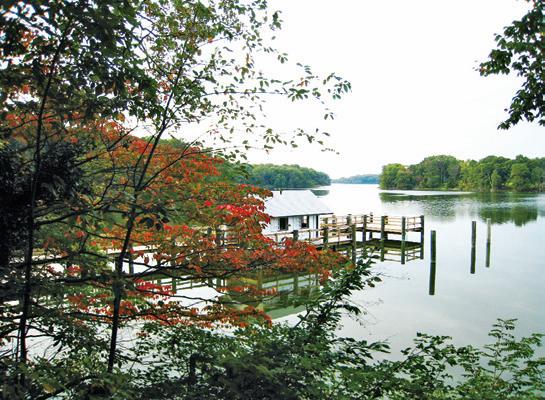
ter countians to have worked on the Harrington bridge. Recently, there is a move to rename the Malkus bridge because of his stand against desegregation.
The old Rt. 213 route to the beach down from Cecil County had been called the Shore Boulevard, which implied a picturesque drive through the country. The two-lane Rt. 50 was touted as the Main Street of the Eastern Shore for all the commerce it would bring. However, when Rt. 50 became a dual highway, it was now the Ocean Gateway: the fastest way to reach the beach, and Easton, Trappe, Cambridge, Salisbury and other towns were doubtless just annoying red lights along the way for those racing to the beach.
And finally, for one more Choptank River anecdote: Brice Stump tells about when some 155 years after Rev. Coke’s wild ride, a teenaged Beatrice Frankel, whose father owned P. Frankel’s women’s clothing store in Cambridge, wrecked her father’s shiny silver Packard automobile on the bridge. She survived and, after a short hospital stay, somehow later made it to Hollywood, changed her name to Bea Arthur and starred in such T.V. hit comedies as “Maude” and “Golden Girls.“ Supposedly she never showed her legs because of all the scars from the accident, however she did have a scar on her chin. Rev. Coke wasn’t the only one to
have had a close call while crossing the Choptank River.
Postscript:
The Sequoia served several more presidents until she was finally retired during President Carter’s term in 1977. The Sequoia is now back in Cambridge, under wraps at the Richardson Maritime Museum awaiting restoration. For more about the Sequoia , see A.M. Foley’s article in the August 2024 Tidewater Times .

James Dawson is the owner of Unicorn Bookshop in Trappe.

Serving Caroline, Dorchester, Kent, Queen Anne's & Talbot Counties
The Mid-Shore Community Foundation connects private resources with public needs in order to enhance the quality of life throughout the Mid-Shore Region. We provide tools that enable donors to easily and effectively support the causes they care about - immediately or via bequest.
102 East Dover Street Easton, Maryland 21601 410-820-8175 www.mscf.org


Mid-Atlantic Symphony Orchestra
Honors National Arts Leader
Deborah Rutter and Conductor
Julien Benichou with Legacy Awards
In June, the Mid-Atlantic Symphony Orchestra (MSO) honored two major cultural leaders with its 2025 Legacy Awards at a soldout Gala Dinner in Easton, Maryland. Now in its 27th year as the regional professional orchestra of the Delmarva Peninsula, the MSO presented its National Legacy Award to Deborah Rutter, immediate past president of the Kenne -
dy Center for the Performing Arts. Its annual Legacy Award went to Maestro Julien Benichou, past music director of the Mid-Atlantic Symphony Orchestra.
In presenting the awards, MSO Chairman Jeffrey Parker stated, “Deborah Rutter has inspired all of us in America’s arts community as the longtime leader of our national arts center, and Julien
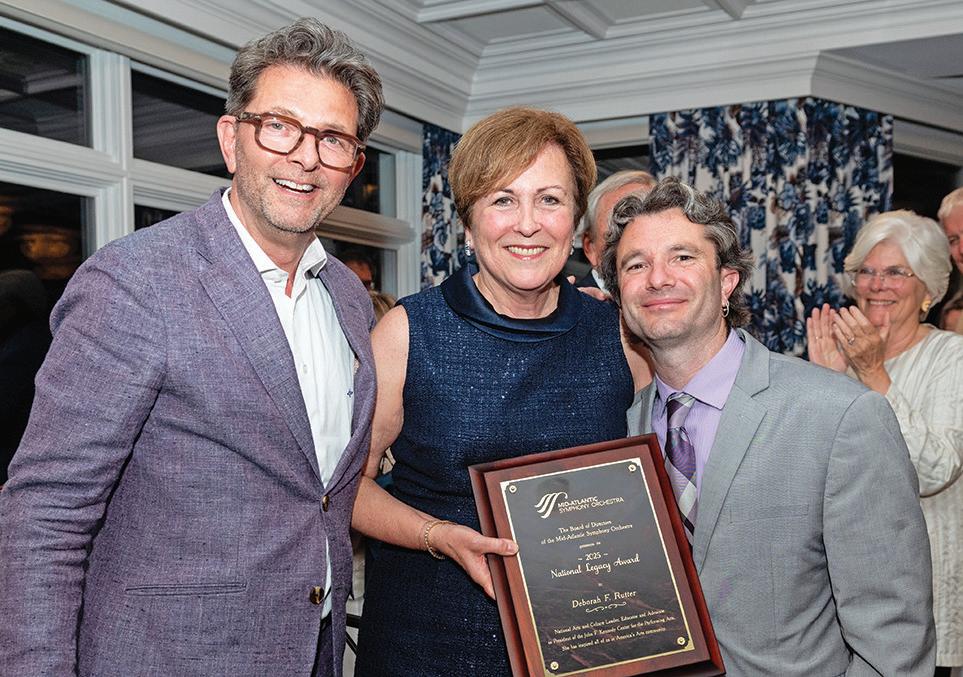
Benichou dramatically raised the professional quality of our orchestra and expanded its season and its supporter base.”
Deborah Rutter, in her 11 years heading the Kennedy Center for the Performing Arts, has provided the nation with leadership across the broadest range of the arts, including arts education, multidisciplinary arts training, support and enrichment; and symphonic music, opera, theater, contemporary dance, ballet, vocal music, chamber music, hip hop, comedy, international music and jazz. She oversaw the Kennedy Center’s first physical expansion with
the REACH, which opened in September 2019, and transformed the Center’s mission into one inclusive of diverse art forms. In 2022, she conceived and opened the permanent exhibit Art and Ideals: President John F. Kennedy. Rutter previously served as president of the Chicago Symphony Orchestra and held leadership roles at the Los Angeles Chamber Orchestra and Seattle Symphony Orchestra.
Julien Benichou served for 17 years as music director and conductor of the Mid-Atlantic Symphony Orchestra, transforming it from a community ensemble into a fully professional orchestra. Appointed in 2004—under the leadership of then-board presi-




















dent Andrea Barnes—Benichou was quickly embraced by the MSO community, including early patron Lucienne Wolf, who supported him like family.
Under his charismatic leadership, audiences across the region grew steadily—not only for the music, but to experience the energy and warmth Julien brought to the podium. He worked tirelessly alongside the MSO Board to expand performances across the Delmarva Peninsula, including outreach to Rehoboth Beach and the creation of the now-beloved Toast to the New Year concerts, which will celebrate their 11th season this December.
One of Julien’s long-held dreams became reality in 2019 with the founding of the Elizabeth Loker International Concerto Competition (ELICC). Despite a brief interruption due to COVID-19, the competition has become a central feature of the MSO’s season.
In 2020, while most orchestras suspended operations, Benichou— together with MSO leadership— rapidly developed the “Season of Strings,” safely performing at the Church of God in Easton and livestreaming every concert to continue serving audiences during the pandemic.
Julien also led the MSO in special performances at the Embassy of France in Washington, DC, and in collaboration with the Wash -

ington Opera Society. His 17-year tenure left a profound artistic and organizational legacy. It is not an overstatement to say that the MSO as we know it today owes its very existence to his leadership. In 2024, he was knighted by the Ambassador of France with the title Chevalier de l’Ordre des Arts et des Lettres.
Deborah Rutter, in her keynote remarks, emphasized the need to “continue to support the artist wherever they feel welcome, supported, empowered and unencumbered to share their art and express their creative talent.” She called on artists and leaders alike to embrace their roles as citizen artists, a concept she co-devel-


RL Americana + (Made in America) to trade only bed linens
Basketweave chaise
Poured Glass pendants & Impressionist ‘Branches’ rug, custom, fair trade, made in Nepal.
Live Your best life…
Utilize Our expertise!
Traditional, Transitional, Modern, Luxe
Elizabeth Kelly CID, NCIDQ

oped with Yo-Yo Ma during her time at the Chicago Symphony Orchestra, advocating for artists to engage deeply with their communities and to consider the broader impact of their work.
The Legacy Awards Dinner featured a performance by the MSO’s principal string musicians, remarks from music director Michael Repper on the future of the orchestra, and a lively auction that included a chance to conduct the MSO at its 2025 Holiday Joy concert, a private plane excursion over the Chesapeake Bay, an eight-day European Viking cruise, and a private dinner for eight with celebrity chef Jordan Lloyd.


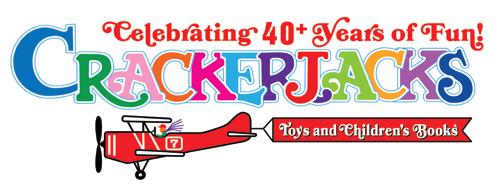



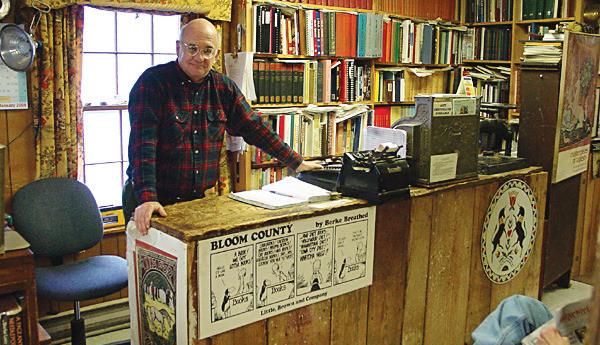
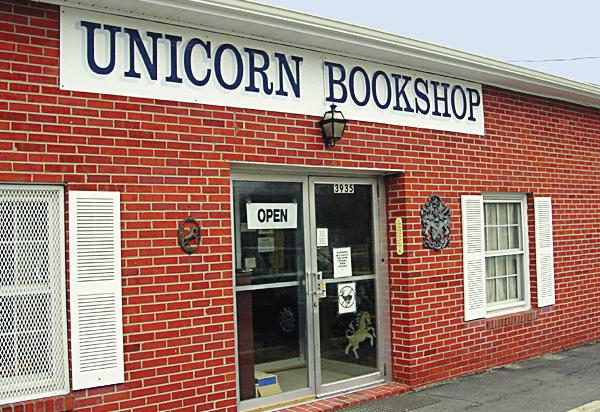






All Quiet on the Sound A novel by
B. P. Gallagher
Chapter 23:
Almost Quitting Time
Worry gnawed at Earl in the hours that followed, a chorus of paranoid whispers that dogged him throughout the day and crescendoed as night fell. He couldn’t sleep for their caterwauling. In waking nightmares, he was accosted over and again by thoughts of what other sunken secrets this dismal changing of seasons might dredge up. A restless spring
threatened, a season pregnant with swollen clouds and unshed tears, slick with night sweats. The thought of another month, week, day, even, in this purgatory was unbearable. If one final outing could spell an end to it, why not dispense right away with the torturous wait? Tonight was the night, he decided, for better or worse. He prayed it was for the better.
The moon was a fresh, waxing
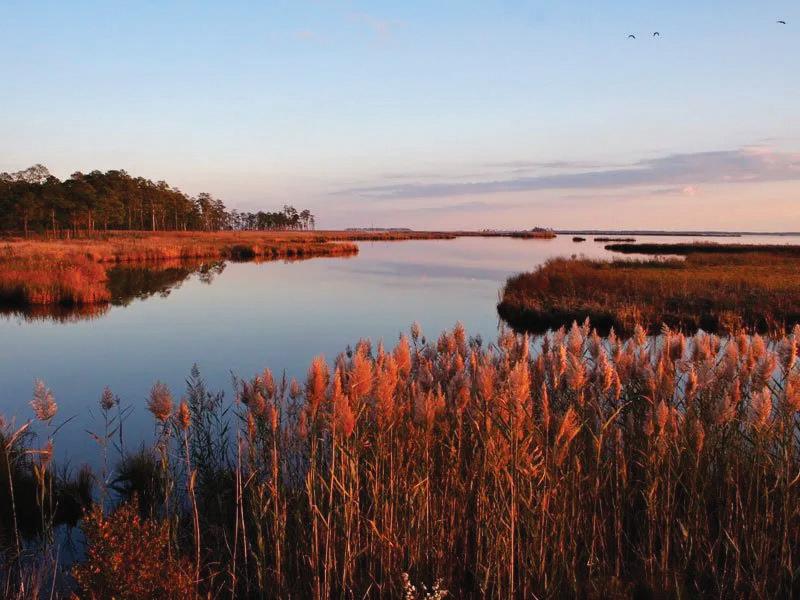
sliver over the Sound, still in its first quarter. Its modest light would be enough to go by for now. Later, when it came time to light a lantern, the glare wouldn’t matter so much. It would, in fact, be the whole point.
Earl couldn’t stand lying abed staring at the ceiling for another moment. Time to be off. Donning his clothes, he slipped from his room and padded down the hall in socks as not to rouse Maggie or Dougal. In the foyer he wavered, weighing the relative merits of boots and oilskins. The boots were less bulky, which might come in handy for what he had in mind, so he chose those. But the hesitation came at a cost. He was halfway out the door when Leon emerged from his room, swaying with exhaustion or drink or both.
“Where the hell d’you think you’re going, this time of night?”
“Out,” Earl whispered.
“Like hell you are! What for?”
“I gotta do something important. Best you don’t know what for.”
“Bull!”
“Shh. It ain’t bull.”
“If it’s so important, then I’m comin’ with you.”
“Like hell you are,” said Earl, turning his brother’s words against him. “And keep your voice down! Next thing you know, Maggie’ll wanna come, too.”
“Maybe I should talk louder, then!” Leon’s volume suited his
words. “We’re supposed to be in this tog—”
Earl seized his brother by the wrist and clapped a hand over his mouth. He pushed Leon onto the porch and shut the door behind them. “This is for me to do, alone. Hear me? If you or Maggie come with me, it defeats the whole purpose.”
Leon shoved Earl’s hands away, looking hurt. “We’re supposed to be in this thing together, brother. C’mon, just bring me along. Whatever it is, I can help!”
Earl shook his head. “No, Leon! How many times I gotta say it? I need to go alone.”
“This wasn’t the plan, Earl!”
“The plan!” Earl barked a humorless laugh. “When has any part of this gone to plan, Leon? God laughs at our plans, and I bet Tyler Calhoun does too. Plotting with one another’s just a liability now, another thread for them to entangle us with. They wanna snare all of us, and you coming with me now just hands them a bigger net! Don’t you get that? You don’t know where I’m headed or what for, and that’s how it’s gotta stay.” Earl barely knew himself, tending the seed of an idea to fruition.
Finally Leon seemed to understand, though it was plain by the set of his shoulders that he didn’t like it one bit. That was fine, Earl didn’t expect him to like it—only to listen to reason. “Alright then, I guess I gotta trust you. Just don’t do noth-
in’ I wouldn’t do, okay?”
“I won’t,” said Earl, completely truthfully. This would, in fact, be the foolhardiest, most Leon-ized stunt he’d ever pulled in his life. “And you better not follow me, neither.”
With a grunt of reluctant assent, Leon disappeared inside.
Earl was crossing through the yard that separated the Higginses’ property from the Gibbses’ when the back door to the Gibbs house creaked open.
Oh, what now? I ain’t got all night for this.
“Leon? That you?” Clara. Must have caught sight of him passing by her bedroom window and mistaken him for his brother. If she’d snuck
out for a moonlit rendezvous, she’d be disappointed.
Earl considered dashing off, but he didn’t want to risk her following him. So, he turned around and let her see him in the moonlight. Clara froze, realizing her mistake. Hard to make out in the dark, but Earl thought he saw her cheeks flush. “Better head inside, Clara. You’ll catch a chill.”
“What’re you up to, Earl? It’s late.”
“Nothin’ to concern yourself over, just couldn’t sleep. Thought I’d take a walk.”
“Oh. I thought you were… y’know.”
“Figured. It’s alright.” He turned away.

“Wait!”
“What is it? I gotta get going.”
“What’re you in such a hurry for? I thought you were just going on a walk.”
Earl, irked and unnerved by the repeated intrusions, bit back a snappish reply. “I am. It’s been a long day and I’m eager to be off alone, I guess. Sorry.”
Clara cocked her head to one side and examined him in the moonlight, clearly unconvinced. “If you say so. But before you go, I just wanted to tell you I appreciate what you and yours have done for me…” Earl’s breath hitched in the pause, but she went on, “Making me feel like part of the family and all. It’s been hard being on my own since Pop Pop passed. He’d be happy to see I’m surrounded by folks who take care of me like y’all have.”
“Thank Leon for that,” said Earl brusquely. “And Maggie.”
“Oh, I have, and I will. And I thank you too, whether or not you want my thanks. The point is, seeing all those shriveled up skeletons today made me realize how stupid it all is.”
“Oh?” said Earl, off-balanced by this nihilistic bend. “All what?”
“This whole feud with the Calhouns.”
“How d’you reckon?” He asked it casually, cautiously. In his mind’s eye, brittle ice cracked underfoot.
“Because it’s all such a big waste!
All this pain and plotting and paranoia, and for what? Do the dead care what’s said or done on their behalf? No! Loved or hated, once we’re dead, we all rot in silence the same. Forgotten, except by the people who loved or hated us the most. It’s their job to rifle through the evidence we leave behind, all the memories of love and happiness, pain and strife, and sort out how we’re remembered. Most of the time everybody comes to their own separate conclusions anyways, and most of them are bound to be dead wrong. And you know what? The dead don’t care a lick about any of it!”
“…I guess I see your point.”
“Do you?” She stepped closer to him. Her tone was pleading, and Earl was alarmed to see tears brimming in her eyes like opals shining with reflected moonlight. “Because none of it’s fair! Men who leave behind unspeakable pain and misery for a few are lionized, while virtuous men are loathed as villains in the same backwards proportions! And who has to deal with it all, for better or worse? Not the dead! We can’t any more curate our legacies from the grave than cage them. They’re the overgrown gardens we leave behind, the beasts set free at the hour of our deaths for our heirs to wrestle with.”
“Uh, yeah.” Earl was taken aback by the intensity of her words, the stricken expression on her pale face. “I guess that sounds about right.” It was all a little over his head, in truth.
“So.” She nodded as if satisfied, like she’d come to a decision. “Do what you need to do, then. Whatever it is, I’ll help however I can. I just want this to be over with, for all of us.”
“Sure, Clara,” he said, still processing her words. Could she really be saying what he thought she was? “Um…Thanks.”
“Good luck on your walk, Earl.” She went inside, and he continued on his way.
The exchange left him distinctly uncomfortable. Again he wondered how much she knew. It occurred to him that he may have underestimated Clara Gibbs, just like he’d underestimated Maggie’s appetite for violence—and vengeance. What
other misreads and missteps might he have made along the way? Was he making one right now?
He wondered as he walked past the cemetery, where settling mounds marked the locations of reburied coffins. Some of those likely now contained the bones of more than one individual. In the mud, all bones look much the same; it’d been hard to identify in the most scattered cases whose were whose. Earl could see from here that some of those bestirred graves were in the Higgins plot. He didn’t care to look which family members they belonged to, having been spared the knowledge throughout the day.
Robert Gibbs rested in one of those graves. His coffin, buried

deep, hadn’t arisen in the floods. How would he rest after tonight? For that matter, how would they prevent the graves from reopening again with the next deluge? Earl didn’t know, couldn’t afford to get distracted thinking on it now. He hurried across Moore Island.
It was a quarter past midnight, and his neighbors’ homes were dark. In some, perhaps, the restless elderly sat up in the night. Maybe some, seeing his silhouette pass, spied from their windows. Earl walked on at the same speed regardless, watchful for signs of pursuit in case Leon decided to tag along after all. As for the others, let them look. It didn’t matter if they saw him now, so long as no one tried to stop him.
Earl made his way to the docks, boarded the Marylou, and retrieved Mr. Gibbs’s toolbox and its weighty contents from her cabin. Then it was back across the island in the same businesslike strides to the boatshed, where the rowboat had lain beneath its musty cover for too long. Using the deadrise remained something of an enjoyable novelty, if not a particularly new or shiny one. But for this outing, the small, quiet boat best suited Earl’s needs. Besides, he didn’t want to risk the Marylou if things went south…or even if all went according to his half-baked plan.
Tonight, he would play the role of
quitting-time crew. A final distraction, just as the Calhouns and the sheriffs were readying to pack it in and haul all three Higgins siblings before a judge on murder charges. Earl meant to make it a flashy affair, which was why he must go alone. Savvy waterfowlers kept an eye out and a gun on hand for late arrivals—Deputy Calhoun would also. In Earl’s experience, the birds in a quitting-time crew ended up bagged often as not.
Getting the rowboat in the water was harder than it would’ve been with a second pair of hands, but Earl managed. Shortly he rowed onto the Sound with an unlit lantern, a coil of chicken wire, a tackle box, and the Geezer’s toolbox in the foot of the skiff. The young moon offered limited visibility, and the Sound was choppy enough to make Earl nervous in the little rowboat. But he’d endured heavier seas in this very boat, and venturing out in this weather would only strengthen his desperate charade.
He waited until he reached the mouth of Fishing Bay before sparking the lantern. The kerosene flame hissed alight with an eager, Judas life of its own. What a treacherous beacon it seemed! Someone would see it, and he would be caught! His heart hammered, breath quickening at the possibility. Every instinct told him to snuff the lantern out, throw it overboard if necessary, but he resisted the self-preserving urge. Let








them see, let them come. That was the point. The Oyster Police would be out tonight, no doubt.
Sure enough, the grumble of a distant boat motor soon joined the slap of the oars against the water and the serpentine hiss of the oil lantern. Earl heard the police boat long before he saw her, and likely long after her crew spotted his kerosene flame bobbing out on the open water. She was out of the east, where she’d likely been keeping watch over the convergence of the rivers and bay. Now she made a beeline for Fishing Bay. By then, Earl had snuffed out his lantern and begun rowing west for all he was worth. When he reached the Hooper Strait, he relit the lantern. He was panting from the effort of putting so much water between himself and the patrol craft. The police boat slowed as it sought his rowboat, lights moving on her deck as her crew walked from aft to stern.
While Earl waited for them to notice him again in the distance, he uncoiled the spool of chicken wire and wound it around the handle of the toolbox. Taking the long ends of the wire in hand, he twined them together, then kicked open the tacklebox and began threading fishing weights onto the doubledup wire by lanternlight. When he ran out of weights, he redoubled the twisted wire to form a long,
weighted loop, its ends secured to the handle of the toolbox.
From the direction of Fishing Bay, a motor coughed back to life.
“C’mon, you bastards,” said Earl. “Come and get me.”
When it was clear the police boat was following, Earl snuffed out his lantern once more. Filling his lungs with cool March air, he took up the oars for a third and final push. This would be the tricky part. To pull off the ruse he had in mind, he needed to make a convincing show of hiding the toolbox and its contents without making them irretrievable. Counting on the competency of local law enforcement was a chancy bet, but it was the best ploy he could think of.
He rounded the northern point of Bloodsworth Island beneath the beacon glare of the Hooper Strait Light and turned south, where the broken shoreline shielded him from the watchful beam. The rowboat bumped over black shallows and mud shoals, entering a cove where once pirate sloops anchored while their crews hid out ashore. Some said Bloodsworth was where the buccaneers used to bury their treasure, but if anyone had ever found any there, Earl hadn’t heard tell of it. The association might lend itself to the picture he was trying to paint for the local constabulary, however, which was in small part why he’d chosen it.
In the center of the cove, he lit the lantern a final time and waited until
he heard the motorboat approach up the Hooper Strait. Fighting off another well-meaning, self-preserving impulse to flee, he let the kerosene burn. He felt like a man making the worst mistake of his life—which he might well be. At the last instant before the shadowed silhouette of the police boat rounded the point, he extinguished the lamp yet again. His eyes were slow to acclimate to the moonlight. Somewhere in the disorienting dim, the boat engine sputtered indecisively as her crew studied the cove where his light had flicked out seconds ago.
By now Earl guessed it was around three in the morning. As fine an hour for devilry as any. He uttered a silent prayer, then picked up
Robert Gibbs’s weighted toolbox and heaved it overboard with a tremendous splash. It sank fast, chicken wire noose disappearing underwater last like the tail of a submerging creature.
Next he knew, the patrol boat was roaring towards him. Men shouted at him from her deck, “Maryland Oyster Police! Drop anchor and prepare to be boarded!”
They might as well have told him to drop trou.
“Drop anchor? Board? I’m in a rowboat!” said Earl, incredulous and, thanks to their upraised lanterns, blinded again. Time to sell this damn thing. Shouldn’t be too hard to convince them he was a fool, should it? He was fairly convinced of it himself.
Easton Maryland Dental

Alvan Holston, DDS, Andrew Barnes, DDS and the team
“Stay right where you are, then! We’ll raft up to you. And don’t think of tryin’ any funny business either, hear? One shotgun blast below the waterline and you’re sunk.”
The Oyster Police boat sidled up to him. She was crewed by a pair of hard-faced men, one of whom held a shotgun. “Care to tell us what you’re doing out here, stranger?” he said. “Awfully late to be out on the water, ain’t it?”
Earl didn’t have to pretend to flounder for an excuse. He hadn’t thought this far ahead beyond the broadest strokes. What was he doing? This time of year, he couldn’t claim an early start to a duck hunt, and most watermen wouldn’t be heading out for a couple hours yet. So he went for the low-hanging fruit, dubious as it seemed. “Night fishin,’ officers, that’s all.”
“Night fishin.’ huh?” said the man not holding the shotgun. He planted a foot on the gunwale of the patrol boat and raised his lantern for a better look at the rowboat’s contents. “Where’s your rod?”
In a fit of inspiration, Earl threw up his hands and said, “You tell me! I had something big hooked up ’til a few moments ago. Towed me all the way ’round the point there before whatever it was got the best of me and hauled the goddamn rod outta my hands! Nice rod, too. I been looking for it ever since.”
“Oh, I’m sure you have,” said the man with the shotgun. “Sounds like the makings of a fine fishing tale.”
“You’re tellin’ me. But it’s true.”
“Sure, sure.”
“What’s your name, fella?” said his partner, cutting through the bullshit.
Earl took a deep breath, gathered himself to sell the charade. “Higgins,” he said, and was pleased to find that his voice didn’t waver. “Earl Higgins.”
The man with the lantern squinted at him. “Earl… Ain’t that the name they been feedin’ us down to the sheriff’s office, Willy? What’s it again—Hibbs, Higgs?”
“Higson. Gibbs was the other one.”
“Higgins ,” Earl said. So they are taking a look at Clara. Or her Pop Pop. Good to know.
“Higgins , that’s it! We’re gonna have to take you in, I’m afraid.”
“Take me in?” said Earl, projecting outrage. “What the hell for?”
The lantern flame danced as the patrolman shrugged. “Trespassing, that’s what. You ain’t supposed to be out here, ’specially this time of night.”
“No trespassing here, officers, just bad luck! I told you, ain’t my fault I got drug in here. I was ’bout to head home when you showed up.”
“Alright then slick, try littering! You already admitted to tossing
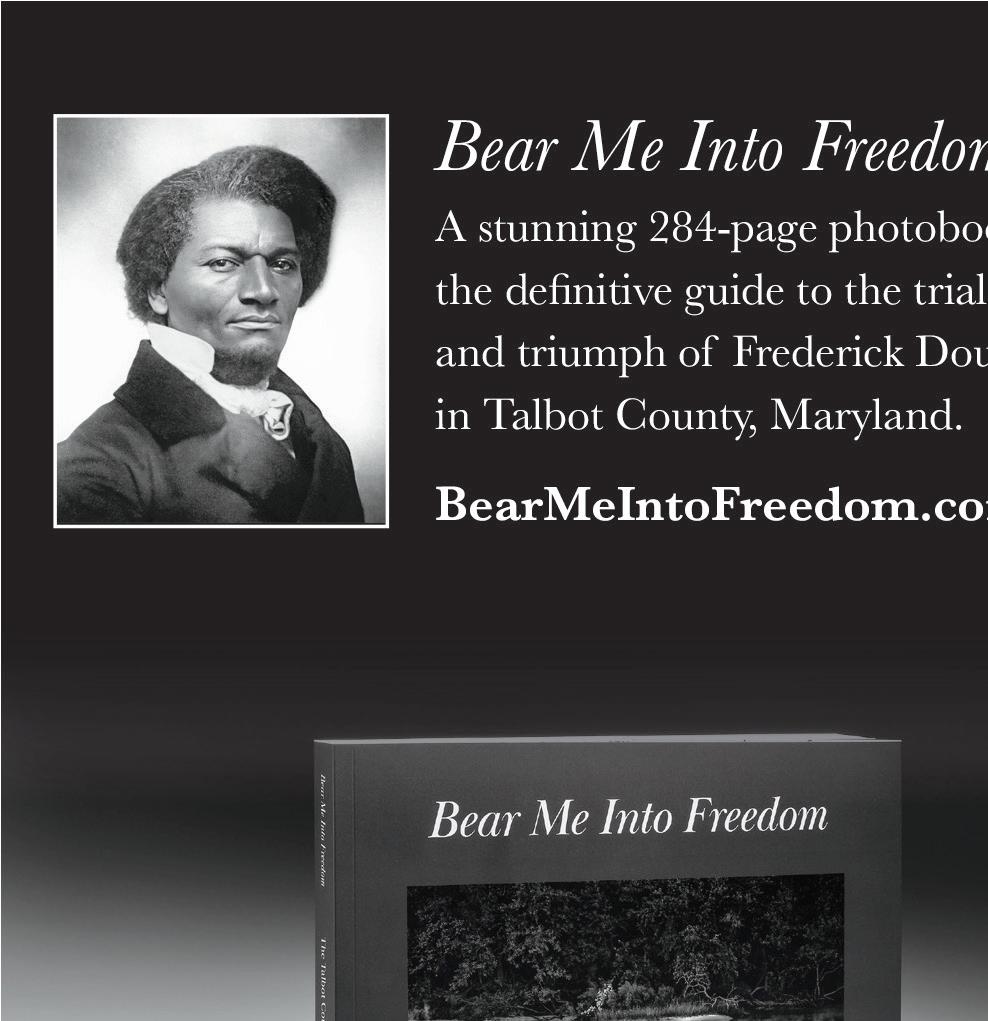

something overboard.”
“Since when is losing a fishing rod littering?”
“Didn’t sound like a fishin’ rod to me,” said shotgun Willy. “Sounded a lot heavier’n that.”
“I told you. It was a big fish.”
“Either way, you’re the one’s responsible for keeping foreign objects outta the water!”
“You’re gonna take me in on that?” said Earl. It occurred to him that he was calling attention to the flimsiness of his own excuse. “It’s the middle of the night, for Chrissake!”
“That’s just the point, ain’t it? Ain’t much reason to be out this time late as I see it, unless you’re up to no good or looking for folk who are. I don’t believe for a moment you were fishing.”
“Search me, then! All I got is a tacklebox and a light. Helluva thing to book a man for.”
The lantern flame wavered. “Maybe so, and maybe that’s all you got on you now. But I bet if we root around this cove long enough we’d find something to book you on, wouldn’t we?”
“I guess you’re just gonna have to find out,” said Earl, managing a passable veneer of smugness, “but you’ll get no help from me while you do.”
“That’s okay, Mister Higgins. I imagine you’d only get in the way anyhow. So how ’bout you head on
home, like you said?”
The lantern swung away from Earl’s face as the other officer addressed his partner. “Screw that, Willy! The sheriff wants him!”
“The sheriff wants something to hold him on, Tom, which we ain’t got yet. Plus, d’you wanna deal with towing his skiff all the way back? I sure don’t.”
“So you’re just gonna let him go?”
“I’d say we got to for now. But don’t worry, Mister Higgins. We’re gonna do some rooting around here, and when the time comes, we know right where to find you.”
“You wanna spend your night poking ’round for my fishing rod, be my guest. But if you’re gonna ticket me for littering once you dredge it up, then I want it back.”
The lantern swung back around so sharply it came close to guttering out. “I’ll see to it personally that whatever we find makes its way back to you, Mister Higgins. How’s that sound?”
“Mighty fine,” said Earl.
“What’re you waiting for, then? Get the hell outta here!”
Earl obliged, seized the oars with shaking hands and a pounding heart. He was thankful for this extended window of freedom, however fleeting. Had he pulled it off? By god, he thought he might have! A lot more easily than expected, too. Small wonder the chickens had taken so long to come home to roost. If he rowed hard, he might even be able to

Behind him, the lawmen peered into the water, searching for what he’d dumped overboard. Later, when they returned with dredges and long rakes to comb the bottom, they were bound to snag the toolbox and the weighty implications contained therein. By then, the other roughhewn pieces of Earl’s plan should be falling into place. Or so he hoped.
Elsewhere, a plan-mocking jester god burst into gleeful giggles.
unease that grew more pervasive the closer Earl got to home. When he saw the empty driveway, despair fi lled him. Where was Betsy?
Maggie and Clara met him in the yard to confi rm the worst of his fears. “Earl! Leon’s gone!”
Abruptly his window of reprieve slammed shut, all his efforts of the last few hours souring, maybe already gone to waste. Elsewhere, giggles turned to chuckles turned to cackles, madder and madder.

When he returned to Moore Island the tide was out, the sky brightening to the east. Yet the air stank of wrongness, rank with a sense of
Brendan Gallagher is a 2013 graduate of Easton High School and is currently finishing up a Ph.D. in Social-Personality Psychology at the University at Albany. manage a few hours of sleep before turning himself in come morning.

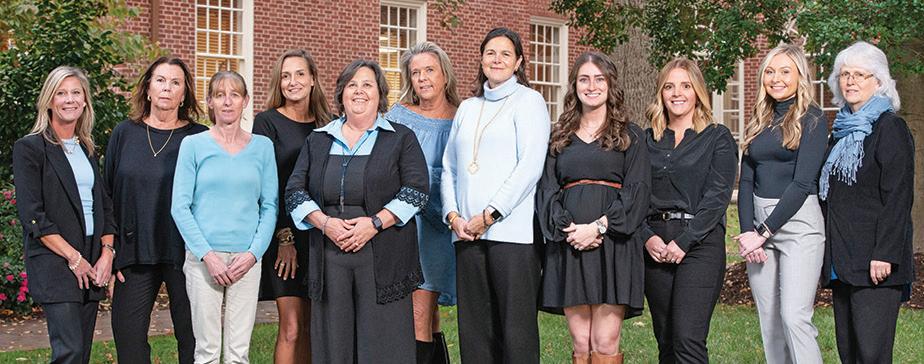
Melissa Grimes-Guy Photography





Chesapeake by Del Webb - Popular one-story beautifully maintained Wittman model. Great room with gas fireplace, dining room, spacious gourmet kitchen with large center island and breakfast nook, granite countertops and stainless appliances. Office with built-in bookshelves, primary suite, guest bedroom and hall bath, sunroom with tile flooring overlooking patio with pergola. Separate laundry room with sink and overhead cabinets. 2 car rear loading garage and additional driveway parking. Mature landscaping with irrigation system. Roof (2020), HVAC (2015). This is an active 55+ community with many amenities. $475,000
NEW PRICE

Chesapeake by Del Webb - Popular two-story Wittman model. Great room with gas fireplace, formal dining room, gourmet kitchen with 5-burner cooktop, double wall oven, granite countertops. Tiled sunroom leading to expansive paver patio with awning. First floor primary bedroom suite, guest bedroom and bath, office. 2nd floor loft, guest bedroom and bath. 2-car garage and irrigation. Roof, HVAC and appliances have been replaced. 55+ age-restricted section. Community amenities. $530,000


Chesapeake by Del Webb - McDaniel model. Living room, dining room, family room with gas fireplace, open gourmet kitchen with breakfast area, granite countertops, cooktop, double wall oven, sunroom, 1st floor primary suite with double vanities, jacuzzi tub and separate shower. 2nd floor loft, 2 guest bedrooms and bath and walk-in attic storage. Patio, lawn irrigation and 2-car garage. New roof (fall 2023). 55+ age-restricted section. Community amenities. $575,000





“RICH NECK MANOR”
Talbot County’s earliest colonial land grant. Over 300 acres with 175 acres tillable, and FOUR MILES OF SHORELINE on Tilghman Creek, the Miles River and the Eastern Bay..Incredibly beautiful sunsets. Dock and mooring with 9+ ft mean low water..Fully modernized 10,000 sq ft grand brick mansion built in 1824 with wing dating to 1740, 13 ft ceilings. Elevator. Chef’s kitchen. 3000 sq ft brick guest house, groom’s cottage, barns, paddocks, Threequarter mile tree-lined drive. Excellent waterfowl and upland game hunting, fishing and crabbing. High speed fiber-optic cable internet service available.. A magical estate located only 5 miles from St. Michaels. .View online drone tour, history and numerous pictures. $8,875,000. Available partly furnished. Call Robert Shannahan for details.
SHORELINE REALTY




